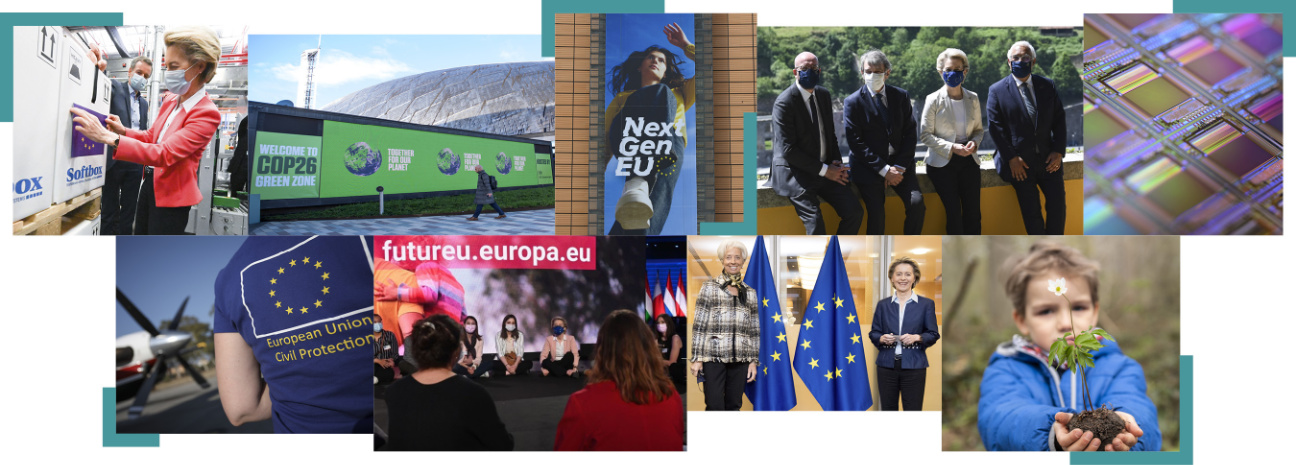Foreword
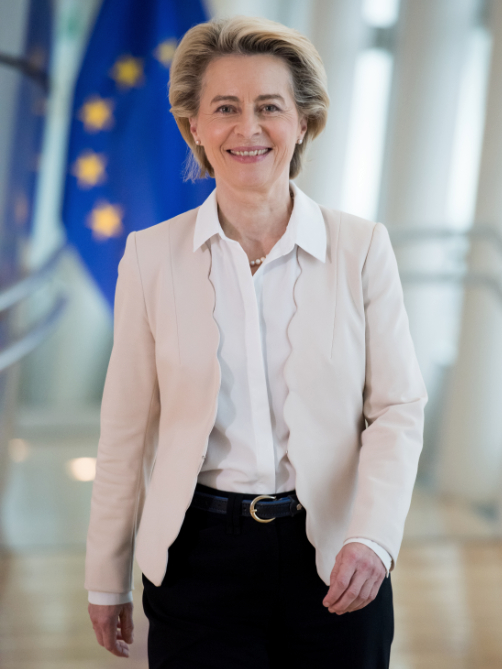
Ursula von der Leyen
President of the European Commission
I hope 2021 will be remembered as the year when Europe started to look beyond the pandemic towards a better future. The year when our Union procured vaccines for all its citizens. The year when economic recovery took off. The year when NextGenerationEU, our recovery plan, started making Europe a greener and more digital continent. We made significant progress in 2021, and this was only possible because Europe chose to go it together.
Vaccination has been a stepping stone. Thanks to the groundwork laid early in the crisis, not only did we make sure we had enough vaccine doses for all our Member States but we also exported or shared over 1.7 billion doses to countries around the world. At the end of 2021, the EU was the biggest donor of COVID-19 vaccines in the world. We will continue to share and export our vaccines, because we know that we will only beat COVID-19 if we fight it everywhere.
The Digital COVID Certificate that we introduced in time for the summer enabled people to travel across the EU, and has been taken up by over 60 countries and territories. It has helped the tourism sector, as well as businesses and cultural activities depending on it, to weather the effects of the pandemic.
In 2021, we also laid the groundwork to prevent future pandemics from catching the world off guard again. At the Global Health Summit in Rome, which I co-hosted in May, world leaders agreed on common principles to overcome COVID-19 and to prevent and prepare for future pandemics. We are already acting on the lessons from the pandemic. Our new European Health Emergency preparedness and Response Authority (HERA) will ensure we have the treatments and medical equipment we need when health threats strike.
As we tackled the pandemic and its fallout, we never lost sight of the goals we had set at the beginning of our mandate: we kept working to make Europe greener and more digital, and a place of equality and opportunity for all. NextGenerationEU has put these goals at the heart of the economic recovery. Billions of euros have already started flowing into our Member States, which have also put forward ambitious reform programmes to transform their economies. NextGenerationEU is investing not only in Europe’s recovery but also in its long-term prosperity – from digitalising our economies and ensuring Europeans have the skills needed for the jobs of the future, to putting in place the measures necessary to achieve our 2050 goal of climate neutrality.
Our new climate law, which turns our targets into legal obligations, will ensure we get there. In 2021 we set out the action we plan to take in this decisive decade for our planet. But Europe cannot solve the climate crisis by itself. While we saw progress at COP26 in Glasgow, the work for all countries is far from over. We owe it to our children and our grandchildren to do everything we can to stave off dangerous climate change.
That is why we have put young people at the heart of everything we do – from NextGenerationEU to the European Green Deal. For this reason I proposed, in my State of the Union address, to make 2022 the European Year of Youth, with activities and initiatives to support this brave generation who have sacrificed so much during the pandemic.
We cannot give them back the time they have lost, but we can let them help shape a better future for the EU. Young people are already an important part of the Conference on the Future of Europe, launched in May – our biggest-ever exercise in participatory democracy. People of all ages and from every corner of our Union have engaged in this important debate.
Before I conclude, I cannot forget that in the early days of 2022 Europe lost a good man and a great European: my friend David Sassoli, President of the European Parliament. David wanted Europe to always strive for more: more democracy, more rights, more solidarity, more responsibility, more dignity for all the people of Europe. His memory will guide us in the year ahead, and our Union will always cherish the legacy of David Sassoli.
Long live Europe!
Ursula von der Leyen
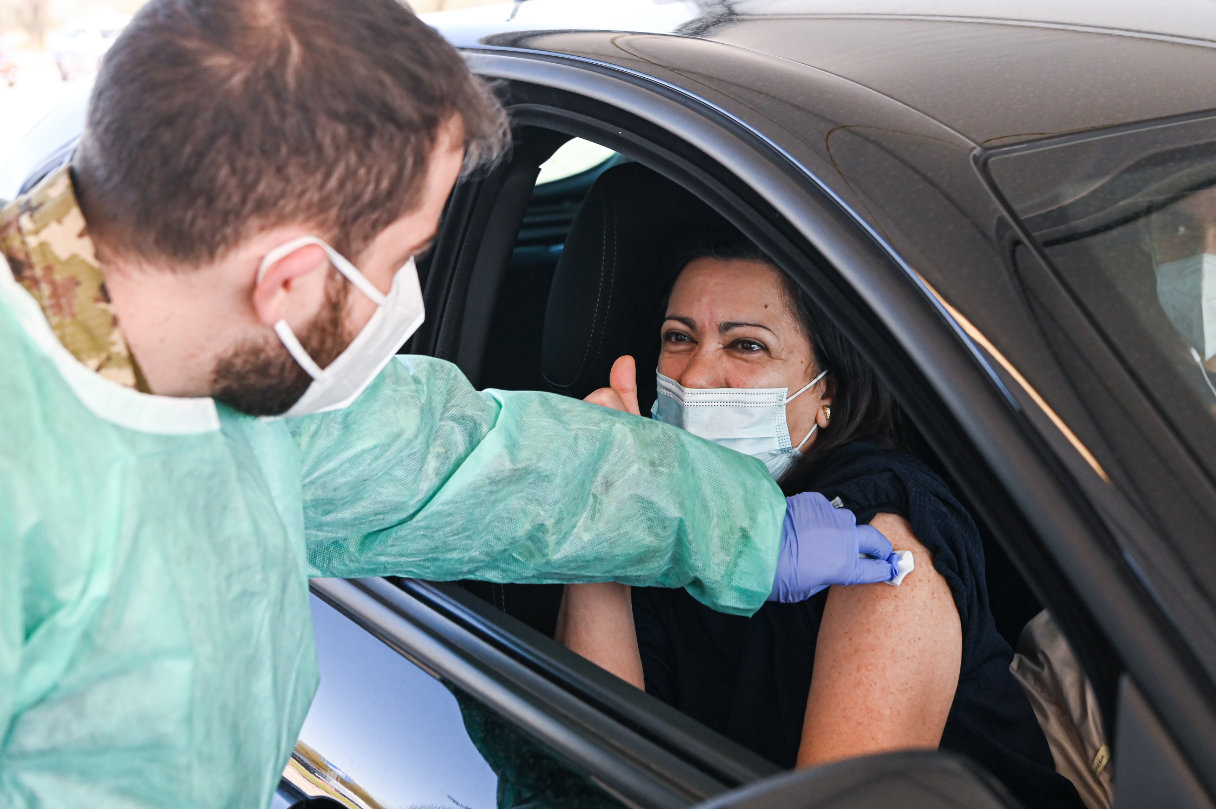
The EU’s response to COVID-19
Introduction
In 2021, following one of the most challenging years in its history, the European Union began to look to the future by launching its recovery from the COVID-19 pandemic.
The EU redoubled its efforts to scale up vaccine production and to support Member States and partner countries as they sought to speed up vaccination. Action taken early in 2020 through the EU Vaccines Strategy – investing in several different vaccines – proved successful. This resulted in the widespread availability of vaccines in 2021, despite a slower-than-expected start due to initial problems with the production and supply of one of them.
Following large-scale vaccination in Member States, on 31 August 2021 the EU reached the crucial milestone of having vaccinated at least 70 % of the EU adult population. By the end of the year, the share had risen to 79.8 %. As a resurgence of the pandemic swept through Europe and the world towards the end of the year, stemming the spread of the virus remained a key priority. The Commission put forward a common and coordinated EU approach to address the challenge in all Member States – several of which reintroduced restrictions – while continuing the effort to increase vaccination coverage and starting to deploy booster jabs.
During the year, the European Commission worked with Member States to enhance their testing and tracing capacities and to implement whole-genome sequencing (which has proved crucial with the spread of the Omicron variant). The Commission also continued to invest in research and innovation for new and improved vaccines and treatments for COVID-19. The EU Digital COVID Certificate, launched in July, made it easier for people to travel safely around Europe and further afield. One billion certificates had been issued by the end of 2021.
Meanwhile, the EU mobilised to deliver Europe’s unprecedented recovery plan. The EU’s long-term budget (€1 211 billion), coupled with NextGenerationEU, the temporary instrument designed to boost the recovery (€800 billion), is the largest stimulus package ever financed by the EU, totalling more than €2 trillion. In response, Member States drew up national recovery and resilience plans, setting out investments and reforms to address the impact of the pandemic and accelerate the green and digital transitions. The Recovery and Resilience Facility at the heart of NextGenerationEU will provide €723.8 billion in grants and loans to support Member States’ reforms and investments. By the end of the year, the Commission had positively assessed 22 national plans worth more than €445 billion in funding, which were approved by the Council of the European Union. The Commission disbursed €54.3 billion in pre-financing under the Recovery and Resilience Facility to 20 Member States, and made a first payment of €10 billion to Spain. While the speed of the recovery may vary across the EU, all Member States are expected to see their economies return to pre-crisis levels by early 2023.
Building on the early lessons learnt from the pandemic, the first European Health Union proposals focused on crisis preparedness. When adopted, these will equip the EU with the means to better prevent and address future pandemics and other cross-border health threats, and to improve the resilience of health systems. The launch in September of the new Health Emergency Preparedness and Response Authority (HERA) was a major step forward in helping protect the health of people in the EU, completing the European Health Union. (See Chapter 4 for more information.)
The EU also worked to strengthen international cooperation against the pandemic, including through the G20+ Global Health Summit, held in Rome, Italy, in May, and the Access to COVID-19 Tools Accelerator (ACT-A) initiative, which aims to speed up the development and production of and equitable access to COVID-19 tests, treatments and vaccines. The Global Health Summit adopted the Rome Declaration, setting out common principles to overcome the COVID-19 pandemic and to prevent and prepare for future pandemics. The Commission, Member States and financial institutions, in particular the European Investment Bank and the European Bank for Reconstruction and Development, acting together as Team Europe, stepped up funding for and action on other continents. By 4 January 2022, Team Europe had shared 380 million doses of vaccines with partner countries, 255.4 million of which had already been delivered, mostly through COVAX (the ACT-A vaccine pillar). The overall target is to share 700 million doses by mid 2022.
Extending the crisis response
In 2021, the European Union continued and extended its efforts to deal with the impact of the crisis, with more than 2 326 measures to provide support adopted in total since the beginning of the pandemic.
The unprecedented activation of the general escape clause of the Stability and Growth Pact, allowing Member States to deviate temporarily from the strict budgetary rules, continued to apply in 2021, allowing them to provide strong fiscal support. During the year, the Commission continued to use the full flexibility of State-aid rules as part of its policy response in support of an economy severely impacted by the effects of the pandemic. Between the start of the pandemic and the end of 2021 it adopted more than 730 decisions, approving nearly 900 national measures notified by the Member States, for a total funding amount of €3.17 trillion. In the course of 2021, the focus gradually shifted from the urgent need to keep ailing businesses afloat to facilitating a quick, robust and sustained recovery. The sixth amendment to the State Aid Temporary Framework, adopted in November 2021, reflects this shift, enabling an EU-wide coordinated phase-out of support while envisaging measures to accelerate the recovery. Thanks to these more flexible rules, and their constant fine-tuning as the crisis moves towards recovery, the Commission helped Member States to contain the impact of the economic downturn of the pandemic, preserve a properly functioning and competitive Single Market and pave the way for recovery.
Emergency support and assistance
Member States have been able to rely on the EU budget to help them deal with the many health consequences of the pandemic. In 2021, a wide range of health initiatives were funded through the Emergency Support Instrument, which is financed through the EU budget, including securing vaccines through advance purchase agreements with vaccine manufacturers.
In January, the Commission announced the 24 projects selected to create new programmes, or expand existing ones, to collect plasma from donors who have recovered from COVID-19. The EU also made an additional €65 million available from its budget in 2021 to purchase personal protective equipment and medicines, train healthcare professionals in intensive-care skills and test people in difficult-to-reach areas. It also mobilised an additional €100 million to directly purchase over 20 million rapid antigen tests, which were delivered to 25 Member States from February onwards.
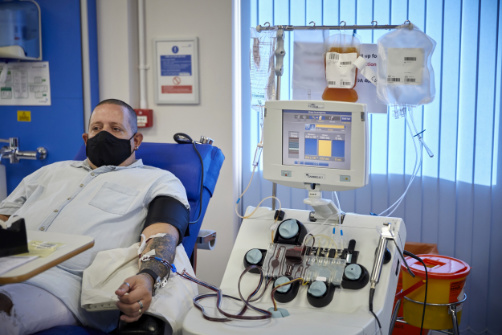
Overall, the EU Civil Protection Mechanism has helped deliver more than 30 million vaccine doses and over 200 million items of medical equipment to EU Member States and other countries since the start of the pandemic. In 2021, the EU also mobilised emergency medical teams to Romania and Slovakia in the EU, and further afield to Guinea, Papua New Guinea and Tunisia. The EU further developed the strategic rescEU medical stockpile in close cooperation with Member States, and funded the purchase of additional personal protective equipment, intensive care units and oxygen concentrators. Through rescEU, the EU managed to plug the gap of 6 million COVID-19-related emergency medical items in Latvia and Romania in the EU, and Montenegro, North Macedonia and Serbia in the Western Balkans. It delivered more than 3.4 million protective masks, 2.5 million pairs of gloves, 150 000 gowns and other items of personal protective equipment, such as face shields, goggles and foot protection. During the year, the Humanitarian Air Bridge continued to deliver support, including essential medical supplies, to some of the world’s most vulnerable communities.
Some 305 disinfection robots were delivered to hospitals across the Member States. Up to €12 million was made available to purchase the robots, which can disinfect standard patient rooms using ultraviolet light in just 15 minutes.
The EU provided €43 million to Member States for the production of EU Digital COVID Certificates, and an additional €7 million for the revocation of false certificates. €2.5 million was mobilised to develop the European Digital Passenger Locator Form application to facilitate contact tracing when travellers are exposed to an infectious disease during their travel. A total of €220 million was also made available in 2020 and 2021 to finance the transport of COVID-19-vaccination-related equipment and treatments, and to support the transfer of patients and the deployment of medical teams.
Testing for and tracking COVID-19
In January, the Commission set out the key elements of comprehensive testing strategies to be considered for national, regional or local testing approaches, such as their scope, priority groups, testing capacities and resources, and indications as to when rapid antigen testing may be appropriate. The Commission called on Member States to increase genome sequencing, and provided €110 million in support through the European Centre for Disease Prevention and Control. To delay the spread of emerging variants of concern, the centre recommended that Member States put the required capacities in place that would allow them to sequence a total number of samples that would detect a variant of concern at a prevalence level of 1 %.
In March, the Commission adopted a recommendation to track COVID-19 through wastewater monitoring. It asks the Member States to put in place wastewater surveillance systems and ensure that relevant data is provided promptly to the competent health authorities.
Supporting jobs and protecting livelihoods

The total amount of Sure funding is 94.3 billion euro, including 8.2 billion euro for Belgium, 511 million euro for Bulgaria, 2 billion euro for Czechia, 230 million euro for Estonia, 2.5 billion euro for Ireland, 5.3 billion euro for Greece, 21.3 billion euro for Spain, 1 billion euro for Croatia, 27.4 billion euro for Italy, 603 million euro for Cyprus, 305 million euro for Latvia, 957 million euro for Lithuania, 504 million euro for Hungary, 420 million euro for Malta, 11.2 billion euro for Poland, 5.9 billion euro for Portugal, 4.1 billion euro for Romania, €1.1 billion euro for Slovenia and 630 million euro for Slovakia. The amounts are rounded.
The Support to mitigate Unemployment Risks in an Emergency (SURE) initiative, set up in 2020 to protect jobs and support families affected by the pandemic, has been an important part of the EU’s response to the COVID-19 crisis. Under the initiative, the Commission borrowed €89.64 billion between October 2020 and May 2021, which it provided in loans to 19 Member States. A further €4.62 billion in already approved support should be raised and disbursed in 2022. Other Member States can submit requests to receive support under SURE, which can still provide almost €6 billion in financial assistance.
Between 1.5 million and 2.5 million firms have benefited from SURE, allowing them to retain workers.
It is estimated that Member States have saved more than €8 billion in interest payments by using SURE instead of issuing sovereign debt themselves.
A report published by the Commission in September on the impact of the scheme confirms its success in cushioning the impact of the crisis through financial assistance for short-time work schemes and measures for the self-employed. In 2020, SURE supported 31 million people – 22.5 million employees and 8.5 million self-employed people. This represents more than one quarter of the total number of people employed in the 19 beneficiary Member States.
The EU is committed to helping Member States maintain and create jobs for a fair, inclusive and resilient recovery from the COVID-19 crisis. In March, the Commission’s recommendation on effective active support to employment provided guidance to Member States on active labour-market policies. It aims to address the challenges triggered by the pandemic, bridge the skill shortages that are holding up economic growth during the recovery and help every individual to successfully navigate the green and digital transitions. The goal is to move gradually from emergency measures taken to preserve jobs during the pandemic to new measures for a job-rich recovery.
In August, the Commission took action to support farmers affected by the pandemic and adverse weather conditions, enabling them to receive higher advance payments under the Common Agricultural Policy. The Commission also supported the agri-food sector through increased flexibility and specific market measures that targeted the wine, fruit and vegetable sectors.
To ensure the safe resumption of activities in the cultural and creative sectors, in June 2021 the Commission published EU guidelines to provide a coordinated approach in line with the specific national, regional and local conditions. In November, it published an online guide to EU funding for culture , covering around 20 existing EU programmes that Member States and the sector can access to apply for funding.
EU Vaccines Strategy

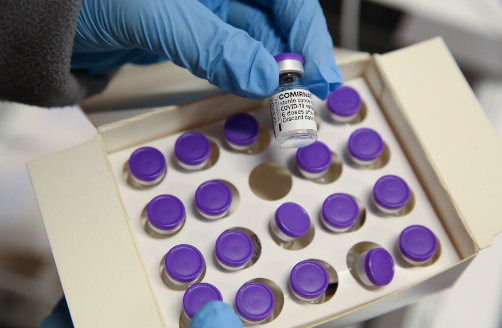
The European Union has successfully built, together with the Member States, a broad and diversified portfolio of billions of doses of safe and effective vaccines against COVID-19, from multiple manufacturers. By the end of 2021, five of the eight vaccine contracts had delivered safe and effective vaccines, while two more may still do so and one contract had been abandoned. The EU Vaccines Strategy had resulted in deliveries to Member States of nearly 1 billion doses by then, with as many doses exported to other parts of the world.
The groundwork in the early days of the pandemic led to the delivery of hundreds of millions of doses of COVID-19 vaccines following the approval and authorisation of the first vaccine, developed by BioNTech/Pfizer, at the end of 2020.
In 2021, the Commission granted a further four conditional marketing authorisations for the vaccines developed by Moderna, AstraZeneca, Janssen Pharmaceutica NV and Novavax, following the European Medicines Agency’s (EMA) positive assessment of their safety and efficacy. Several other vaccines are at different stages of assessment by the agency. Following the withdrawal of CureVac’s vaccine from the EMA’s rolling review process on 11 October, the contract with CureVac was abandoned, and it is no longer part of the EU vaccine portfolio.
The scientific evaluation by the EMA of the vaccines being produced by Valneva and Sanofi was still ongoing at the end of 2021. Should the EMA give a vaccine a positive scientific opinion for a conditional marketing authorisation by the Commission,then these vaccines will also be available to Member States.
Since mid 2020, the Commission has thus secured the right to buy up to 4.2 billion vaccine doses through advance purchase agreements and purchase agreements. In return, the Commission financed part of the upfront costs using the Emergency Support Instrument. This funding, following an open invitation to vaccine developers, was considered a down payment on the vaccines that Member States purchase under the advance purchase agreements. The portfolio consists of promising vaccines selected by the Commission, where manufacturers have received funding for the development up front as the Commission intends to purchase doses once the vaccine has been approved by the EMA.

In total, the EU will purchase up to 2.4 billion doses of Bio N Tech Pfizer, with the option to purchase an additional 900 million doses, up to 460 million doses of Moderna, up to 400 million doses of Astra Zeneca, up to 400 million doses of Johnson and Johnson requiring only one dose, up to 200 million doses of Novavax, with the option to purchase an additional 100 million doses, up to 300 million doses of Sanofi GSK up to 60 million doses of Valneva.
While production and delivery in the first quarter of the year had been expected to be relatively low, this was exacerbated by the failure of one company to deliver in line with its contract. In February, the Commission set up a task force with the aim of helping to ramp up the production capacity for vaccines in the EU – acting as a one-stop shop for manufacturers in need of support – and to identify and address bottlenecks in production capacity and supply chains. The Commission also supported Member States in rolling out vaccines by preparing them for large-scale vaccination – from cold-chain infrastructure that ensures vaccines are stored at the correct temperature to defining priority groups for vaccination and communication efforts.
The COVID-19 vaccination state of play at the beginning of 2022
981 million
doses delivered
79.8 %
of the EU adult population
fully vaccinated
Source: Vaccine producers and European Centre for Disease Prevention and Control data.
From April 2021 onwards, deliveries to the EU increased considerably, as expected. By mid July, over 1 billion vaccine doses had been produced in the EU, with 500 million vaccines delivered to Member States – enough to reach the goal of vaccinating 70 % of adults by the end of the summer. This target was reached by 31 August 2021.
Following a resurgence of the virus in autumn 2021, and with the Omicron variant circulating at the end of the year, Member States redoubled their efforts to limit its transmission, including by reintroducing measures such as social distancing and international travel restrictions, and through their national vaccination programmes. The European Commission worked with Member States and the European Centre for Disease Prevention and Control to find a coordinated approach to these matters. The Commission has also worked with Member States to increase vaccination uptake by addressing vaccine hesitancy, misinformation and disinformation.
The rate of vaccination continued to increase throughout 2021, with the EMA recommending a number of vaccines to adolescents and to children over the age of 5. By the end of the year, all of the Member States had started offering additional doses to medically vulnerable groups, and booster doses to the general population.
Developing treatments for COVID-19
Overcoming the pandemic will require more than just vaccines. Even with increasing vaccination rates, measures such as wearing face masks and social distancing often remained necessary in 2021. COVID-19 treatments are needed to avoid or reduce hospitalisations, speed up recovery and save lives. In May, the Commission proposed an EU Strategy on COVID-19 Therapeutics, which aims to support the development and availability of much-needed treatments, including for 'long COVID'. It complements the EU Vaccines Strategy and builds on both the Pharmaceutical Strategy for Europe and the Commission’s cooperation with the EMA to support the research, development, manufacturing and deployment of treatments.
In October, the Commission established a portfolio of the 10 most promising COVID-19 therapeutics. The list was based on the screening of 82 therapeutic candidates in late-stage clinical development by a group of independent scientific experts. These therapeutics cover different product categories addressing different stages and severities of the disease, and will reach patients across the EU as fast as possible, provided their safety and effectiveness is confirmed by the EMA.
By the end of 2021, the Commission had authorised five treatments from the list for use in the EU, following their evaluation by the EMA. The monoclonal antibodies Ronapreve, Xevudy and Regkirona were authorised for those in the early stages of the disease, while two medicines already on the market – the immunomodulators RoActerma and Kineret – were authorised for hospitalised COVID-19 patients.
The Commission is supporting Member States in having access to therapeutics, and has concluded two joint procurement contracts for the purchase of monoclonal antibodies. Negotiations are also ongoing for some other products that are under assessment by the EMA.
The Commission has invested €119 million under Horizon 2020 to support 45 research and innovation projects on therapeutics and treatment options for COVID-19, including via the European Innovation Council and the Innovative Medicines Initiative. The Commission is currently supporting three clinical trials – the REMAP-CAP, Discovery and EU-SolidAct trials – which have delivered significant results on treatments in development.
Tackling new variants
New variants, some of which are more transmissible than others, have added to the complexity and challenges of the pandemic. HERA brought together researchers, biotech companies, manufacturers and public authorities in the EU and globally to prepare for new variants. While the first generation of vaccines approved in the EU proved largely effective against early variants, future variants may prove more resistant to vaccines. This requires constant vigilance against and monitoring of COVID-19 mutations. HERA provides this shield against such future potential variants, along with incentives to develop new and adapted vaccines, speed up the approval process for such vaccines and scale up manufacturing capacities.
In June, the Commission adopted a decision to set up a European expert group on SARS-CoV-2 variants, which brings together leading scientists in the field of COVID-19. This group has been instrumental in reviewing data about emerging variants and advising on the need for adapted vaccines in the light of the available scientific data. The expert group was mobilised quickly at the start of the Omicron crisis, and solutions were sought to share possible access to samples of the virus, organise scientific capacities and share the results widely, with the financial support of HERA.
In 2021, the Commission increased funding for research on variants by providing an additional €30 million to several projects running under Horizon 2020, and launched the EU-wide vaccine trial network Vaccelerate. The network is the backbone of the acceleration of phases two and three of COVID-19 vaccine trials in the EU, connecting all stakeholders involved in vaccine development and providing a pan-European platform for clinical-trial design and conduct.
Under the Horizon Europe research and innovation programme, €120 million was mobilised for 11 new research projects. Most of this amount will support clinical trials for new treatments and vaccines, along with the development of large-scale COVID-19 cohorts and networks, including work beyond the EU. Other projects will reinforce and widen access to research infrastructure, including the COVID-19 Data Platform.
Reopening Europe safely

What is the EU digital Covid certificate? An EU digital Covid certificate is digital proof that a person has been vaccinated against Covid 19, or has received a negative test result, or has recovered from Covid 19. It can be in digital and/or paper format, it comes with a QR code, it is free of charge and it is written in the national language and in English. It is safe and secure and is valid in all EU member states.
In May, as the health situation improved and vaccination started to speed up across the EU, the Commission proposed that Member States should gradually ease travel restrictions. In June, the Parliament and the Council approved a Commission proposal for a regulation establishing the EU Digital COVID Certificate, to facilitate safe travel inside the EU. Also in June, the Council adopted an updated recommendation on free-movement restrictions. All of the Member States, along with Iceland, Liechtenstein, Norway and Switzerland, implemented the certificate in 2021. Making use of the EU Digital COVID Certificate system, the Council updated its recommendations on travel restrictions. The recommendations also envisaged action to limit the risk of new variants entering the EU: an emergency brake mechanism was introduced to allow Member States to act quickly and set up temporary limits on travellers from affected countries.
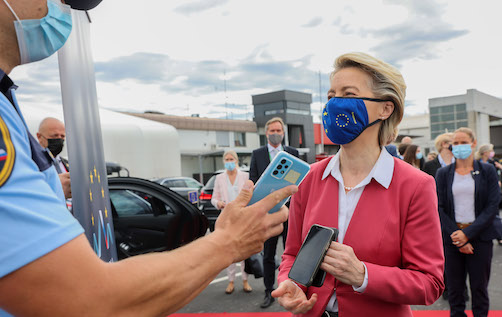
The EU Digital COVID Certificate has been very successful. Thanks to its speedy adoption by the Parliament and the Council it was up and running in just 3 months, and in time for the start of the summer holidays in July. The EU has established a common framework for issuing, verifying and accepting certificates. Many Member States adopted national laws to introduce further use of the certificates domestically. The system has helped to keep shops, services and businesses open and has enabled people to take part in cultural, sporting and leisure events. It has helped the tourism sector by making it easier for authorities and airlines to verify the documentation provided by travellers, giving people the confidence that their documentation will be accepted when they travel in the EU.
By the end of the year, more than 1 billion certificates had been issued by EU Member States and countries in the European Economic Area. The EU Digital COVID Certificate is also a success worldwide: 33 non-EU countries (and territories) had joined the EU Digital COVID Certificate system by the end of December, based on EU equivalence decisions. The Re-open EU website acts, along with its app, as a hub for information on health and travel measures across the Member States, Iceland, Liechtenstein, Norway and Switzerland.
NextGenerationEU: the EU’s recovery plan in action
2021 saw the EU’s historic NextGenerationEU recovery plan come to life, with funds flowing into EU economies from the summer onwards, marking the start of the turnaround from the pandemic.
NextGenerationEU will not only help repair the damage caused by the pandemic but also enable Member States to invest in the EU’s long-term future and resilience, with a strong focus on accelerating the green and digital transitions. It provides a once-in-a-lifetime chance to emerge stronger from the pandemic, transform EU economies and create opportunities and jobs.

Next generation EU: key features The total next generation EU package amounts to 806.9 billion euro. The recovery and resilience facility is composed of a total of 723.8 billion euro, made up of 338.0 billion euro in grants and 385.8 billion euro in loans. It will power up by funding clean technologies and renewables, renovate by improving the energy efficiency of buildings, recharge and refuel by supporting sustainable transport and charging stations, connect by rolling out rapid broadband services, modernise by digitalising public administration, scale up the data cloud and sustainable processors and reskill and upskill by funding education and training to support digital skills. Next generation EU’s contribution to other programmes amounts to 83.1 billion euro, consisting of 50.6 billion for react EU, 10.9 billion euro for the just transition fund, 8.1 billion euro for rural development, 6.1 billion euro for invest EU, 5.4 billion euro for horizon Europe and 2.0 billion euro for resc EU. All amounts are in current prices.

The EU’s long-term budget for 2021 to 2027 and next generation EU packages amount to a total of 2.018 trillion euro (in current prices), made up of 806.9 billion euro for next generation EU and 1,210.9 billion euro for the EU’s long term budget. For cohesion, resilience and values the long-term budget allocates 426.7 billion euro, plus 776.5 billion euro from next generation EU. For natural resources and the environment the long-term budget allocates 401 billion euro, plus 18.9 billion euro from next generation EU. For migration and border management the long-term budget allocates 25.7 billion euro. For security and defence the long-term budget allocates 14.9 billion euro. For the neighbourhood and the world the long-term budget allocates 110.6 billion euro. For European public administration the long-term budget allocates 82.5 billion euro. For the single market, innovation and digital the long-term budget allocates 149.5 billion euro, plus 11.5 billion euro from next generation EU.
The centrepiece of NextGenerationEU is the Recovery and Resilience Facility. Launched in February 2021, it offers up to €723.8 billion (in current prices) in grants and loans to support reforms and investment across the Member States. The facility is a performance-based instrument, and disbursement of funds is conditional on the satisfactory achievement of the agreed milestones and targets. In order to benefit from it, Member States have to submit to the European Commission national plans that set out the reforms and investments that they intend to make up to the end of 2026, which then must be approved by the Council.

Member states have allocated 39.9% of spending in their plans to climate measures and 26.4% to the digital transition. This exceeds the agreed targets of 37% for climate spending and 20% for digital spending.
All plans have to meet binding climate and digital goals, including a minimum expenditure of 37 % dedicated to climate investment and reforms and a minimum expenditure of 20 % dedicated to the digital transition. In practice, Member States are committing to going further than these targets, as almost 40 % of expenditure is to be spent on climate investments and reforms while 26.4 % is to be spent on the digital transition. This will help the EU to achieve its goal of climate neutrality by 2050 and will set it on a path of digital transition, creating jobs and spurring inclusive growth in the process.
Under the Recovery and Resilience Facility, by the end of 2021 the Commission had positively assessed 22 of the national recovery and resilience plans, worth more than €445 billion in total (out of the €723.8 billion available). These plans were subsequently approved by the Council. The national plans were assessed according to 11 criteria, including how well they address challenges identified in the European Semester country-specific recommendations. In designing and implementing the growth-enhancing and inclusive reforms required, Member States can count on support from the Commission through the Technical Support Instrument. This support is provided in a wide range of areas, such as the green transition, healthcare, public finances, the digitalisation of education and public services, the business environment and the financial sector.
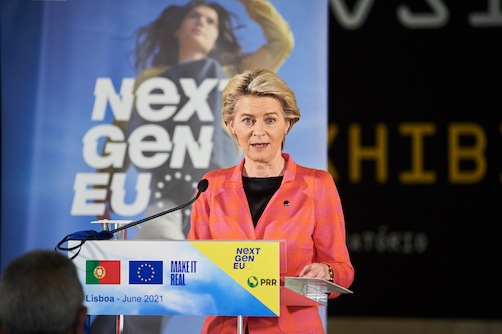
The Commission has so far distributed €54.3 billion to 20 Member States under the Recovery and Resilience Facility, both in pre-financing and in response to the first payment request from a Member State. In December, following a Commission assessment and confirmation the country had reached the relevant milestones and targets, Spain received €10 billion.
The payments followed the Commission’s successful performance on the capital markets. To fund NextGenerationEU, the institution, on behalf of the EU, will borrow up to around €800 billion on the financial markets by the end of 2026. Thanks to the EU’s high credit rating, the Commission is able to borrow at more favourable rates than many of its Member States, to the advantage of those Member States and the EU budget. The Commission will seek to raise 30 % of the funds by issuing NextGenerationEU green bonds, and will use the proceeds to finance green policies.
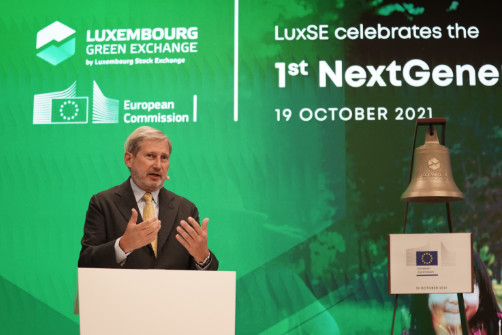
In April 2021, the Commission announced it would use a diversified funding strategy to raise the necessary funding. Following the approval by all EU Member States of the Own Resources Decision – the legal tool enabling the borrowing – the Commission proceeded with the first issuance in June 2021. By the end of the year, it had raised a total of €71 billion in EU-Bonds, and additional funds in short-term EU-Bills. This included the first NextGenerationEU green bond, of €12 billion – the world’s largest-ever green bond issuance. It was issued following the adoption of a state-of-the-art NextGenerationEU green bond framework in September 2021, which guarantees to investors in these bonds that the funds mobilised will be allocated to green projects.
All borrowing under NextGenerationEU will be repaid by 2058. To help repay the funds raised – and to contribute to the EU’s policy objectives on the budget-revenue side as well – the Commission has proposed the introduction of new sources of revenue to the EU budget. A levy based on non-recycled plastic packaging waste, which will contribute to the goals of the European Green Deal, was introduced in January 2021. In December, the Commission proposed to establish three new own resources for the EU budget, based on:
- revenues from the Emissions Trading System;
- the resources generated by the proposed EU Carbon Border Adjustment Mechanism; and
- the share of residual profits of multinational companies reallocated to Member States in accordance with the forthcoming directive on the implementation of the global agreement on the reallocation of taxing rights.
These revenues will also contribute to financing the Social Climate Fund, designed to make sure that the transition to a decarbonised economy works for everyone. The Commission will propose additional new own resources by the end of 2023.
REACT-EU

€7.7 billion
to help hospitals secure medical devices, personal protective equipment, ventilators and testing.
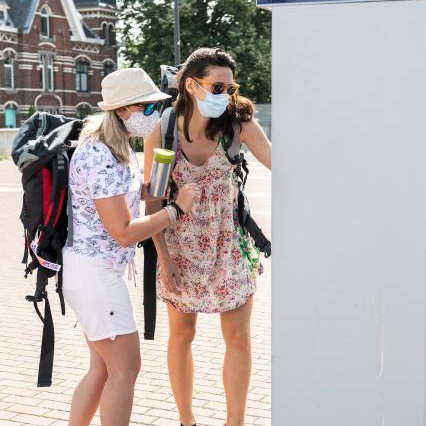
€11.5 billion
to support businesses in all sectors of the economy, including those hardest hit such as culture, tourism and food service.

€4.1 billion
to provide direct support to people, including workers, by implementing and supporting employmentretention schemes.
Some examples of REACT-EU funding.
As part of NextGenerationEU, REACT-EU (Recovery Assistance for Cohesion and the Territories of Europe) continues and extends the crisis-response and crisis-repair measures delivered through the Coronavirus Response Investment Initiative and the Coronavirus Response Investment Initiative Plus, and provides a bridge to the long-term recovery plan. As such, REACT-EU will contribute to a green, digital and resilient recovery of the economy.
This funding, of €50.6 billion, is entirely new. It is a top-up to funding still available under 2014–2020 programmes to be added to the cohesion funding allocations for 2021– 2027. The money will be made available to the European Regional Development Fund, the European Social Fund and the Fund for European Aid to the Most Deprived.
Rural areas of the EU were also supported under the NextGenerationEU recovery instrument, to the amount of €8 billion, distributed via the rural development programmes funded under the Common Agricultural Policy. This funding has allowed Member States to support the green and digital transitions in rural areas.
The EU’s Cohesion Policy on the front line of the recovery.
European Regional Development Fund
The fund has supported the purchase of vaccines for more than half of the population in Portugal and paid for the installation of new IT systems in the health sector in Slovenia. It is funding the purchase of new medical equipment to help regions become more resilient against future health crises in Czechia, and supporting small companies in managing the digital transition in Sweden.
European Social Fund
Across the Member States, people have received training, coaching and career guidance to increase their chances of maintaining their jobs or finding new ones. In Italy, businesses have received hiring subsidies to support the employment of women and young people. The fund has also supported financial counselling services and housing for homeless people.
Fund for European Aid to the Most Deprived
In Austria and Romania, children in need have received school supplies. In Estonia, France, Luxembourg and other Member States, food aid (such as warm meals) and basic material assistance (such as hygiene products) have been delivered to those people most in need.
Fighting COVID-19 disinformation
In 2021, the EU continued to fight false information and disinformation on COVID-19 coming from both inside and outside the EU. This entailed monitoring information from a wide range of sources and debunking conspiracy narratives, including about the effects of vaccines or that undermined trust in vaccination. All action was taken in close cooperation with the EMA, the Member States and international partners such as the G7 and NATO. The findings were published regularly by the European External Action Service and the Commission.
In the face of growing disinformation around the pandemic within the EU, the Commission published guidance on strengthening the Code of Practice on Disinformation to make it a more effective tool for countering false or misleading information, and suggesting wider participation. In July, the Commission and current signatories to the code issued a call for more companies and organisations to sign up with the aim of further strengthening the EU’s stance against this harmful phenomenon. Twenty-six prospective signatories have since joined the process to draft a strengthened code of practice, which is expected in spring 2022.
External action included work to strengthen awareness of the benefits of vaccination, including through social media campaigns such as the #VaccToNormal campaign, which features personal stories of vaccinated people from around the world. Efforts focused on public diplomacy initiatives in countries neighbouring the EU – in particular in the Western Balkans – and around the world to ensure access to authoritative information. The EU also provided support to independent media and journalists inside and outside the Member States. The Commission has, in addition, financed research projects addressing the accuracy of information on social and other media, along with coronavirus-related disinformation.
In October, the Commission launched an Expert Group on Tackling Disinformation and Promoting Digital Literacy through Education and Training. The group’s overall mission is to help prepare practical guidelines for teachers and educators. This will serve to reinforce the objective of the Commission’s Digital Education Action Plan, which aims to ensure that every pupil in every school across the EU receives the best possible digital education.
Acting worldwide
Vaccines
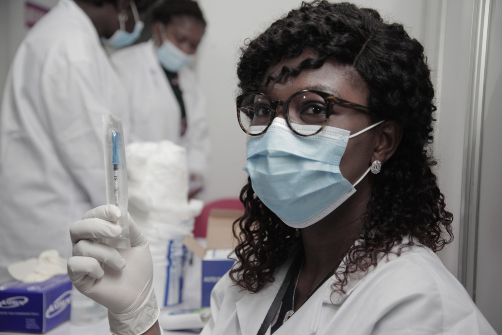
Since the beginning of the pandemic, the EU has been at the forefront of global solidarity. It has continued to uphold its commitment to ensuring that safe vaccines reach all corners of the world, together with personal protective equipment, ventilators and other equipment, including through the EU Civil Protection Mechanism. By the end of 2021, the EU had exported or shared over 1.7 billion vaccine doses to 165 countries, representing two thirds of the total number of doses produced in the EU. This makes the EU, right from day one of vaccine production, the world’s largest exporter of vaccines.
In February 2021, COVAX – the COVID-19 Vaccine Global Access Facility – started delivering COVID-19 vaccines around the world, with the aim of guaranteeing fair and equitable access to COVID-19 vaccines for every country. Team Europe – made up of the EU institutions, the Member States and European financial institutions – is a lead contributor, mobilising over €3 billion to help COVAX purchase 1.4 billion doses by the end of 2021, of which more than 981 million doses have been delivered to 144 countries and territories.
Complementing the direct acquisition of doses by COVAX, the European Commission has established an EU Vaccine Sharing Mechanism to help Member States share their vaccines with non-EU countries both directly and via COVAX. The EU supports its partners with their vaccination strategies and the distribution of supplies, and to increase the local manufacturing of vaccines. Member States had committed to sharing over 200 million doses by the end of 2021, a target that was greatly exceeded as 380 million doses were shared with countries outside the EU, 255.4 million of which had been delivered by the end of the year (87 % via COVAX). The G20+ Global Health Summit also saw industrial partners commit to making available 1.5 billion doses of vaccines to low-income countries at no profit and middle-income countries at low cost by the end of 2021. With its humanitarian aid, the EU also responded to urgent needs stemming from COVID-19 among the most vulnerable countries by establishing the COVAX Humanitarian Buffer.
Furthermore, Commission President Ursula von der Leyen announced in November that the EU will share a total of 700 million vaccine doses with the most vulnerable countries by mid 2022, 200 million of which would be paid for from the EU budget.
These efforts are complemented by the Team Europe initiative to support local manufacturing and access to vaccines, medicines and health technologies in Africa. This is backed by €1 billion from the EU budget and European development finance institutions, and by cooperation between the European Centre for Disease Control and the Africa Centres for Disease Control and Prevention.

A new Team Europe initiative plans to mobilise 1 billion euro to help boost vaccine supplies by helping to set up regional manufacturing hubs and focusing on those countries with the greatest potential. It will consolidate demand by helping African countries coordinate their needs. Finally, it will make access to vaccines and medicines easier by strengthening the enabling environment. Possible examples of such countries include Egypt, Ethiopia, Ghana, Kenya, Morocco, Nigeria, Rwanda, Senegal and South Africa.
Global Health Summit
In May, President von der Leyen and Italian Prime Minister Mario Draghi co-hosted the G20+ Global Health Summit in Rome, where leaders backed the World Health Organization’s leading and coordinating role in response to COVID-19, and the broader global agenda on health. Leaders signed the Rome Declaration on preparing for and preventing future pandemics.
The 16 principles of the declaration reconfirm leaders’ commitment to global solidarity, equity and multilateral cooperation; to effective governance; to a people-centred approach; to building on science and evidence-based policies and trust; and to the promotion of sustained financing for global health. The declaration rejects export bans, and pledges to keep global supply chains open and operational to diversify global vaccine-manufacturing capacity.
The principles of the Rome Declaration inform ongoing work in the G7 and G20, including the recent formation of a G20 Joint Finance–Health Task Force to ensure adequate financing of prevention, preparedness and response. The EU led the efforts that resulted in the decision taken at the World Health Assembly Special Session in November and December to establish an intergovernmental negotiating body to strengthen pandemic prevention, preparedness and response.
In September, the EU and the United States made joint commitments in relation to vaccine sharing, readiness, supply (including of therapeutics), sustainable financing and regional vaccine production in their agenda for beating the global pandemic.
Mitigating the effects of the pandemic
The Team Europe approach has supported over 130 partner countries around the world with flexible financial support. From the beginning of the pandemic until the end of 2021, Team Europe mobilised over €46 billion to help address humanitarian needs, improve health, water and sanitation systems and mitigate the socioeconomic consequences of the pandemic.
In 2021, the EU stepped up its work to kick-start the global recovery. The Commission has worked to bring international players together, building new coalitions and cooperative initiatives to fight COVID-19 and launch a sustainable global recovery. In February, President von der Leyen joined the Global Citizen campaign 'A Recovery Plan for the World'. The year-long campaign was built around five priorities: help end COVID-19; curb the hunger crisis; resume learning everywhere; protect the planet; and advance equity for all.
From the beginning of the pandemic until July 2021, the EU provided over €4.35 billion to the Western Balkans and Turkey and more than €3.41 billion to the European Neighbourhood regions to address immediate health needs and reduce the socioeconomic impact of the crisis. This included programmes and grants to ensure the availability and distribution of EU-authorised COVID-19 vaccines and support to speed up vaccination campaigns. By the end of December, more than 77 million vaccine doses had been provided through the COVAX Facility to the Western Balkans and the Eastern and Southern Neighbourhood regions, and almost 32 million doses had been shared by Member States with partner countries (either directly or via COVAX) with EU support.

Creating a greener, climate-neutral Europe
Delivering the European Green Deal
In 2021, the EU continued to fight climate change through ambitious policies at home and close cooperation with international partners. In February, the European Commission adopted a new EU Strategy on Adaptation to Climate Change, setting out how the European Union can adapt to the unavoidable impacts of climate change and become climate resilient by 2050. Europe’s first-ever Climate Law was adopted in June by the European Parliament and the Member States, writing into law the economy-wide targets of reducing net greenhouse gas emissions by at least 55 % by 2030, compared to 1990 levels, and reaching climate neutrality by 2050.
Then, in July and December, the Commission tabled a series of proposals to make the EU fit to meet its climate ambitions by revising existing policies and putting forward new measures. The legislative proposals to deliver the European Green Deal cover a wide range of policy areas, including climate, energy, transport and taxation. They set out how the EU will reach its 2030 target, which is now legally binding. The proposals were communicated to the UN Framework Convention on Climate Change as the EU’s contribution to meeting the goals of the Paris Agreement.

The EU 2030 climate targets involve: the social climate fund; emissions trading for road transport and buildings; the carbon border adjustment mechanism; the EU emissions trading system, for power, industry, maritime and aviation; the land use, land use change and forestry regulation; the energy taxation directive; the EU forest strategy; the energy efficiency directive; the effort sharing regulation; the renewable energy directive; the alternative fuels infrastructure regulation; CO2 emissions standards for cars and vans; the fuel EU maritime initiative; and the refuel EU aviation initiative.
The benefits of climate action are clear: preventing or mitigating the climate emergency; a healthier planet to hand over to future generations; cleaner air; cooler and greener towns and cities; healthier citizens; lower energy use and bills; greater energy independence; new technologies and industrial opportunities; and more space for nature. Last but not least, the green transition will create new types of jobs. Accompanied by the right policies, it could create around 1 million jobs in the EU by 2030 and 2 million by 2050, and enhance the EU’s global competitiveness, with many other countries seeking climate solutions.
While the benefits of the EU’s climate policies clearly outweigh the costs of this transition in the medium to long term, in the short term they risk putting extra pressure on vulnerable households, micro-enterprises and transport users. The policies are therefore designed to spread the cost of tackling and adapting to climate change fairly, to ensure a just transition for all. This is one of the reasons why a Social Climate Fund accompanies the Commission’s proposal for the new Emissions Trading System in road transport and buildings. The potentially significant social impacts are further addressed in the proposed recommendation on ensuring a fair transition towards climate neutrality (see below).
Revision of the EU Emissions Trading System
The EU Emissions Trading System is the world’s first major carbon market. It sets a limit, or cap, on the total amount of certain greenhouse gases that can be emitted by the sectors covered. The cap is reduced over time so that total emissions fall. Companies covered by the system buy emissions allowances at auctions or receive them via free allocation. They can also trade allowances with one another as needed. Every year, each company must surrender enough allowances to fully cover its emissions, otherwise heavy fines are imposed.
Since the system was launched, in 2005, greenhouse gas emissions have been cut by around 43 % in the sectors covered (power generation, energy-intensive industry and aviation within the European Economic Area). Together, these sectors account for 41 % of the EU’s total emissions. In July 2021, as part of the legislative package to deliver the European Green Deal, the Commission proposed a new target to reduce emissions from the Emissions Trading System sectors by 61 % by 2030, compared to 2005 levels. To achieve this, the Commission’s proposal is for a one-off reduction of the total emissions allowances and an increase in the rate of reduction to 4.2 % per year, up from 2.2 % under the current system.

In the effort sharing sectors, which include road transport, housing and agriculture, the change compared to 2005 was minus 16% in 2020, and the target for 2030 is minus 40%. In the existing emissions trading system, which includes the power sector, energy-intensive industries, intra-European Economic Area flights and, after 2022, shipping, the change compared to 2005 was minus 43% in 2020, and the target for 2030 is minus 61%. In addition to them being covered by the Effort Sharing Regulation, the Commission has proposed a new Emissions Trading System specifically for emissions from road transport and buildings. The cap in this new system will be reduced annually to yield emissions reductions of 43 % in 2030, compared to 2005.
The Commission has also proposed a Carbon Border Adjustment Mechanism. Compatible with World Trade Organization rules, this mechanism will ensure that ambitious climate action in Europe does not lead to 'carbon leakage', whereby businesses transfer production to countries with weaker rules on emissions. Its gradual introduction, in parallel with the phasing out of free allowances under the current Emissions Trading System, will ensure that certain carbon-intense products imported into the EU – such as cement, iron and steel, aluminium, fertiliser and electricity – cost as much as the same products produced in the EU.
The Commission has put forward a proposal to strengthen the Market Stability Reserve. This reserve improves the system’s resilience to major shocks by setting aside a number of emissions allowances, which can be used to adjust the supply of allowances at auction. In the aviation sector, the Commission has proposed to gradually phase out the free allocation of allowances to airlines operating flights in the European Economic Area, moving towards full auctioning of allowances for the sector. The Commission is also proposing to apply the global Carbon Offsetting and Reduction Scheme for International Aviation to flights to and from the European Economic Area.
For the EU to reach its 2030 emissions reductions target, sectors currently outside the Emissions Trading System need to increase their decarbonisation efforts. To this end, the Commission has proposed to extend emissions trading to maritime transport and to introduce a separate emissions trading system for the road transport and buildings sectors.
In July, the Commission also proposed to ramp up climate innovation finance by significantly increasing the size of its Modernisation and Innovation Funds. Financed by allowances auctioned under the Emissions Trading System, the funds respectively support lower-income Member States in their transition to climate neutrality and finance innovative low-carbon technologies needed to power the green transition.
A fair transition towards climate neutrality
At the heart of the European Green Deal lies the commitment to make the transition to a climate-neutral economy in a fair way, leaving no one behind.
A new Social Climate Fund was proposed in July to help Member States support the transition to climate neutrality for those vulnerable citizens most reliant on fossil fuels. The Commission proposes to finance the fund via the EU budget with an amount equivalent, in principle, to 25 % of the expected revenues from the new emissions trading system for the road transport and building sectors, mobilising €72.2 billion for the 2025–2032 period. This will be used to assist Member States in supporting vulnerable households and micro-enterprises, invest in energy efficiency and the renovation of buildings and help finance zero- and low-emission mobility. Pending the impact of these investments on reducing costs and emissions, the fund will also be able to finance temporary direct income support for vulnerable households.
In December, the Commission issued policy guidance to encourage Member States to take action for a fair and inclusive transition to climate neutrality. The proposed Council recommendation addresses the relevant employment and social aspects of the transition. It pays particular attention to addressing the needs of those people and households that are highly dependent on fossil uels and could be most affected by the green transition. It also invites Member States to make optimal use of public and private funding and to work in close cooperation with social partners. The proposal includes measures and guidance to:
- support quality employment and facilitate job-to-job transitions;
- promote equal access to quality education and training;
- ensure fair tax-benefit and social-protection systems;
- facilitate affordable access to essential services;
- coordinate policy action and follow a whole-of-economy approach; and
- make optimal use of public and private funding.
Revision of legislation for sectors not covered by the Emissions Trading System
For sectors not covered by the Emissions Trading System, the EU’s Effort Sharing Regulation sets binding targets for reducing annual greenhouse gas emissions by 2030, for the EU and its Member States. The effort of cutting emissions is distributed among Member States according to their relative wealth, measured in gross domestic product per capita, and taking into account cost-efficiency.
In July, the Commission made a proposal to increase the EU’s target from the current 29 % decrease in emissions compared to 2005 levels to a 40 % decrease. Proposed national targets for decreases in emissions range from 10 % to 50 %, also compared to 2005.

Source: Annex to COM(2021) 555 – Member State greenhouse gas emission reductions pursuant to Article 4(1),
14 July 2021.
The proposed targets are: Bulgaria minus 10%; Romania minus 12.7%; Croatia minus 16.7%; Latvia minus 17%; Poland minus 17.7%; Hungary minus 18.7%; Malta minus 19%; Lithuania minus 21%; Greece minus 22.7%; Slovakia minus 22.7%; Estonia minus 24%; Czechia minus 26%; Slovenia minus 27%; Portugal minus 28.7%; Cyprus minus 32%; Spain minus 37.7%, EU 27 minus 40%; Ireland minus 42%; Italy minus 43.7%; Belgium minus 47%; France minus 47.5%; Austria minus 48%; Netherlands minus 48%; Denmark minus 50%; Germany minus 50%; Luxembourg minus 50%; Finland minus 50%; Sweden minus 50%.
Forests and agricultural land together cover more than three quarters of the EU’s land mass. Well-managed and resilient forests are key to achieving climate neutrality, as they remove carbon dioxide (CO2) from the atmosphere. In July, the Commission made a proposal to increase carbon removal to the equivalent of 310 million tonnes of CO2 by 2030 and to achieve climate neutrality in the combined land-use, forestry and agriculture sector at the EU level by 2035.
December saw the Commission adopt a communication on sustainable carbon cycles. It sets out how the EU can increase the removal of carbon from the atmosphere by reducing its reliance on fossil carbon, upscaling carbon farming to store more carbon in nature and promoting industrial solutions to sustainably and verifiably remove and recycle carbon.
EU Strategy on Adaptation to Climate Change
While the EU is doing everything it can to mitigate climate change, both domestically and internationally, it must also prepare to face its inescapable consequences. From deadly heatwaves and devastating floods to degraded forests and coastlines eroded by rising sea levels, climate change is already taking its toll.
This is why, in February, the Commission adopted a new EU Strategy on Adaptation to Climate Change, setting out how the EU can become climate resilient by 2050. Its objectives are to make adaptation smarter, swifter and more systemic, and to intensify international action. It aims to shift the focus from planning to implementation by developing and deploying solutions at scale.
For example, Climate-ADAPT, the European platform for adaptation knowledge, will be made more accessible for everyone, and now has a dedicated observatory to help track and prevent health threats linked to climate change. Another example is the launch of a Horizon Europe Mission on Adaptation to Climate Change. This flagship initiative will bring the latest adaptation technology, nature-based solutions and best practices to the EU’s regions so that they can become resilient to climate change.
Making our buildings more sustainable
Following the 2020 Renovation Wave strategy, the Commission’s ambition of doubling the rate of building renovation across the EU has been reflected in a number of new initiatives. In particular, December’s proposed revision of the Energy Performance of Buildings Directive aims to ensure that the EU is on track to decarbonise its building stock. The revision ensures that the energy consumption of buildings in the EU decreases by upgrading their energy efficiency through deep renovation. The proposal sets minimum energy performance standards and requires that 15 % of the building stock of each Member State be upgraded from label G to at least F by 2030. As part of the revision, the Commission also proposed that all new buildings must be zero-emission from 2030, and new public buildings from 2027.
The Commission’s proposal for a new Energy Efficiency Directive includes a more ambitious target for energy savings by 2030 across the economy, including by renovating public buildings. The Renewable Energy Directive proposal also sets a new benchmark of using 49 % renewable energy in buildings by 2030, and requires annual increases in the amount of renewable energy used for heating and cooling. The proposed new emissions trading system for buildings includes heating fuels. The Social Climate Fund financed by the new system will provide financial support for renovation to vulnerable households and micro-enterprises.
Finally, given the potential for renovation to act as a springboard for economic recovery, the EU’s Recovery and Resilience Facility puts particular emphasis on the building sector, and many Member States have included renovation and energy-efficiency investment in their national recovery plans.
New European Bauhaus
Launched in 2020, the New European Bauhaus aims to accelerate the transformation of our society and economic sectors such as construction and lifestyle industries, providing citizens with access to goods and services that are circular, affordable and less carbon intensive. In doing so, it helps to translate the European Green Deal into tangible change on the ground that improves everyday life, in buildings and public spaces as well as in fashion and furniture. The New European Bauhaus brings a cultural dimension to the Green Deal, and involves groups such as architects, designers and artists to leverage their contributions to the transformation.
Inspiration from grassroots projects from all over Europe and beyond helped shape the Commission’s concept of the New European Bauhaus initiative, published in September 2021. The co-design phase of the project, which ran from January to July, attracted more than 2 000 contributions. EU programmes – including Horizon Europe, LIFE, the Single Market Programme and Digital Europe – will provide around €85 million to New European Bauhaus projects in 2021–2022. In addition, the initiative will be integrated into many other EU programmes, such as Erasmus+ and the European Solidarity Corps. The Commission will also establish a New European Bauhaus Lab to co-create, produce prototypes of and test new tools, solutions and policy recommendations, together with the community.
From a 'floating' wild garden in the heart of Barcelona to a zero-waste house in Slovenia, the winners of the first New European Bauhaus prizes showed that sustainable can also be beautiful and inclusive. The 20 winners were announced in September.
Powering a climate-neutral economy
Building on the various strategies outlined in 2020, including on energy-system integration, offshore renewable energy, hydrogen and methane emissions, the Commission took a number of steps in 2021 to convert these ideas into EU legislation. It presented proposals in July and December to rewrite EU energy-policy rules and accelerate the transition to clean energy.
The Commission has proposed that renewables should reach a 40 % share of the EU energy mix by 2030. This is double the 2020 figure, and a significant increase on the previous target of 32 %. Eurostat figures have confirmed that the EU reached its 2020 targets comfortably.
The July proposal to revise the Renewable Energy Directive includes measures to target areas (such as transport and buildings) where progress has been slower than expected. Similarly, the proposal to revise the Energy Efficiency Directive aims to collectively reduce energy consumption by a further 9 % compared to what Member States have already pledged in their 2021–2030 national energy and climate plans, and intends to nearly double the annual energy-efficiency obligation.
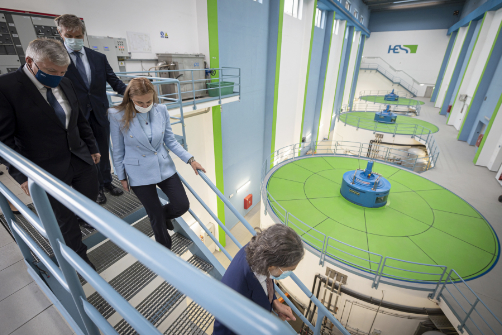
Further elements of the package of measures to deliver the European Green Deal followed in December, with proposals to decarbonise the gas sector and establish a hydrogen market. These proposals for the EU gas market facilitate the transition from fossil-based fuels towards renewable and low-carbon gases. They also focus on creating a functioning market for hydrogen in the medium term, while also promoting other clean gas technologies.
As a driving force behind the Global Methane Pledge, to which the EU and 110 countries signed up at the COP26 Climate Change Conference in Glasgow, the EU has also helped establish an International Methane Emissions Observatory to measure emissions and track progress. In December, the first-ever legislative proposal was tabled to tackle EU methane emissions.

New energy labels: how to recognise a rescaled product. The new label features a QR code giving access to more information on the model. Furthermore, the energy efficiency classes have been rescaled. For example, a class C fridge with the new label would have been rated class A +++ with the previous one. The method of calculating the annual energy consumption has also been refined. For example, the same fridge has a declared consumption of 66 kilowatt hours per annum with the new label, but 62 with the previous one. Finally, the fridge volume is expressed in litres, and on the new label the noise level is measured in decibels using a four-class scale.
2021 also saw a rescaling of EU energy labels for certain household products (from washing machines to light bulbs). This shows that the label helps drive innovation in energy efficiency as manufacturers want to be in the highest class available on the market, and consumers are influenced by these labels when buying products.
The European Green Deal package, in July, also included a proposal to revise the EU’s Energy Taxation Directive. This aims to ensure that the taxation of energy products better reflects the impact they have on the environment and supports the EU’s climate-change goals. The revision will remove current disadvantages for clean-energy products and technologies and introduce higher levels of taxation for more-polluting fuels. This will help to set the right price signals for energy products, thereby reinforcing green innovation and investment in sustainable, clean energy.
As an immediate response to the global phenomenon of exceptionally high energy prices, the Commission issued a communication with a 'toolbox' of measures in October, indicating short-, medium- and long-term initiatives that the Member States and the EU can undertake to alleviate the situation for households and businesses alike. By January 2022, most Member States had introduced measures laid out in the toolbox, to cushion the impact of the price surge. The Commission followed up on the communication with legislative proposals in December to improve the use of storage. It then set out an enabling framework for joint purchases of gas reserves and provisions to reinforce solidarity between Member States.
Sustainable and smart mobility
As part of the July legislative package to deliver the European Green Deal, the Commission proposed new rules to incentivise and increase the use of clean fuels in the aviation and maritime sectors (ReFuelEU Aviation and FuelEU Maritime). This will not only help reduce emissions from these two sectors, but also foster innovation and economic activity in the EU through the necessary technological adaptation and the development of alternative fuels.
To meet the decarbonisation targets for transport, the EU’s industrial base must develop new sourcing capabilities, production and storage capacity and distribution networks – all in a very short period. To complement the legislative proposals presented in 2021, the Commission has also launched the Renewable and Low-Carbon Fuels Value Chain Alliance, which aims to boost the supply and affordability of renewable and low-carbon gaseous and liquid fuels in transport, focusing on the aviation and maritime sectors.
The European Year of Rail in 2021 highlighted the crucial role that railways play in our society, connecting people and businesses across the EU in one of the most sustainable and safest ways available. The Year of Rail also shed light on the challenges of getting more people travelling by train, more businesses shipping their goods by rail and more people working in the rail industry.
One highlight of the year was the journey across the continent made by the Connecting Europe Express, showcasing the power and potential of Europe’s rail sector. The journey was an opportunity to confirm that more needs to be done for rail to play its rightful part in the green transition. The Commission adopted an action plan in December to boost long-distance cross-border passenger rail, and is preparing new rules on rail freight corridors (see also 'Q & A: Sustainable and Smart Mobility Strategy'). This will help make cross-border rail freight more competitive by improving rail infrastructure capacity management and maximising the use of existing rail infrastructure, complementing the rail industry’s ongoing efforts to improve the speed, punctuality and reliability of rail freight.
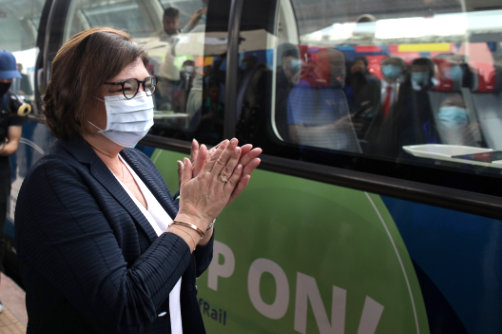
In December, the Commission presented proposals for revised Trans-European Transport Network guidelines, a revised Intelligent Transport Systems Directive and a new EU Urban Mobility Framework.
The Trans-European Transport Network is an EU-wide network of rail, inland waterways, short-sea shipping routes and roads. It links major cities, ports, airports and terminals. It is crucial to the functioning of the internal market as it ensures the efficient transport of goods and passengers. With the proposed measures, the network will be made greener, more efficient and more resilient.
Smart mobility makes transport safer and more sustainable. The revision of the Intelligent Transport Systems Directive will address the emergence of new road-mobility options, mobility apps and connected and automated mobility. It will stimulate the faster deployment of new, intelligent services by proposing that certain crucial road, travel and traffic data – such as speed limits, traffic circulation plans or roadworks – should be made available in digital formats.
The new Urban Mobility Framework proposal addresses some of the mobility challenges stemming from the intense activity in cities – including congestion, emissions and noise – for the benefit of transport users and all the people around them.
Cleaner and safer vehicles
Passenger cars and vans are together responsible for around 15 % of total CO2 emissions in the EU, therefore the cooperation of these sectors is crucial to achieving the EU’s emissions-reduction targets. More ambitious CO2 emissions standards are needed for new cars and vans to help increase the number of zero- and low-emission vehicles on EU roads. As part of the package to deliver on the European Green Deal, in July the Commission proposed to introduce more ambitious CO2 emission targets for new cars and vans from 2030 onwards:
- a 55 % reduction in emissions from cars by 2030,
- a 50 % reduction in emissions from vans by 2030,
- zero emissions from new cars by 2035.
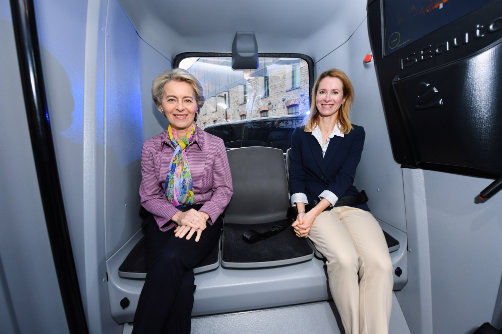
To support the greening of Europe’s transport fleet, the Commission has proposed an alternative fuels infrastructure regulation to guarantee that sufficient public charging and refuelling capacity is in place in every Member State to meet the demands of a growing fleet of zero-emission cars and lorries. The regulation would also ensure EU-wide coverage of charging infrastructure at fixed intervals along major transport corridors, so that drivers can easily recharge or refuel their electric or hydrogen-fuel-cell vehicles across the EU. Under the proposed rules, aircraft, ships and barges will have access to the electricity supply in major ports and airports.
Acting globally

The greatest temperature increases (of more than 3 degrees) have been recorded in North America, East Asia, the Middle East and North Africa, and Antarctic regions nearest to South America.
The COP26 Climate Change Conference took place in Glasgow on 1–13 November. At the start of the conference the EU set out three objectives.
- First, to get commitments to reduce emissions during this decade, to keep within reach the goal of limiting global warming to 1.5 °C.
- Second, to reach the target of providing $100 billion per year in climate finance to developing and vulnerable countries.
- Third, to reach an agreement on the Paris Agreement rulebook.
Progress was made on each of the objectives.
Under the Paris Agreement, 195 countries set a goal of keeping the average global temperature rise well below 2 °C and as close as possible to 1.5 °C. Before COP26, the planet was on course for a dangerous 2.7 °C of global warming. Based on new announcements made during the conference, experts estimate that likely scenarios now set the world on track for between 1.8 °C and 2.4 °C of warming. In the conclusions to the conference, parties have now agreed to revisit their commitments, as necessary, by the end of 2022 to limit global warming to 1.5 °C by the end of the century, maintaining the upper end of ambition under the Paris Agreement.
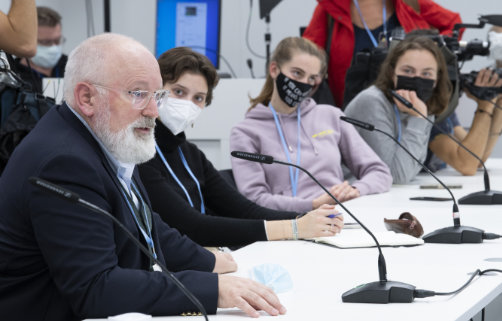
In order to deliver on these promises, COP26 participants also agreed for the first time to accelerate efforts towards the phase-down of unabated coal power and inefficient fossil-fuel subsidies, and recognised the need for support to manage a just transition.
At COP26, participants also completed the technical negotiations on the Paris Agreement rulebook, which fixes the requirements for all parties to track progress against their emission-reduction targets. The rulebook also sets out how international carbon markets will function, to support further global cooperation on emission reductions.
On climate finance, developed countries agreed to double the collective share of support to help other countries adapt to the consequences of climate change within the $100 billion annual target for 2021–2025, and to reach the existing goal of providing $100 billion per year to them as soon as possible. Parties also committed to a process to agree on long-term climate finance beyond 2025. The conference also decided to establish a dialogue between parties, stakeholders and relevant organisations to support efforts to avert, minimise and address damage associated with climate change.
The EU was also involved in the following announcements at COP26.
- The Global Methane Pledge, launched by the EU and the United States. Over 100 countries, representing 70 % of the global economy and almost half of anthropogenic methane emissions, have now committed to a collective goal of reducing global methane emissions by at least 30 % by 2030, compared to 2020 levels.
- The EU has pledged €1 billion over 5 years to support the Global Forests Finance Pledge. The EU will help partner countries protect, restore and sustainably manage forests worldwide. More than 100 world leaders, representing around 85 % of the world’s forests, promised to end and reverse deforestation by 2030.
- The EU, along with France, Germany, the United Kingdom and the United States, launched a Just Energy Transition Partnership with South Africa to accelerate the decarbonisation of South Africa’s economy, with a focus on the electricity system. With an initial commitment of $8.5 billion (around €7.4 billion) for the first phase of financing, the partnership will help South Africa achieve the ambitious emissions goals set out in its updated nationally determined contribution.
- The EU announced a donation of €100 million to the UN’s Adaptation Fund, making it the biggest contributor to the record total of $351.6 million.
- A partnership between the Commission, the European Investment Bank and Breakthrough Energy Catalyst – the EU–Catalyst Partnership – will mobilise up to €820 million ($1 billion) between 2022 and 2026 to accelerate the deployment of and rapidly commercialise innovative technologies that will help deliver European Green Deal ambitions and the EU’s 2030 climate targets. Each euro of public funds is expected to leverage €3 of private funds. Investment will be directed towards EU-based projects with a high level of potential in four sectors: clean hydrogen; sustainable aviation fuels; direct air capture; and long-duration energy storage.
There is still a lot of work ahead to keep global warming to 1.5 °C. The EU will now seek to implement the promises of the Glasgow conference as rapidly as possible, and will continue to work with its international partners to deliver on the Paris Agreement.
UN Biodiversity Conference
Participating virtually in the Davos Agenda – an online event bringing together leaders from businesses, governments, international organisations, civil-society organisations and academia – on 26 January 2021, Ursula von der Leyen, President of the European Commission, said that the UN Biodiversity Summit in Kunming, China, 'will have to be like COP21 was for climate. Because we need a Paris-style agreement for biodiversity’. The EU is leading efforts and working with like-minded partners to come to an agreement, at the 15th meeting of the Conference of the Parties to the Convention on Biological Diversity (COP15) in Kunming, on an ambitious post-2020 global biodiversity framework to halt and reverse the loss of the planet’s plants, animals and ecosystems. The first part of this summit took place in October 2021 and showed generally strong engagement across the globe, reflecting a growing awareness of the urgent need to address the ecological crisis. The Kunming Declaration needs to be translated into a concrete agreement that is scheduled to be adopted in spring 2022, during the second phase of the conference.
EU–Japan Green Alliance
In June, the EU and Japan announced their intention to create a Green Alliance to accelerate the transition of their economies towards becoming climate neutral, circular and resource efficient. Both Japan and the EU share the aim of becoming climate neutral by 2050. This is the first Green Alliance for the EU, and the increased cooperation with Japan will help the EU create a global coalition for net-zero greenhouse gas emissions.
Sustainable production and consumption
The new Circular Economy Action Plan, adopted in 2020, is a key pillar of the European Green Deal. To change the way we produce and consume, it addresses the entire life cycle of products, from design and manufacturing to consumption, repair, reuse, recycling and bringing resources back into the economy.
The Commission has taken action to ensure that the EU does not export its waste challenges to non-EU countries. The November proposal for a thorough review of EU rules on waste shipments will benefit the circular economy in several ways, both within and outside the EU.
- First, the proposal will improve the functioning of the EU internal market for waste for recycling and reuse, to boost the market for secondary materials and the circular economy (shipments within the EU).
- Second, it will reduce waste exports and guarantee that waste is only shipped outside the EU if it will be managed in an environmentally sound manner in the countries of destination.
- Third, the proposal will tackle illegal shipments by improving the system of enforcement and sanctions and by increasing transparency in the waste supply chain.
The Commission has proposed limit values for the presence of persistent organic pollutants in waste, to eliminate or minimise their emissions. This will ensure clean material cycles and secure trust in the markets for secondary raw materials and the products that use them. It will also ensure the highest level of protection of human health and the environment.
Sustainable food systems
In July, the Commission, together with 65 industry stakeholders, launched the EU Code of Conduct on Responsible Food Business and Marketing Practices, a deliverable under the Farm-to-Fork Strategy. The code has two aims: for EU associations to inspire their members towards specific goals, targets and initiatives, all geared towards making the sustainability transition work; and for frontrunner companies to make ambitious commitments covering areas such as animal welfare, cutting sugar and salt content and cutting greenhouse gas emissions.
The EU was an important contributor to the first UN Food Systems Summit, convened by António Guterres, the UN Secretary-General, in September. Outcomes include a statement of action, food-systems transformation pathways and more than 30 coalitions for action. The Commission contributes to the pathways and will actively engage in several of the coalitions. A global meeting will be organised every 2 years to review progress.
Agriculture, fisheries and rural areas
The new Common Agricultural Policy (CAP) for 2023–2027 was adopted on 2 December 2021. The secondary legislation that details the implementation of the new CAP will be adopted early in 2022. The new CAP will be greener, fairer and more flexible, with a stronger focus on innovation, while ensuring food security for people in the EU. It will be essential to achieving the objectives of the European Green Deal and its Farm-to-Fork and Biodiversity strategies. By the end of 2021, most Member States had submitted their strategic plans to implement the new CAP at the national level. The Commission will assess the plans, taking into account how they contribute to the 2030 targets set out in the two strategies. Following the Commission’s approval, the plans will apply from 2023.
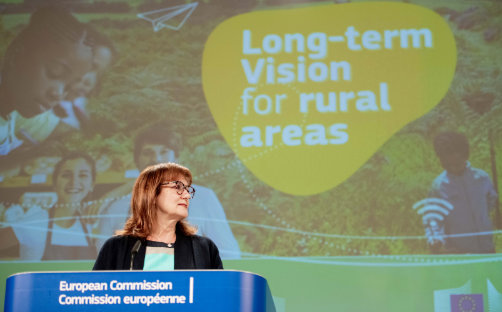
Rural areas cover 83 % of the EU’s territory and are home to 30 % of the population. The long-term vision for EU rural areas, launched in June, examines the socioeconomic challenges associated with achieving stronger, connected, resilient and prosperous rural areas by 2040. Such areas are key to the EU’s sustainability goals, providing food security and sustainable raw materials, improving water quality and biodiversity and acting as carbon sinks. The vision aims to revitalise rural areas and rethink development in line with the objectives of the European Green Deal, the sectoral EU policies, the NextGenerationEU recovery package, the Territorial Agenda 2030 and the UN Sustainable Development Goals, while countering negative demographic trends.
In cooperation with local, regional and national authorities, the vision will support, among other things, smart specialisation, environmental protection, the improved competitiveness of small and medium-sized enterprises, digitalisation and social inclusion.
In December, the Commission adopted a communication on sustainable carbon cycles, setting out how to remove more carbon from the atmosphere. To balance out the impact of its CO2 emissions, the EU will need to drastically reduce its reliance on fossil carbon, scale up carbon farming to store more carbon in nature and promote industrial solutions to sustainably and verifiably remove and recycle carbon. The communication sets out short-to-medium-term initiatives on carbon farming to better reward land managers for carbon sequestration and biodiversity protection. By the end of 2022, the Commission will propose an EU regulatory framework for the certification of carbon removals.

8.5% of total EU agricultural land is under organic farming. With the European green deal the EU aims to make it 25% by 2030. The percentages for the individual member states are Belgium 6.9%, Bulgaria 2.3%, Czechia 15.2%, Denmark 10.9%, Germany 7.7%, Estonia 22.3%, Ireland 1.6%, Greece 10.3%, Spain 9.7%, France 7.7%, Croatia 6.9%, Italy 15.2%, Cyprus 5.0%, Latvia 14.8%, Lithuania 8.1%, Luxembourg 4.4%, Hungary 5.6%, Malta 0.5%, Netherlands 3.7%, Austria 25.3%, Poland 3.5%, Portugal 8.2%, Romania 2.9%, Slovenia 10.3%, Slovakia 10.3%, Finland 13.5%, Sweden 20.4%.
In March, the Commission adopted an Action Plan for the Development of Organic Production in the EU. This aims to contribute to the European Green Deal target of having 25 % of agricultural land dedicated to organic farming by 2030, along with a significant increase in organic aquaculture. It will do so by stimulating consumer demand, expanding the production and supply of organic products and increasing the sustainability of the sector.
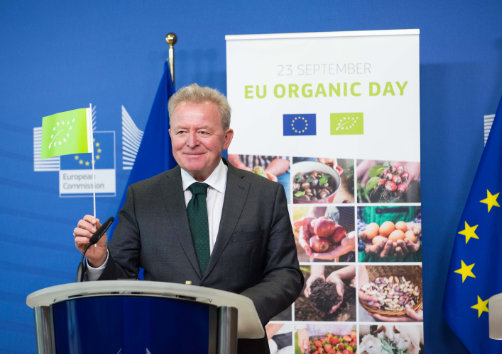
Member States are invited to set targets and to support measures for organic production under the new CAP and national action plans. The Commission also encourages Member States to include the increase in organic aquaculture production in their national strategic plans for aquaculture, which are currently under review by the Member States. Innovation, research and the exchange of best practices will receive a significant boost across the EU to support further sustainable expansion in organics. Support for organic aquaculture will also be available under the 2021–2027 European Maritime, Fisheries and Aquaculture Fund.
The COVID-19 crisis has shown the resilience of the EU agri-food sector. EU action ensured that the food supply lines continued to function, preventing the health crisis from being aggravated by food shortages. Mindful of the growing impact of climate change and environmental degradation on food production – along with risks related to public health, cyber threats or geopolitical shifts threatening the functioning of the food supply chain – in November the Commission adopted a contingency plan for ensuring food supply and food security in times of crisis, as envisaged under the Farm-to-Fork Strategy. This plan is based on cooperation between all of those involved in the food chain, to ensure preparedness in times of crisis.
European Maritime, Fisheries and Aquaculture Fund
The European Maritime, Fisheries and Aquaculture Fund, set up in 2021, supports the implementation of the EU’s Common Fisheries Policy, maritime policy and International Ocean Governance Agenda. The fund promotes the sustainable use and management of marine resources and the development of a resilient blue economy. As a global ocean actor and a major producer of seafood, the EU aims to protect and sustainably use the oceans and their resources, guaranteeing the availability of food supplies, the competitiveness of the maritime economy and the livelihoods of coastal communities. The fund is also helping to achieve the UN’s Sustainable Development Goal No 14 ('Conserve and sustainably use the oceans, seas and marine resources') and to fulfil the objectives of the European Green Deal.
Support from the fund is especially geared towards innovative projects that facilitate the transition to sustainable and low-carbon fishing; the protection of marine biodiversity; the supply of quality and healthy seafood; the economic and social vitality of coastal communities; the improvement of skills and working conditions in the fishing and aquaculture sectors; and international cooperation on healthy, safe and sustainably managed oceans. The total budget for 2021–2027 is €6.1 billion.
The blue economy
The EU’s blue economy, which encompasses all industries and sectors related to oceans, seas and coasts, is fundamental to the European Green Deal and the Recovery Plan for Europe. The EU’s new approach for a sustainable blue economy is an indispensable factor in meeting the EU’s environmental and climate objectives. It does so by promoting the development of offshore renewable energy, the decarbonisation of maritime transport and the greening of ports; introducing guidelines for sustainable aquaculture; and renewing standards for fishing-ge ar design, ship recycling and decommissioning offshore platforms.

By 2030, 30% of the EU’s seas will be protected areas. Currently, offshore energy plants have the capacity to produce 12 gigawatts of renewable energy. The target for 2050 is to ramp this capacity up to 300 gigawatts.
Furthermore, developing new green infrastructure in coastal areas will help preserve biodiversity and landscapes, while benefiting tourism and the coastal economy. The new approach provides coherence across the various blue economy sectors, facilitates their coexistence and looks for synergies in the maritime space. It also underlines the need for investment in research, skills and innovation.

International cooperation
The European Union has the ambition and the know-how to lead the world in the transition to a circular economy. It teamed up with the UN Environment Programme and the UN Industrial Development Organization to launch the Global Alliance on Circular Economy and Resource Efficiency on 21 February. The aim of the alliance is to support a global, just transition to a climate-neutral, resource-efficient and circular economy, to use resources more equitably and to achieve sustainable consumption and production. It builds on international efforts and puts the EU at the forefront of the green transition.
Environmental footprint methods
Improving the environmental performance of products and organisations is an essential part of the transition to a circular economy, and is necessary to achieve other European Green Deal objectives. In December, the Commission adopted a recommendation on the use of common environmental footprint methods to measure and communicate the environmental performance of products and organisations. This will help many people and organisations involved in environmental decision-making.
Protecting the environment and biodiversity
The zero pollution vision for 2050
Air, water and soil pollution is reduced to levels no longer harmful to health and natural ecosystems, thus creating a toxin-free environment.
Why do we need a Zero Pollution Action Plan?
- In the EU, every year, pollution causes 1 in 8 deaths.
- Pollution can cause cancer, coronary heart disease, obstructive pulmonary disease, mental and neurological conditions, diabetes and more.
- The most vulnerable groups are the hardest hit, creating further inequalities.
- Pollution is one of the five main drivers of biodiversity loss.
- Pollution is threatening the survival of more than 1 million of the planet’s estimated 8 million plant and animal species.
© GettyImages/Mario De moya F
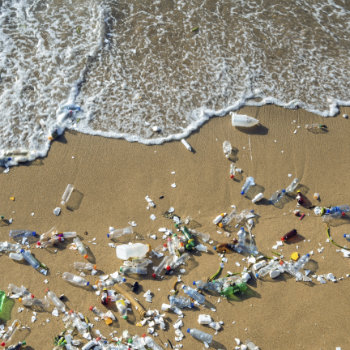
The Zero Pollution Action Plan –
targets for 2030


© GettyImages/hirun • © GettyImages/oticki
- Air. Reduce premature deaths caused by air pollution by more than 55 %.
- Water. Reduce waste and plastic litter at sea by 50 % and microplastics released into the environment by 30 %.
- Soil. Reduce nutrient losses and chemical pesticide use by 50 %.
- Biodiversity. Reduce the number of EU ecosystems in which air pollution threatens biodiversity by 25 %.
- Noise. Reduce the share of people chronically disturbed by transport noise by 30 %.
- Waste. Reduce total waste generation significantly, and residual municipal waste by 50 %.
In May, the Commission adopted the Zero Pollution Action Plan, to achieve zero pollution by 2050. This means that pollution will be reduced to levels that are no longer harmful to health or natural ecosystems. The action plan combines all relevant EU policies to tackle and prevent pollution of the air, water and soil, marine and noise pollution and pollution caused by consumer products. Along with the European Committee of the Regions, on 16 December the Commission launched the Zero Pollution Stakeholder Platform to bring together people from different communities and areas of expertise to tackle these interrelated challenges.
In 2021, the Commission implemented several of the 80 measures announced in the 2020 Chemicals Strategy for Sustainability. It established a high-level round-table conference to reach the strategy’s objectives in dialogue with the stakeholders concerned. To ensure that the most harmful chemicals will no longer be used in consumer products, except when essential for society, the Commission is revising legislation and setting criteria for the 'essential use' of a chemical. Funding opportunities for research on the impacts of chemicals on health and for the green transition to safe and sustainable chemicals were set up through Horizon Europe, LIFE, the Recovery and Resilience Facility, cohesion funds and InvestEU.
The European Environment Agency’s latest report on 'Air quality in Europe 2021', published in December, found that, despite improvements, air pollution is still a major health concern for people. Similarly, the 'Second clean air outlook' report highlighted that the full implementation of clean-air and climate measures could reduce premature deaths due to air pollution by 55 % in 2030 compared to 2005. The report also stressed that more could be done, as there are still plenty of measures for reducing air pollution that would bring more benefits than costs to society.
The plastic problem
in numbers
80–85 % of marine litter found on the EU’s beaches is plastic.
50 % of EU marine litter consists of single-use plastic items.
27 % is fishing gear that contains plastic.
Plastic causes €13 billion worth of damage to global marine ecosystems each year.
An estimated €630 million is lost each year by tourism and coastal communities in the EU due to plastic pollution.
Plastic costs the EU’s fishing industry an estimated €300 million a year.
Expected impact
Cut littering of the top-10 single-use plastic items by more than 50 %.
Prevent CO2 emissions of 3.4 million tonnes per year.
Prevent €22 billion worth of environmental damage by 2030.
Save consumers €6.5 billion a year thanks to less spending on throwaway products.
Out …
Single-use plastic items to be banned by 2021:
Cutterly
plates
straws
drink stirrers
cups and food and drink containers made of polystyrene (including lids)
cotton buds and balloon sticks
all products made of oxo-degradable plastic (widely used for shopping bags).
In …
- 2021 clear labelling of cups, wet wipes, sanitary pads, tampons and applicators, and tobacco products with filters, highlighting their plastic content, proper disposal methods and environmental risks.
- 2024 lids and caps made to stay on drinks containers and bottles with a capacity of up to 3 litres.
-
2025
plastic bottles made of at least 25 % recycled plastic.
separate collection of 77 % of plastic bottles with a capacity of up to 3 litres. - 2026 EU Member States to achieve ambitious and sustained cuts in consumption of single-use plastic cups (including lids/covers) and food containers, compared to 2022.
- 2029 separate collection of 90 % of plastic bottles with a capacity of up to 3 litres.
- 2030 plastic bottles made of at least 30 % recycled plastic.
Plastic waste accumulates in seas and oceans and on beaches in the EU and worldwide. The EU is taking action against plastic pollution. EU rules on single-use plastic products aim to prevent and reduce the environmental impact of certain plastic products by banning from the EU market single-use plastic plates, cutlery, straws, balloon sticks and cotton buds, along with cups, food and beverage containers made of expanded polystyrene and all products made of oxo-degradable plastic. To reduce plastic pollution and waste, the EU is promoting recycling. The Circular Plastics Alliance brings together 300 relevant stakeholders and has committed to ensuring that at least 10 million tonnes of recycled plastics find their way into new products in the EU by 2025.
Protecting the environment through criminal law
In December, the Commission adopted a proposal to strengthen the protection of the environment through criminal law, fulfilling a key commitment of the European Green Deal. The proposal intends to make protection of the environment more effective by obliging Member States to take criminal law measures. It defines new environmental crimes, sets a minimum level for sanctions and strengthens the effectiveness of law-enforcement cooperation. It also obliges the Member States to support and assist people who report environmental offences and who cooperate with the enforcement. This proposal will help to protect nature and natural resources, along with public health and well-being.
International Coral Reef Initiative
In February 2021, the EU joined the International Coral Reef Initiative. This will help the EU uphold the principles of the International Ocean Governance Agenda while supporting climate action and strengthening its commitment to protecting biodiversity. As part of its activities under the initiative, the EU is promoting its goal of protecting vulnerable marine ecosystems in cooperation with other like-minded organisations and countries. This includes adopting good practices in the sustainable management of coral reefs and associated ecosystems, capacity building and awareness raising.
Forests
The world’s forests are being damaged and destroyed at an alarming rate. Around 80 % of global deforestation is driven by agricultural expansion, and the EU is also a consumer of commodities linked to global deforestation, such as soy, palm oil, wood, cocoa and coffee. With a legislative proposal adopted in November to ban the access of commodities from deforestation to the EU market, the Commission is seeking to minimise the EU’s contribution to deforestation and forest degradation worldwide and to promote the consumption of products from deforestation-free supply chains in the EU.
Consumption of beef, palm oil, soy beans, wood, cocoa and coffee in the EU drives deforestation and forest degradation across the world. The EU aims to stop this by no longer allowing deforestationrelated commodities and products on the market.
© Avigator Fortuner/Shutterstock.com
Citizens supported EU action to tackle deforestation and forest degradation with 1.2 million responses to a public consultation.
Deforestation and forest degradation are important drivers of global warming and biodiversity loss. 23 % of greenhouse gas emissions come from agriculture, forestry and other land uses.
The new Deforestation Regulation will:
guarantee EU citizens that the listed products they buy, use and consume do not contribute to global deforestation and forest degradation;
reduce carbon emissions into the atmosphere due to EU consumption and production of the relevant commodities by at least 32 million tonnes a year, saving at least €3.2 billion annually and enhancing the contribution of forests to tackling climate change;
address illegal deforestation and forest degradation, along with any deforestation due to agricultural expansion caused by the production of the commodities.
The new EU Forest Strategy for 2030, adopted in July, will contribute to achieving the EU’s biodiversity and climate objectives. It recognises the central and multifunctional role of forests, and the role of foresters and the forest-based value chain in achieving a sustainable and climate-neutral economy by 2050 and preserving lively and prosperous rural areas. The strategy sets out a vision and concrete initiatives to improve the quantity and quality of EU forests and to invest in research and innovation as motors for change, and includes a pledge to plant 3 billion additional trees by 2030.
Healthy and biodiverse forests are also key to reducing the risk of wildfires, which once again wreaked havoc in several regions in Europe during the summer. The prevention, preparedness and response efforts under the EU Civil Protection Mechanism to fight forest fires are an integral element of EU action to protect people and nature. The Commission has continued to strengthen the EU’s aerial forest-firefighting capacities to address national shortcomings in responding to forest fires. The Commission also published new guidelines in March 2021 on land-based wildfire prevention and effective responses.
Soil strategy
Soils are home to a quarter of all biodiversity on the planet, and by 2050 they will need to feed a world population of nearly 10 billion people. However, here in the EU they continue to degrade. In November, the Commission adopted an EU Soil Strategy for 2030, along with a mission in the area of soil health and food under Horizon Europe to restore our soils and achieve the EU’s climate and biodiversity goals, while recognising the key role of farmers and foresters.
Healthy soils are essential for achieving climate neutrality, establishing a clean and circular economy, reversing biodiversity loss, providing healthy food, safeguarding human health and halting desertification and land degradation.
© LeQuangNhut/Shutterstock.com
© Photo by Becca Lavin on Unsplash
© design36/Shutterstock.com
The new EU Soil Strategy:
sets out a framework and concrete measures for the protection, restoration and sustainable use of soils , in synergy with other European Green Deal policies;
sets out a vision to achieve healthy soils by 2050 and its associated objectives, with concrete action by 2030;
announces a new Soil Health Law to be proposed by 2023 to ensure a level playing field and a high level of environmental and health protection, complementing the upcoming Nature Restoration Law.
Clean water
Most people living in the EU already enjoy very good access to safe drinking water, thanks in part to over 30 years of EU legislation on drinking-water quality. In January, the revised Drinking Water Directive entered into force. As a direct follow-up to the first-ever successful European Citizens’ Initiative, 'Right2Water', it includes measures to improve and maintain access to safe drinking water for everyone in the EU, in particular for vulnerable and marginalised groups. It also covers the latest scientific developments and contaminants of emerging concern, in line with the EU’s zero-pollution ambition.
The EU Strategy on Adaptation to Climate Change highlights the importance of measures such as nature-based solutions, reducing our water use and a stable supply of clean water. Within this framework, in December, the Commission published a report assessing Member States’ updated programmes of measures under the Water Framework Directive and the updated national preliminary flood-risk assessments under the Floods Directive.
Ivory trade
Despite an international ivory-trade ban under the Convention on
International Trade in Endangered Species,
elephant poaching and ivory trafficking recently reached record levels. In December, the Commission proposed
additional measures aimed at effectively banning most forms of EU trade in ivory. While the EU is not
identified as a region of concern regarding the illegal ivory trade, this revision of existing EU rules
reaffirms and delivers on the EU’s commitment to take further action against elephant poaching and ivory
trafficking globally. It also follows the commitment made in the EU Biodiversity Strategy to further tighten
the rules on the EU trade in ivory.
Revised Commission guidance on the EU regime governing the ivory trade notably
suspends the trade in raw
ivory on the EU market, while amendments to an existing Commission regulation ensure that any remaining
trade in antique ivory objects will always be subject to prior authorisation.

Eighth Environment Action Programme
The focus of the Eighth Environment Action Programme is on supporting the implementation of the European Green Deal at all levels of governance, and on monitoring progress. The programme builds on the long-term vision for 2050 of 'living well, within planetary boundaries' and sets out six priority objectives for the period up to 2030: climate mitigation, climate adaptation, the circular economy, zero pollution, biodiversity and tackling the main environmental and climate pressures.
The programme calls for good governance; sustainable finance; the integration of environmental concerns into all policy areas; a number of steps enabling the phasing out of environmentally harmful subsidies; and the development of knowledge and innovation to support the transition to an economy that promotes well-being. The proposed programme was endorsed by Member States in a provisional political agreement in December.
Research and innovation helping to deliver the European Green Deal
Over 35 % of the €95.5 billion budget of the Horizon Europe programme for 2021–2027 will be invested in research and innovation to address climate change and contribute to the objectives of the European Green Deal. In June, the Commission proposed a set of new European partnerships in the fields of climate, energy and transport. These partnerships will leverage more than €22 billion in private financial and in-kind contributions, and will promote the development and delivery of new technologies, materials and products with lower greenhouse gas emissions and better overall environmental performance.
In September, the Commission launched five new EU Missions – a new way of working together to tackle big challenges in health, climate and the environment. A novelty of Horizon Europe and an original concept in EU policy, bringing together several Commission services under the authority of nine members of the College of Commissioners, missions will support research to deliver on the Commission’s main priorities and find answers to some of the biggest challenges that society faces today. The missions include research and innovation projects, policy measures and legislative initiatives to deliver solutions to key global challenges by 2030. The Commission is making nearly €2 billion available from the Horizon Europe programme between 2021 and 2023 to launch the five missions, with further funding expected from other programmes. Of the five missions launched in September 2021, four aim to deliver on the objectives of the European Green Deal:
- Adaptation to Climate Change (which will support at least 150 European regions and communities in becoming climate resilient);
- 100 Climate-Neutral and Smart Cities;
- Restore our Ocean and Waters;
- A Soil Deal for Europe (100 living labs and beacons to lead the transition towards healthy soils).
In September and October, the Commission approved €1 billion in funding for 73 research and innovation projects to support the European Green Deal. Besides investing in core technologies across a wide spectrum – from energy sources and biomass to transport technologies and infrastructure – the call for projects also had two human-centric areas: strengthening knowledge and empowering citizens.
Sustainable finance
In April, the Commission adopted a package of initiatives to help improve the flow of finance towards sustainable activities across the EU. The EU Taxonomy Climate Delegated Act sets out the technical screening criteria for economic activities that make a substantial contribution to the climate objectives under the Taxonomy Regulation, with no significant harm to other EU environmental objectives. A proposal for a corporate sustainability reporting directive aims to improve the quality of sustainability information reported by companies. It will make their reporting on sustainability more consistent, so that financial firms, investors and the public have access to comparable and reliable information on companies’ risks and impacts as regards sustainability. Six amending delegated acts on fiduciary duties, investment and insurance advice were adopted to ensure that financial firms include information on sustainability in their procedures and their investment advice to clients.
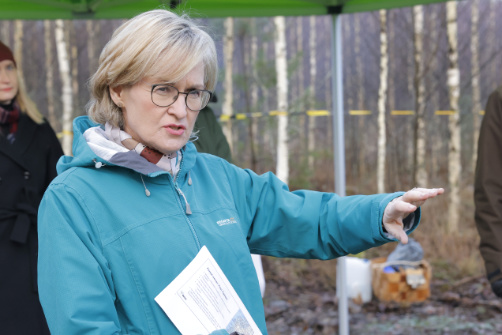
The Sustainable Finance Strategy adopted in July 2021 aims to support the financing of the transition to a sustainable economy through action in four areas: facilitating transition finance; supporting a more inclusive sustainable finance framework; strengthening work on the resilience and impact of the financial sector; and adapting to renewed global ambition.
Financing the transition to sustainability
This strategy provides the tools and policies to enable those involved across the economy to finance their transition plans and to reach climate and broader environmental goals, whatever their starting point.
Inclusiveness
This strategy caters for the needs of, and provides opportunities to, individuals and small and medium-sized enterprises to have greater access to sustainable finance.
Financial-sector resilience and contribution
This strategy sets out how the financial sector itself can contribute to meeting Green Deal targets, while also becoming more resilient and combating greenwashing.
Global ambition
This strategy sets out how to promote international cooperation for an ambitious global sustainable finance agenda.
In July, the Commission proposed a regulation on a European Green Bond Standard. This proposal aims to create a high-quality voluntary standard available to all bond issuers to help finance sustainable investments.
Green bonds are already used to raise finance in sectors such as energy production and distribution, resource-efficient housing and low-carbon transport infrastructure. While there is a lot of investor appetite for green bonds, there is potential to expand the market. The European Green Bond Standard will set a gold standard for how companies and public authorities can use green bonds to raise funds on capital markets to finance ambitious investments, while meeting tough sustainability requirements and protecting investors from greenwashing. In particular, issuers of green bonds will have a robust tool at their disposal to show they are funding green projects aligned with the EU taxonomy. Also, investors buying the bonds will be able to see more easily that their investments are sustainable, thereby reducing the risk of greenwashing.

A Europe fit for the digital age
© Unsplash/Laura Ockel
The COVID-19 pandemic has changed the role and perception of digitalisation in our society and economy, and has accelerated its pace. Digital technologies, which have been critical to maintaining economic and social life and to ensuring that education has continued during the crisis, will be the key differentiating factor in a successful transition to a sustainable, post-pandemic economy and society.
The European Union has the vision and the resources to make the digital transition a success. The level of financing available under the NextGenerationEU recovery plan will enable cooperation among Member States at the unprecedented scale and intensity necessary to achieve a successful digital transformation by 2030.
Europe’s Digital Decade
The EU is seizing this opportunity to make the next 10 years Europe’s Digital Decade, with the ambition of becoming a global role model for the digital economy, setting and promoting digital standards and pursuing digital policies that empower people and businesses.
These policies will focus on supporting small businesses in taking up technology; ensuring that technology works for people by equipping them with basic and advanced digital skills; and ensuring that everyone has access to the internet and to online public services. At the same time, the EU will also continue to pursue excellence in advanced technologies such as quantum and cloud computing and artificial intelligence (AI), which can tackle many of the challenges facing our society today.
Achieving the EU’s ambitions will involve addressing the issues highlighted by the pandemic, from gaps in connectivity and digital skills to the divide between digitally apt businesses and those yet to adopt digital solutions. Digitalisation offers many new job opportunities. For example, more than 500 000 vacancies for cybersecurity and data experts in the EU remained unfilled in 2020.
Europe’s Digital Compass translates the EU’s digital ambitions for 2030 into actions and results.
These focus on:
- achieving a digitally savvy population and highly skilled digital professionals;
- trustworthy and secure digital infrastructure;
- a high share of digitalised businesses;
- modernised public services that respond to society’s needs.

Concerning digital skills, 56% of adults currently have basic digital skills, with a target of 80%. There are 8.4 million ICT specialists employed, with a target of 20 million. Concerning digital infrastructure, 59% of households currently have a gigabit network coverage, with a target of 100%. 5G covers 14% of populated areas, with a target of 100%. Concerning the digital transformation of businesses, 42% of businesses use cloud computing services at the moment, and the target is 75%. 14% of businesses use big data, with a target of 75%. 25% use artificial intelligence, with a target of 75%. 55% of small and medium-sized enterprises currently have at least a basic level of digital intensity, with a target of more than 90%. Finally, there are 112 unicorn start-ups in the EU today, and the target is to double this number. Concerning the digitalisation of public services, online access to key public services (for instance those related to career, studying, family, regular business operations or moving from one Member State to another) is available to 75% of citizens and 84% of businesses, with a target of 100% for both. Moreover, the EU’s aim is for 100% of people in the EU to have access to digital health records and 80% of them to use a digital ID.
The European Commission is finalising a proposal to be made in 2022 for a joint declaration on digital principles by the European Parliament, the Council of the European Union and the Commission to ensure EU values and rights are reflected in the digital space. This will ensure that everyone can enjoy the benefits of digital opportunities, such as universal access to the internet, algorithms that respect people and a secure and trusted online environment. According to the special Eurobarometer survey conducted in September and October 2021, an overwhelming majority of EU citizens think that the internet and digital tools will play an important role in the future. Moreover, a large majority of people find it useful for the EU to define and promote European rights and principles to ensure a successful digital transformation. Prior to that, the Commission also conducted an open public consultation on the digital principles, which showed broad support for the initiative.
In September, the Commission proposed a plan to deliver the EU’s digital transformation by 2030. The Path to the Digital Decade aims to set up a robust governance framework so that Member States can work collectively towards the agreed objectives while recognising their different starting points. This includes a monitoring system to measure progress towards each of the 2030 targets and multiannual roadmaps for each Member State, in which they will outline their adopted or planned policies and measures. Multi-country projects will pool EU, national and private resources to achieve progress in critical areas that no Member State could achieve on its own.
Multi-country projects will facilitate investment in areas such as the following.
Common data infrastructure and services
Blockchain
Low-power processors
Pan-European deployment of 5G corridors
High-performance computing
Secure quantum infrastructure and network of cybersecurity centres
Digital public administration
Digital innovation hubs
High-tech partnerships for digital skills
The international dimension of the Digital Compass is being developed through a number of digital partnerships. The Trade and Technology Council was launched at the EU–US Summit in June 2021. Since then, 10 working groups have begun to identify possible deliverables over the short, medium and long term. A digital partnership with Japan is also under discussion, and the EU is working to establish a digital partnership with Africa and a digital alliance with Latin America and the Caribbean.
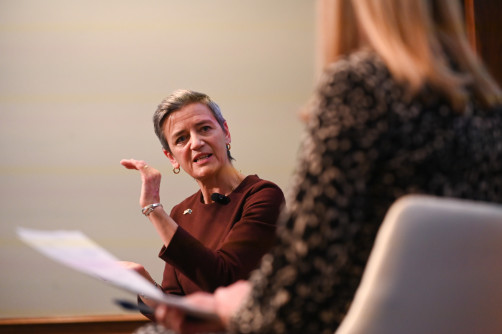
Digital education
In August, the Commission published a proposal for a Council recommendation on blended learning to support high-quality and inclusive primary and secondary education. The Council adopted this recommendation in just 4 months.
Blended learning can help make education more inclusive, in particular due to its flexibility. The term describes when a school, educator or student takes more than one approach to the learning process. It can be a blend of school site and other physical environments (such as companies, training centres or distance learning), or a blend of various digital and non-digital learning tools. Blended learning can, for example, mean better access to education in remote and rural areas, or for people who are part of traveller communities, or for those in hospital. A focus on the development of a blended-learning approach in primary and secondary education will be included in the regular progress reports on the European Education Area and the 2021–2027 Digital Education Action Plan.
Digital Europe Programme
With a budget of €7.5 billion over the next 7 years, the new Digital Europe Programme is the first EU funding programme focused on bringing digital technology to public administrations, businesses and citizens. The first work programmes, worth €1.98 billion, focus on investment in the areas of AI, cloud and data spaces, quantum communication infrastructure, advanced digital skills, cybersecurity and the wider use of digital technologies across the economy and society. The first calls for the Digital Europe Programme were published at the end of November, and more will be released in 2022.
Digital Services Act and Digital Markets Act
The Digital Services Act and the Digital Markets Act, proposed by the Commission in December 2020, aim to create a safer and more open digital space for all users, where their fundamental rights are protected and where they have access to quality digital services at lower prices. Agreement on these proposals is expected in 2022.
Cybersecurity, data protection and safety online
With social and economic life shifting online more and more, cyberattacks are becoming a regular occurrence, and are increasingly harmful. In 2021, ransomware attacks were used globally to destabilise healthcare systems, public administrations, energy-production facilities and other critical infrastructure. The EU is not immune to these kinds of attacks.
Good protection from cyberattacks requires unified action beyond national borders. Therefore, as part of the EU Cybersecurity Strategy, in 2021 the Commission began setting up the Joint Cyber Unit, a new platform that aims to strengthen cooperation between the EU institutions and agencies and national authorities in the Member States. The new unit will also benefit from the expertise of the cybersecurity industry, helping the whole of the European Union to respond to cyber threats. The work to make the Joint Cyber Unit operational is ongoing.
Following the adoption and entry into force of the Regulation establishing the European Cybersecurity Industrial, Technology and Research Competence Centre and the Network of National Coordination Centres, the Commission has started to work alongside Romanian authorities to set up the centre in Bucharest. It will help strengthen the EU’s cybersecurity capacities, boost excellence in research and improve the competitiveness of the European cybersecurity industry.
Goals of the Joint Cyber Unit
Ensure a coordinated EU response to large-scale cybersecurity threats, incidents and crises.
Improve the situational awareness of cybersecurity stakeholders and communication to the general public.
Guarantee joint preparedness.
Data protection
Ensuring data protection and privacy is a prerequisite for individuals to be able to trust new and innovative technologies. In this sense, data protection and privacy are part of the solution to many problems, and enablers for the twin digital and green transitions.
The EU’s leadership on data protection shows that its rules in this area can act as the gold standard for the regulation of the digital economy. In particular, when non-EU countries ensure a level of data protection equivalent to the EU, the EU can make use of its most comprehensive instrument for data transfers, known as an adequacy finding. On that basis, data can flow freely and safely between the EU and the respective country, facilitating trade and improving the effectiveness of regulatory and law-enforcement cooperation to the benefit of citizens and business.
Following the creation of the world’s largest area of free and safe data flows with Japan in 2019, the EU has continued to work with international partners towards the convergence of data-protection rules to facilitate data transfers, all while ensuring a high level of protection of personal data transferred abroad.
In 2021, the EU adopted two adequacy decisions for the United Kingdom, including one covering, for the first time, data exchanges between criminal-law-enforcement authorities. It also successfully concluded its talks with South Korea, resulting in the adoption of an adequacy decision for transfers in both the commercial and regulatory-cooperation areas. In addition, throughout 2021, negotiations took place between the EU and the United States on a possible successor arrangement to the Privacy Shield framework, following its invalidation by the Court of Justice of the European Union.
In 2021, the Commission also adopted new standard contractual clauses for the processing of personal data. These clauses help organisations comply with data-protection rules both when they outsource processing operations to processors inside the EU / European Economic Area and when they transfer data abroad.
The Commission also took steps to ensure that Member States comply with their obligations under EU data-protection rules. In February, the Court of Justice ruled that Spain had failed to transpose the directive on data protection in the law-enforcement field on time. The Court imposed financial penalties on Spain. Following the judgment, Spain took the necessary steps to end this infringement.
European Digital Identity
Many people are already using digital wallets on their smartphones to store their boarding passes when they travel or for virtual bank cards, and 63 % of EU citizens want a secure single digital ID for all online services. Under proposed new rules, put forward by the Commission in June, a European Digital Identity wallet will be available to any citizen, resident or business in the EU that wants to use it. These are personal digital wallets that let people store and use data for all kinds of services, from filing a tax return to renting a car.
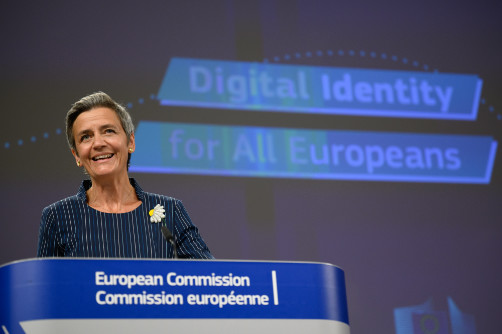
Citizens will be able to safely prove their identity and share electronic documents from their European Digital Identity wallets on their smartphone. They will be able to access online services with their national digital identification, which will be recognised throughout the EU. The European Digital Identity will help achieve some of the targets of the Digital Compass. For example, by 2030, all key public services should be available online, all citizens should have access to electronic medical records and 80 % of citizens should be using digital ID.
Advanced connectivity
The Commission adopted the first work programme for the digital part of the Connecting Europe Facility (CEF Digital), defining the objectives of the EU-supported measures needed to improve the EU’s digital connectivity infrastructure over a 3-year period. These measures will receive more than €1 billion in funding from 2021 to 2023. By fostering public and private investment, CEF Digital will contribute to deploying gigabit and 5G infrastructure, equipping the EU’s major transport routes and communities with 5G networks, interconnecting advanced technologies such as cloud and quantum services and, finally, creating operational digital platforms for the storage, sharing and processing of energy- and transport-sector data.
The Smart Networks and Services Joint Undertaking, working towards 6G, was established in 2021, and adopted its first work programme with earmarked public funding of about €240 million. The joint undertaking’s mission is to build the EU’s capacity for 6G systems.
A better deal for consumers
Following the 2020 recommendation calling for increased investment in broadband, in March the Member States agreed on a common EU toolbox of best practices. It aims to reduce the cost of deploying very-high-capacity networks and to ensure timely, efficient and investment-friendly access to the 5G radio spectrum.
Roaming charges were abolished in 2017, since when people have been able to use their phone without additional charges when travelling in the EU. To ensure they can continue to enjoy free roaming, in February the Commission proposed to prolong the current rules, which are due to expire in 2022, for another 10 years. The Parliament and the Council adopted the regulation in December, and it will enter into force on 1 July 2022. The new rules will ensure even better roaming services for travellers. The new benefits include the same mobile data speeds abroad as at home, efficient access to emergency services abroad and greater transparency of the costs of calling hotlines and customer service numbers when abroad.
Protecting consumers online
Online sales have increased steadily over the last 20 years, and in 2020 some 71 % of consumers shopped online, often buying new technology products. In June, the European Commission proposed to revise two sets of EU rules to enhance consumer rights in the light of these changes.
The new General Product Safety Regulation would, if adopted, address risks related to these new technology products, such as any possible connectivity or cybersecurity risks. It would also address possible risks related to online shopping, for example by introducing product-safety-related bligations for online marketplaces. The new regulation would make certain that marketplaces fulfil these duties so that consumers are not offered or do not end up with dangerous products. The proposal aims more broadly at ensuring that all products reaching EU consumers, whether bought online or from the local shop, are safe, whether they come from within or outside the EU. In the event that dangerous products reach consumers, the new rules would aim to ensure they are swiftly removed from EU markets.
The proposal for a revised Consumer Credit Directive aims to ensure that consumers receive the right information at the right time, adapted to digital devices, so that they understand exactly what they are signing up for. The directive, if adopted, would cover new risky credit products and new market players, and would improve rules for assessing whether or not a consumer would be able to repay the loan, including when such assessments are made through automated decision-making. The revised directive would ask Member States to promote financial education and ensure advice on debt is made available to consumers.
In December, the Commission issued guidance notices on the interpretation and application of three EU consumer-law directives: the Unfair Commercial Practices Directive, the Consumer Rights Directive and the Price Indication Directive. These will help Member States, consumers, traders, judges, legal practitioners and other stakeholders to better understand both how to apply existing EU consumer law to new practices, in particular concerning the digital and green transitions, and the recent changes made to these directives by the Modernisation Directive.
Pulling the plug on consumer frustration and electronic waste
Consumers
€2.4 billion
is spent yearly by consumers on standalone chargers.
38 % of consumers
complain of problems caused by non-compatible chargers.
Environnement
11 000 tonnes
of e-waste is produced annually from disposed of and unused chargers.
Only 2 out of 3 chargers owned
are used by consumers.
After years of working with the electronics industry on a voluntary approach, which has already helped to reduce the number of different types of mobile phone chargers from 30 to three, in September the Commission proposed legislation for a common charger for all electronic devices. USB-C will become the new standard charging port for all smartphones, tablets, cameras, headphones, portable speakers and handheld video-game consoles. In addition, the Commission proposed to separate the sale of chargers from the sale of electronic devices. A single charging solution will be more convenient for people and will reduce electronic waste – an important contribution to both the digital and the green transitions.
Consumers
Help consumers save €250 million a year on unnecessary charger purchases.
Environnement
Reduce e-waste by almost 1 000 tonnes annually.
Skills for the digital age
In May, the Commission, together with various partners in the Member States, launched the Digital Skills and Jobs Platform, a one-stop shop for high-quality information, initiatives and resources on digital skills. At a time when 44 % of people in the EU lack basic digital skills, the new platform will help close the skills gap and strengthen the Digital Skills and Jobs Coalition and its 25 national coalitions. In November, the Commission published a free-to-use self-assessment tool for digital skills, in 29 languages.
Digital for industry
To strengthen the EU’s position in building the next generation of microchips, the Commission launched the Industrial Alliance for Processors and Semiconductor Technologies in July. The alliance aims to set up the design and manufacturing capacity needed to produce the next generation of processors and electronic components. It will identify and address current bottlenecks, needs and dependencies across the entire industry. It builds on the Commission’s ambitions to improve the EU’s technological sovereignty by increasing its share of the global production of semiconductors from 10 % to 20 % by 2030. In her State of the European Union address, Commission President Ursula von der Leyen announced a European Chips Act to create a state-of-the-art EU chip ecosystem, including production. The proposal was adopted at the beginning of 2022.
Digital transformation
Artificial intelligence
AI, including the latest machine-learning techniques, is used to create innovations in a wide variety of fields, leading to better services, medical care and consumer goods. However, people in the EU need to know they can trust that AI systems are used in a safe and legally compliant way. While such systems can be used to solve many challenges facing society today, some create risks that need to be addressed to avoid undesirable outcomes. For example, it is often not possible to find out why or how an AI system has generated a certain result, such as an automated decision or a prediction. It may therefore become difficult to assess whether someone has been unfairly disadvantaged, such as in a hiring decision or in the distribution of social-security benefits.
To address these and other challenges, in April the Commission published its proposal for the world’s first legal framework on AI, accompanied by an updated Coordinated Plan with Member States. Both initiatives aim to turn the European Union into the global hub for excellent and trustworthy AI. New rules on machinery products will complement the EU’s approach by adapting safety rules to increase users’ trust in the new, versatile generation of products. The new General Product Safety Regulation, if adopted, would complement these rules as a safety net.
The new AI Regulation will help guarantee the safety and fundamental rights of people and businesses, while strengthening the uptake of, investment in and innovation relating to the technologies across the EU. The proposal sets out a risk-based approach, recommending stricter requirements for riskier AI systems.
The Coordinated Plan outlines the policy changes and investment necessary in the Member States to strengthen the EU’s leading position in the development of human-centric, sustainable, secure, inclusive and trustworthy AI. The plan proposes joint initiatives for collaboration to ensure that all efforts are aligned with the Strategy on AI and the European Green Deal, while taking into account new challenges brought about by the COVID-19 pandemic.
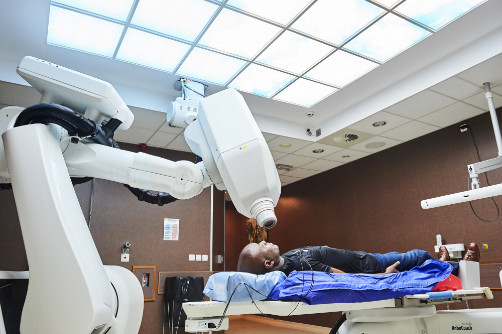


The EU has already funded a variety of AI projects offering solutions in many areas of society, including agriculture, healthcare and fighting disinformation.
European Alliance for Industrial Data, Edge and Cloud
Data is an important resource in the industrial economy, and is increasingly being stored in the cloud. Businesses can access computing resources hosted by third parties on the internet instead of building their own IT infrastructure. This pool of resources is most commonly known as cloud computing. In 2021, 42 % of EU businesses used cloud computing (compared to 36 % in 2020 and 19 % in 2016). It is forecast that by 2025, 80 % of all data will be processed in smart devices closer to the user – known as edge computing – instead of in large data centres like today.
For these reasons, the new European Alliance for Industrial Data, Edge and Cloud aims to strengthen the position of EU industry in cloud and edge technologies, while bringing together businesses, Member States and experts in the field. The alliance will help unlock the power of cloud and edge computing and support the development of emerging technologies, such as artificial intelligence, the internet of things and 5G. It will achieve this while providing sustainable cloud infrastructure and ensuring that people in the EU have more control over their data.

In 2018, 80% of the processing and analysis of data took place in data centres and centralised computing facilities, and 20% used smart connected objects. In 2025, 20% of the processing and analysis of data will take place in data centres and centralised computing facilities, and 80% will use smart connected objects.
Supercomputers
With larger and larger amounts of data constantly being generated, the nature of computing is changing. Today, supercomputers can perform millions of billions – and soon billions of billions – of operations per second, and are helping to solve complex problems. These range from analysing and mitigating the effects of climate change and boosting knowledge in various scientific fields to developing treatments for COVID-19.
To enable the EU to become a world leader in supercomputing, the European High-Performance Computing Joint Undertaking was created in 2018 to pool European and national resources to acquire and deploy top-of-the-range supercomputers and technologies. The initiative brings together the EU, the 27 Member States, three other countries and two private-sector members: the European Technology Platform for High Performance Computing and DAIRO / Big Data Value Association.
In July 2021, the EU adopted a new regulation that paves the way for the development of the next generation of supercomputers in Europe. Moreover, this will trigger the joint undertaking’s capacity to draw funds from Horizon Europe, the Digital Europe Programme and CEF Digital to further invest in supercomputing and quantum computing, and to support the EU’s ambitious research-and-innovation agenda. Together with the investment from the participating countries and the private-sector members, this investment will be worth around €7 billion.
The EU has acquired seven world-class supercomputers. Discoverer in Bulgaria, MeluXina in Luxembourg and Vega in Slovenia became fully operational in 2021, with the inauguration of Karolina in Czechia, Leonardo in Italy, Deucalion in Portugal and LUMI in Finland to follow in 2022.
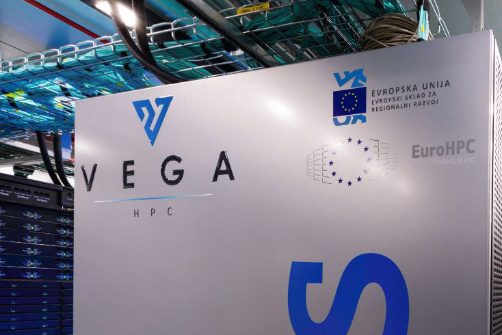
Digital finance
In 2021, the Commission made progress with the co-legislators on the Markets in Crypto Assets and Digital Operational Resilience Act files, which it had proposed in September 2020 as part of its digital finance package. In addition, in December, the Member States endorsed the agreement reached with the Parliament on a pilot regime for market infrastructures based on distributed ledger technology (DLT). Crypto-assets are one of the main DLT applications for finance. The pilot regime lays down the conditions for acquiring permission to operate a DLT market infrastructure, defines which DLT financial instruments can be traded and details the cooperation between the operators of DLT market infrastructure and authorities. It will allow EU regulators and market participants to gain experience in using DLT (i.e. the technology used for the trading and settlement of 'tokenised' financial instruments), while ensuring that they can deal with risks to investor protection, market integrity and financial stability.
International connectivity
Connecting Sines in Portugal and Fortaleza in Brazil, the EllaLink transatlantic cable represents the first direct, high-capacity data connection between Europe and Latin America. The EU has helped to create a 34 000 km digital highway to support the exchange of research and education data, while cutting the time delay in half. This important milestone will help foster more collaborations between the two continents over the next 25 years. Overall, the Building the Europe Link with Latin America initiative, including the sharing of high-performance computing and Earth-observation data, will reach 65 million users across more than 12 000 education and research institutions in Europe, Latin America and the Caribbean.

Protecting people and freedoms
A healthier European Union
The COVID-19 pandemic has put public health at the top of the EU’s agenda. Since President Ursula von der Leyen announced, in September 2020, the intention to build a stronger European Health Union, the European Commission has laid the foundations for it, learning from the pandemic.
Preparing for and responding to health crises
The first pillar of the Health Union is crisis preparedness and response. EU legislation on cross-border health threats is under revision to take into account lessons learnt from COVID-19. The European Medicines Agency and the European Centre for Disease Prevention and Control, which have been bulwarks in the fight against COVID-19, are receiving a stronger mandate to deal with future health emergencies. It is envisaged that these key EU health agencies will provide more scientific guidance and increased coordination during emergencies. The risk of medicine shortages will be reduced thanks to better monitoring and improved preparedness. If the Commission’s proposals are agreed, when circumstances call for it, it will be possible to declare a public-health emergency at the European Union level, enabling the introduction of certain measures for a stronger response.
While the COVID-19 pandemic is not over yet, the EU must be prepared for future cross-border health threats. In June, the Commission presented a communication on the first lessons learnt from the pandemic, and on how to build on them to improve action at the EU and national levels. This will help to better anticipate public-health risks and enhance contingency planning, leading to swifter and more effective joint responses at all levels. The communication focuses on health preparedness and response, and draws on 10 early lessons from the health crisis on where the EU needs to act.
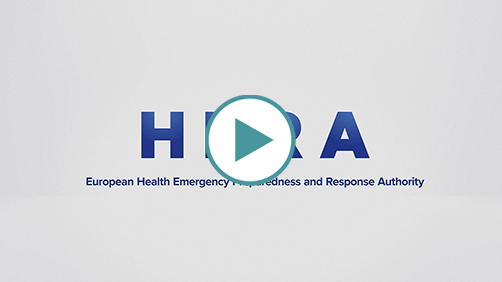
As part of its response, the Commission launched the European Health Emergency Preparedness and Response Authority (HERA). A central element of the European Health Union, HERA is to operate in two different modes: a preparedness mode and an emergency mode. Overall, the authority will improve the EU’s development, manufacturing, procurement and distribution of key medical countermeasures (e.g. vaccines, antibiotics, medical equipment, diagnostic tests and personal protective equipment) within the EU.
The package establishing HERA was adopted on 16 September. The authority started its work on 1 October, building on the foundations laid by the HERA Incubator, which started operations in February 2021 to prepare the EU for the increased threat of coronavirus variants. HERA has been operational since 1 January 2022, with a total indicative budget of €6 billion for 2022–2027.
During its preparedness mode, HERA will work on threat assessments and intelligence gathering; promoting research and development; addressing market challenges; ensuring the provision of medical countermeasures; and strengthening knowledge and skills.
HERA’s emergency measures include monitoring, procuring, purchasing and manufacturing crisis-relevant medical countermeasures, activating EU FAB facilities (a network of production facilities for vaccine and medicine manufacturing that are always ready to be brought into operation), activating emergency research and innovation plans, establishing an inventory for crisis-relevant medical countermeasure production facilities and facilitating emergency funding.
The authority will be tasked with several activities at the international level. These include collaborating with global partners to address international-supply-chain bottlenecks; expanding global production; reinforcing global surveillance; and facilitating cooperation with and support for global stakeholders to ensure the availability and accessibility of medical countermeasures for EU Member States and non-EU countries. They also include building up expertise to develop local manufacturing and distribution capacities and supporting access to EU-funded or EU-procured medical countermeasures.
HERA is working with Member States, the European Parliament, EU agencies and stakeholders – such as researchers, biotech companies, manufacturers and regulators – to detect and characterise new variants rapidly, adapt vaccines as necessary and scale up production capacities for medical countermeasures. For example, it mobilised the Expert Group on SARS-CoV-2 Variants to advise on the need to develop new or adapted vaccines, and on the need to develop additional public-health measures at the EU level because of newly emerging variants. It has also been liaising closely with Member States and vaccine producers that have begun to analyse the Omicron variant and to test the effectiveness of their vaccines against it. Beyond this, HERA is also in contact with non-EU countries to explore areas for cooperation and exchange.
Europe’s Beating Cancer Plan
The second pillar of the Health Union tackles the second-biggest killer in the EU. In 2020, 2.7 million people in the EU were diagnosed with cancer, leading to a significant physical and mental toll on patients, survivors and their loved ones. Cancer also creates a significant burden on health and social systems, and jeopardises the growth and competitiveness of the economy and the health of the workforce. However, 40 % of cancers are preventable forms, meaning that they are linked to lifestyle (diet, physical activity, tobacco use, alcohol consumption, etc.) or environmental pollution, or that a vaccine against them is available.
Europe’s Beating Cancer Plan, adopted in February 2021, aims at tackling the disease at every stage through an integrated, health-in-all-policies and multistakeholder approach. It is built around 10 flagship initiatives to deliver improvements – from prevention, early detection, diagnosis and treatment to better quality of life for cancer patients and survivors, while ensuring patients receive equal access to high-quality healthcare.
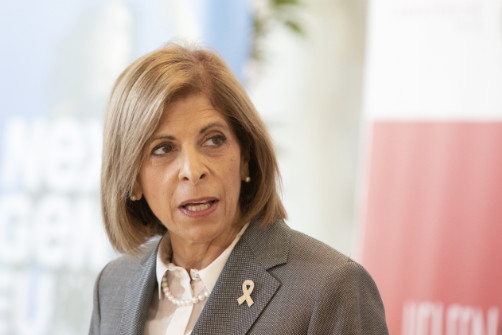
The Horizon Europe EU Mission on Cancer – one of five new EU Missions announced in September 2021 – will work with the Beating Cancer Plan to improve the lives of more than 3 million people by 2030 through better prevention, more effective treatments and increased quality of life. Overall, the EU4Health programme and other EU instruments will provide support amounting to around €4 billion to Member States and stakeholders in their efforts to make health systems more robust and better able to address cancer prevention and care.

The key actions focus on prevention, diagnosis, treatment and quality of life. They aim to reduce environmental pollution and the harmful consumption of alcohol and tobacco, promote healthier lifestyles, ensure access to breast, cervical and colorectal cancer screenings for 90% of the eligible EU population by 2025, vaccinate at least 90% of girls in the EU against human papillomavirus and increase the vaccination of boys significantly by 2030, and ensure access to national comprehensive cancer centres for up to 90% of eligible patients by 2030. This is possible thanks to 4 billion euro in funding. There are over 12 million cancer survivors in the EU thanks to advances in early detection, effective therapies and supportive care.
Pharmaceutical Strategy for Europe
The third pillar is the Pharmaceutical Strategy for Europe, launched in 2020. It represents a complete overhaul of the EU’s systems for medicines. It will address long-standing challenges to the EU pharmaceuticals system, foster innovation (including for unmet medical needs) and safeguard the availability of medicines, not only in crisis situations but also in normal times. Its flagship measures include a revision of the EU’s pharmaceuticals legislation and the structured dialogue on security of medicines supply. The latter is a process that began in February 2021 and aims to identify the policy measures that would strengthen the resilience of pharmaceutical supply chains and ensure secure supplies of medicines.
The Commission is investing more than ever in these urgent health priorities. The new EU4Health programme, which was launched in March, is the EU’s ambitious response to the COVID-19 pandemic. It goes beyond crisis response, and will look to improve and foster health in the EU, strengthen national healthcare systems and improve access to medicines, medical devices and crisis-relevant products.
With EU4Health, the EU will invest €5.3 billion, in current prices, in initiatives where acting at the EU level provides added value, complementing Member States’ policies and pursuing one or several of EU4Health’s objectives.
Improve and foster health in the EU.
Protect people in the EU from serious cross-border threats to health.
Improve medicinal products, medical devices and crisis-relevant products.
Strengthen health systems.
Strengthening our democracy
The democratic debate and the ways that people access information have transformed in recent years, moving increasingly online. At the same time, more EU citizens than ever before are exercising their democratic right to vote and to stand in European Parliament and municipal elections in their Member State of residence. In addition, political advertising has grown in importance in relation to campaigning in the EU. To reflect this changing climate, and to reinforce democracy and the integrity of elections, in November the Commission set out new proposals on political advertising, on the electoral rights of EU citizens who have exercised their right to free movement and on the funding of European political parties.
The proposals build on the experience gained during the 2019 European elections and deliver on the priorities announced in the European Democracy Action Plan and the EU Citizenship Report 2020. To ensure that the 2024 elections to the European Parliament take place under the highest democratic standards, the aim is for the new rules to enter into force and for Member States to implement them in full by spring 2023.
Political advertising
Digital communication and the internet provide many opportunities for politicians to reach citizens and for citizens to participate in democratic debate. However, experience in some recent elections shows that digitalisation and online advertising can sometimes be used for manipulation and disinformation (see also Chapter 1 on action against disinformation).
In November, the Commission proposed legislation to ensure greater transparency in political advertising. Harmonised transparency requirements will include providing relevant information to enable citizens, competent authorities and other relevant stakeholders to clearly identify a political advertisement and to ascertain both the origin of the political message and who paid for it. Targeting and amplification techniques will only be allowed if they meet meaningful transparency requirements. This will empower individuals to determine whether and how they are targeted by political advertising, and to decide whether they want it or not.
The proposal will complement the rules set out in the Commission’s proposal for a Digital Services Act, with the aim of having dedicated rules in place ahead of the May 2024 European Parliament elections.
Media freedom
908 journalists and media workers, in 23 Member States, were attacked in 2020.
175 journalists and media workers were victims of attacks or incidents during protests in the EU in 2020.
73 % of female journalists experienced online violence in 2020.
23 journalists have been killed in the EU since 1992, with the majority of killings happening in the past 6 years.
Media freedom is vital to a functioning democracy. Delivering on the European Democracy Action Plan, the EU is taking action to preserve media freedom and counter the threats that it is facing. In September, the Commission made a recommendation on the safety of journalists. It provides guidance to Member States on how to improve the physical and online safety of journalists and media professionals, with a focus on new online threats, in particular against female journalists or those representing or reporting on minorities.
A further step is to protect journalists and rights defenders from abusive lawsuits that aim to dissuade them from becoming involved in matters in the public interest. In October, the Commission launched a public consultation to identify problems in this area and to ask for views on what needs to be done. A Commission proposal for an EU initiative on this issue is due in 2022. The EU also funds projects on media freedom and pluralism. One such project is the Euromedia Ownership Monitor, launched in September 2021 to provide a country-based database of information on media ownership, assess relevant legal frameworks and identify possible risks to media-ownership transparency.
The Commission also rolled out measures outlined in the Media and Audiovisual Action Plan. For example, over the summer, the Commission launched a call for European journalism partnerships under the Creative Europe programme. The Commission also prepared the next steps, with the announcement by President von der Leyen, in her 2021 State of the Union address, of the Media Freedom Act, to be adopted in 2022. In parallel, the Commission continued monitoring the situation of media freedom and pluralism across all Member States as part of its annual rule-of-law report.
In parallel, the Commission continued monitoring the situation of media freedom and pluralism across all Member States as part of its annual rule-of-law report.
Safeguarding the rule of law
In July, the Commission published its second annual report on the rule of law in the EU, with separate chapters on each Member State. The rule-of-law report is designed as a yearly cycle to promote the rule of law, to prevent problems from emerging or deepening and to address them. The report covers four main pillars: national justice systems; anti-corruption frameworks; media pluralism and freedom; and other institutional issues relating to the checks and balances essential to a functioning democracy.
This 2021 edition reports on developments since the previous report and takes into account the impact of the COVID-19 pandemic. Overall, the report found many positive developments in the EU Member States, including where challenges identified in the 2020 report are being addressed.
However, concerns remain in some Member States, for instance around the independence of the judiciary and the situation of the media. The pandemic also illustrated the importance of the ability to maintain a system of checks and balances to uphold the rule of law.
The Commission has also continued to exercise its role as guardian of the treaties by launching infringement procedures. In April, the Commission referred Poland to the Court of Justice regarding the law on the judiciary of 2019 and the continued activities of the Disciplinary Chamber of the Supreme Court as regards cases concerning judges. The Commission also asked the Court to order interim measures, which the Court granted on 14 July.
In September, the Commission requested that the Court of Justice impose daily financial penalties on Poland for as long as the Court’s interim measures order of 14 July was not fully implemented. On 27 October, the Court ordered a daily penalty of €1 million to be paid for non-compliance.
In the context of another infringement procedure, the Commission also sent a letter of formal notice to Poland under Article 260(2) of the Treaty on the Functioning of the European Union for not taking the necessary measures to comply fully with the judgment of the Court of Justice of 15 July 2021, which found that the Polish law on the disciplinary regime against judges is incompatible with EU law. The reply is being analysed in detail before a decision is made on the next steps.
In July, the Commission launched infringement procedures against Hungary relating to the protection of fundamental rights and the principle of non-discrimination. (See also Chapter 7.)
Besides infringement proceedings, which aim to address specific breaches of EU law, Article 7 of the Treaty on European Union provides the more general procedure for upholding the common values of the Union, including the rule of law. Two procedures are pending in the Council, one brought by the Commission against Poland in 2017 and the other by the European Parliament against Hungary in 2018, with a view to determining whether there is a clear risk of a serious breach of the Union’s values. The Commission updated the Council on the latest developments in the areas covered by the reasoned proposals in both 2020 and 2021.
Protecting the EU budget
The 2020 Regulation on a general regime of conditionality for the protection of the Union budget ensures that the EU is better able to deal with breaches of the principles of the rule of law that affect the EU budget. Together with the other instruments already in place, it makes sure that every euro goes where it is needed and creates added value for citizens.
Since the regulation entered into force in January 2021, the Commission has monitored the situation across the Member States and collected relevant information. The annual rule-of-law report is one of the sources of information that the Commission may use to identify and assess breaches of the principles of the rule of law under the regulation. In addition, decisions by the Court of Justice, reports from the European Court of Auditors and conclusions by relevant international organisations all feed into the Commission’s analysis. The Commission is preparing a set of guidelines to clarify a number of elements linked to the functioning of the regulation.
Engaging with citizens
In October, the Parliament and the Council adopted an amendment to the Aarhus Regulation that will strengthen the capacity of EU civil society and the wider public to scrutinise decisions affecting the environment. Civil-society organisations can request that EU institutions review their actions to ensure better environmental protection and more effective climate action.
In 2021, the Commission replied to two European Citizens’ Initiatives, each supported by over 1 million EU citizens. For 'Minority SafePack', concerning cultural and linguistic diversity, the Commission outlined non-legislative follow-up action, while for 'End the Cage Age' it announced its intention to propose before 2024 the gradual phasing out of cages for certain farm animals. As a follow-up to the 'Right2Water' initiative of 2014, the revised Drinking Water Directive entered into force in January, and as a follow-up to the 'Ban Glyphosate' initiative of 2017, the Regulation on the transparency and sustainability of the EU risk assessment in the food chain became applicable in March. Eleven new initiatives were registered in 2021.
The Commission launched 116 public consultations in 2021 and received 757 315 contributions, along with 104 771 responses to other feedback opportunities (e.g. road maps and draft acts). The Commission has also replied to all 283 suggestions received so far on the Have Your Say: Simplify! portal. Relevant suggestions are considered by the Fit for Future Platform, a high-level expert group, when drawing up its annual work programme. The group is composed of representatives from Member States’ national, regional and local authorities, the European Economic and Social Committee, the European Committee of the Regions and stakeholders representing businesses and non-governmental organisations. The SME Envoy Network provides input and is represented in the plenary meetings of the group.
Migration and asylum
In September, the Commission adopted its first progress report on the New Pact on Migration and Asylum, a year after its adoption in September 2020. It noted that until there is a comprehensive reform of the EU’s asylum and migration system, the EU will remain more vulnerable and less prepared to react to changing circumstances.
In February, the Commission presented its first factual assessment to the Council on cooperation with partner countries on readmission under the revised Visa Code and as part of the comprehensive approach to migration policy outlined in the New Pact on Migration and Asylum. This first assessment was accompanied by a communication outlining how the EU intends to enhance cooperation on return and readmission.
In April 2021, the Commission adopted its first EU Strategy on Voluntary Return and Reintegration, aiming to increase the proportion of returns that are voluntary, which will contribute to humane and dignified returns and help improve cooperation with partner countries on readmission. At the same time, reintegration helps returnees from both EU Member States and non-EU countries to seize opportunities in their home country, contribute to the development of the community and build trust in the migration system.
The strategy provides tools and guidance to improve the sustainability of returns by increasing cooperation in partner countries. Along with the strategy, the Commission published the EU Framework on Return Counselling, and a Reintegration Assistance Tool that sets out (for Member States) the requirements for setting up return-counselling structures. This includes human-resources needs and funding, along with the use of the referral tool, which allows information to flow securely between return counsellors and reintegration providers.
Following attempts by Belarus to destabilise the EU and its Member States by facilitating irregular migration, and its decision to suspend the EU–Belarus Readmission Agreement, in September the Commission proposed to suspend certain provisions of the Visa Facilitation Agreement with Belarus, targeting only government officials and not the ordinary citizens of Belarus. The Council adopted the Commission’s proposal in November.
The Commission examined the financial and operational needs of Latvia, Lithuania and Poland, and is making a further €200 million available for border management, specifically in response to the state-sponsored instrumentalisation of migrants at the EU’s external borders. At the same time, it has stepped up dialogue with relevant non-EU countries to alert them to the situation and to ensure that they act to prevent their own nationals from falling into the trap set by the Belarusian authorities.
The activities of the Commission and the High Representative of the Union for Foreign Affairs and Security Policy, Josep Borrell, were set out in a joint communication on 'Responding to state-sponsored instrumentalisation of migrants at the EU external border', adopted on 23 November.
On 1 December, the Commission tabled a proposal to allow the most affected EU Member States to adapt their asylum systems to the new realities temporarily. To help vulnerable people stranded in Belarus, the Commission had mobilised €700 000 in humanitarian funding by the end of the year, and stands ready to provide additional funds. The EU will also provide up to €3.5 million to support voluntary returnees from Belarus. In addition, staff from EU agencies such as the European Border and Coast Guard Agency, the European Union Agency for Asylum (formerly the European Asylum Support Office) and the European Union Agency for Law Enforcement Cooperation are ready to be deployed to the external borders to assist EU Member States when needed, and are already active in the Member States concerned. With a view to providing a permanent framework, on 14 December the Commission adopted a proposal to amend the Schengen Borders Code, along with a proposal for a regulation addressing situations of instrumentalisation.
Combating trafficking in human beings

72% of victims of trafficking are women and girls, and 23% are men and boys. The sex of 5% of victims is unknown. Approximately half of victims are EU citizens. 60% of victims are trafficked for sexual exploitation, and 15% are trafficked for labour.
In April, the Commission adopted the EU Strategy on Combating Trafficking in Human Beings, which takes a comprehensive approach covering everything from prevention and the protection of victims through to the prosecution and conviction of traffickers. It includes legal, policy and operational initiatives in four areas: reducing demand that fosters trafficking for all forms of exploitation; breaking the business model of traffickers; protecting, supporting and empowering the victims, with a specific focus on women and children; and the international dimension. The newly appointed EU Anti-Trafficking Coordinator started work on 1 July 2021.
In September, the Commission adopted the Renewed EU Action Plan against Migrant Smuggling (2021–2025). It sets out measures to counter and prevent smuggling, and to ensure that the fundamental rights of migrants are fully protected. It also proposes to extend restrictive measures and strengthen criminal sanctions against smugglers, and puts forward measures to prevent the exploitation of migrants and increase knowledge of smuggling. The action plan takes into account the increasing role of state actors that facilitate irregular migration and use people to exert pressure at external borders for political purposes, as seen in 2021 at the EU’s border with Belarus. The Commission also presented measures to improve the effectiveness of the Employer Sanctions Directive. These aim to sanction employers who recruit people without the right to stay in the EU, protect the rights of irregular migrants and provide for inspections. The measures will be implemented in 2022.
In November, the Commission and the High Representative proposed measures to prevent and restrict the activities of transport operators that engage in or facilitate smuggling or trafficking of people into the EU. This will add a new instrument to the EU’s toolbox for supporting Member States in tackling irregular migration and human trafficking.
Protecting those in need
The Commission continued working to improve the management of migration and the reception and living conditions for migrants, particularly in Greece. It increased support to national authorities through the Task Force for Migration Management, which was established in 2020 to improve the reception and living conditions of migrants in Lesbos and the northern Aegean islands. The first new reception and identification centre in Samos opened in September, followed by new centres on Kos and Leros in November. New centres will open on Chios and Lesbos in 2022. The Commission has granted €276 million to Greece to build these five centres.
The Commission also facilitates and coordinates the relocation of different groups of migrants from Greece, Italy and Malta to pledging EU Member States. Following the extensive efforts of the organisations involved, and the solidarity of Member States with the support of the European Commission, more than 4 600 people had been relocated from Greece to other Member States in 2020 and 2021, and almost 3 000 had been relocated from Italy and Malta between 2018 and the end of 2021.
In July, the Commission launched a pledging exercise for resettlement and humanitarian admission in 2021–2022. In total, Member States pledged 60 000 resettlement and humanitarian-admission places for priority countries and regions and for Afghans at risk. EU financial support and operational support from the European Union Agency for Asylum are available to Member States to implement their pledges.
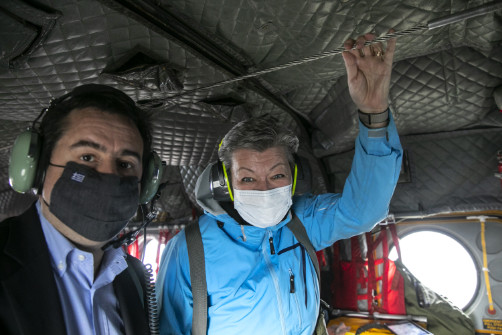
In June, agreement was reached on the new mandate of the European Asylum Support Office, which entered into force at the beginning of 2022, when it became the European Union Agency for Asylum. The aim of the new mandate is to give the agency a solid legal, operational and practical framework so it has the means to assist Member States and to help them reinforce their asylum and reception systems. In 2021, the office expanded its assistance to include Spain, Latvia and Lithuania (joining Greece, Italy, Cyprus and Malta).
Irregular migration in figures
There were some 182 600 irregular migrants across all routes between January and November 2021, compared to 114 400 in the same period in 2020 (and 125 100 during the whole of that year) and just under 127 000 in the same period in 2019 (141 700 during the whole year).
Reinforcing Greece’s reception system for asylum seekers
Support from the European Commission has helped Greece build up state-run accommodation for vulnerable asylum seekers, based on the UN’s Emergency Support to Integration and Accommodation Scheme. In 2019, Greece agreed to take over the management of that scheme’s network of apartments. This was a huge task, requiring on-the-ground technical advice on a daily basis. The Commission provided technical support, funded by the EU’s Structural Reform Support Programme / Technical Support Instrument. Staff from the Ministry of Migration and Asylum benefited from advice to build capacity, and can now rely on swift internal procedures and an efficient framework of laws and rules to run the reception system and monitor conditions.
Based on European Border and Coast Guard Agency data, as of November 2021, following the relaxation of COVID-19 measures, illegal border crossings at all of the EU’s external borders showed an upward trend (+ 60 % compared to the same period in 2020), with significant peaks on the central Mediterranean and western Balkan routes.
2021 also saw an increase in irregular crossings of the English Channel. Coastal EU Member States and the United Kingdom already have in place practical, operational cooperation to combat smuggling networks in particular, as provided for by the EU–UK Trade and Cooperation Agreement (see the Joint Political Declaration on Asylum and Returns). In addition, Member States are supported by EU agencies, including the European Border and Coast Guard Agency, the European Union Agency for Criminal Justice Cooperation and the European Union Agency for Law Enforcement Cooperation. Specifically as regards the European Border and Coast Guard Agency, it launched the Opal Coast Joint Operation to support France with aerial surveillance, with the aim of fighting people smugglers and preventing the loss of life at sea.

Across the three main routes (western Mediterranean, central Mediterranean and eastern Mediterranean) illegal border crossings have seen a repetitive trend since 2014, with annual peaks around late summer that generally do not exceed 50,000 monthly crossings. Between late 2015 and early 2016 a significant peak was recorded on the eastern route, with a maximum level of around 230,000 illegal crossings in October 2015. Note that the western Mediterranean route includes the Atlantic (western African) route.
The central Mediterranean remains the deadliest known migration route in the world, with more than 20 000 deaths and disappearances recorded since 2014. In 2021, 2 819 migrants were reported dead or missing while crossing via the Mediterranean and the western African route, compared to 2 325 in 2020.
European Border and Coast Guard
The implementation of the 2019 European Border and Coast Guard Regulation and the new mandate of the European Border and Coast Guard Agency (also known as Frontex) advanced successfully, with the first deployment of the European Border and Coast Guard standing corps starting on 1 January 2021, including the first uniformed EU staff.
The deployment of the standing corps is expected to increase the agency’s ability to support Member States in all operational areas, including return-related activities.
On average, the European Border and Coast Guard Agency deploys 2 000 border and coast guard officers on the external borders of the European Union, in close cooperation with the Member States. The agency has also strengthened its fundamental-rights framework significantly, as provided for by the European Border and Coast Guard Regulation, by appointing a new fundamental-rights officer and recruiting the first fundamental-rights monitors.
Implementing the Action Plan on Integration and Inclusion
In 2021, the EU continued to implement the 2021–2027 Action Plan on Integration and Inclusion, which focuses on education and training, employment and skills, health services and housing. New measures in 2021 included the partnership between the Commission and the European Committee of the Regions to increase cooperation with and support for EU cities, regions and rural areas in their work to help migrants integrate, which was launched in March.
Skills and talent package
As part of the 2020 New Pact on Migration and Asylum, the Talent Partnerships initiative was launched in June 2021 to strengthen relations with key partner countries on migration by matching EU labour-market needs with the skills of workers from those countries. As a way of providing safe and legal pathways to migration, the partnerships will be open to students, graduates and workers of all skill levels. They will also provide opportunities for vocational education and training and support for returning migrants to integrate.
Schengen area
In June, the Commission adopted a Strategy towards a Fully Functioning and Resilient Schengen Area, accompanied by a proposal to revise the Schengen Evaluation and Monitoring Mechanism. It proposed action in three areas: effective management of the EU’s external borders; measures compensating for the absence of controls at internal borders; and robust governance (evaluation, monitoring and preparedness).
The strategy includes initiatives for a stronger and more complete Schengen area, which builds on lessons learnt over the last 5 years, including during the COVID-19 pandemic. It takes stock of the progress made in implementing one of the world’s most technologically advanced border-management systems at the EU’s external borders and anticipates further initiatives in this area. It also emphasises measures for reinforcing Schengen internally, for instance by stepping up police and judicial cooperation. Finally, it proposes extending the Schengen area without controls at internal borders by including Bulgaria, Croatia and Romania, which are implementing most of the Schengen rules without the full benefits that come from being part of the Schengen area (along with Cyprus once it has successfully completed the currently ongoing Schengen evaluation process).
The proposal to reform the Schengen Evaluation and Monitoring Mechanism aims to make this mechanism more effective, more efficient and faster, and to increase its political focus and make it fit for purpose. It is currently under negotiation in the Council, where the Commission is doing its best to facilitate the smooth progress of the process.
On 14 December, the Commission adopted a proposal to amend the Schengen Borders Code. This seeks to ensure that controls at internal borders are only introduced as a last resort, while taking into account Member States’ right to do so in exceptional circumstances. The proposal also addresses the challenges resulting from the instrumentalisation of irregular migration. Another proposal on addressing situations of instrumentalisation in the area of migration and asylum was adopted at the same time.
Progress continued towards putting in place a common IT architecture for the EU, with new interconnected systems for border management, migration and law enforcement. Once implemented, interoperability will ensure that all the IT systems talk to each other and that national authorities have complete and accurate information, while fully respecting data-protection rules.
Security issues
New and increasingly complex cross-border and cross-sectoral security threats continue to emerge, and the EU must intensify cooperation and coordination in the wider security domain. The COVID-19 pandemic has tested the resilience of Europe’s critical infrastructure and its crisis-preparedness and crisis-management systems. In 2021, the EU continued to implement the 2020 Security Union strategy to protect everyone in the EU and promote our European way of life, with new initiatives on terrorism and radicalisation, organised crime, cybersecurity and hybrid threats.
Preventing and tackling terrorism and radicalisation
The Regulation to address the dissemination of terrorist content online entered into force on 7 June 2021 and will be fully enforceable 1 year later. The regulation will enable Member States to send removal orders to host service providers offering services in the EU. They will also be able to remove within 1 hour material that incites or advocates terrorist offences, promotes the activities of terrorist groups or provides instructions or techniques for committing terrorist offences.
In addition, the regulation provides safeguards that will increase the accountability and transparency of measures to remove terrorist content and guards against the erroneous removal of legitimate speech. It puts in place measures to ensure that fundamental rights and freedoms are protected, including exempting material disseminated for educational, journalistic, artistic or research purposes.
In 2021, the EU Internet Forum – a platform chaired by the Commission that brings together Member States and technology companies to discuss terrorists’ use of the internet and to tackle child sexual abuse online – presented a knowledge package on banned violent right-wing extremist groups, symbols and manifestoes to help online platforms moderate content.
In July, the European Commission presented an ambitious package of legislative proposals to strengthen the EU’s rules on anti-money laundering and countering the financing of terrorism. The package includes a proposal to establish a new EU authority to fight money laundering. The aim is to improve the detection of suspicious transactions and activities, and to close loopholes used by criminals to launder illicit proceeds or finance terrorist activities through the financial system.
The measures greatly enhance the existing EU framework by taking into account new and emerging challenges linked to technological innovation. These include virtual currencies, more integrated financial flows in the Single Market and the global nature of terrorist organisations. The proposals will also help to create a much more consistent framework across the whole of the EU, with directly applicable rules such as an EU-wide limit of €10 000 on large cash payments. This will ease compliance for operators subject to rules on anti-money laundering and countering the financing of terrorism, especially for those active across borders.
In the light of the developments in Afghanistan, a Counter-Terrorism Action Plan on Afghanistan was developed by the Counter Terrorism Coordinator along with the presidency of the Council, the Commission, the European External Action Service and relevant EU agencies.
The fight against organised and cross-border crime
In April, the Commission published the EU Strategy to Tackle Organised Crime, which sets out measures to boost law-enforcement and judicial cooperation; ensure effective investigation to disrupt organised crime structures; eliminate the profits generated by organised crime; and make law enforcement and the judiciary fit for the digital age. The Commission also proposed measures to enable Member States to use the European Multidisciplinary Platform against Criminal Threats to its full potential.
Throughout 2021, the Commission stepped up action to ensure better control of firearms in the EU and neighbouring countries. The Commission adopted measures that will give Member States improved access to information necessary for approving requests for the acquisition or possession of certain firearms (currently, Member States are not systematically informed of refusals to grant a firearms licence elsewhere in the EU). The application report published in October highlighted the positive effects of existing EU laws, in particular by prohibiting the most dangerous firearms and preventing the illicit conversion of weapons into lethal firearms. It also identified remaining shortcomings, requiring the initiation of 76 infringement proceedings, along with areas for further improvement, such as the digitalisation of the European Firearms Pass and stricter control of the acquisition and possession of blueprints for the 3D printing of weapons.
Following its 2020 communication on the digitalisation of justice, in December the Commission presented a package of initiatives to modernise justice systems in the EU and speed up cross-border judicial cooperation in civil, commercial and criminal matters.

Criminal networks have wide-ranging activities involving drugs, organised property crime, migrant smuggling, trafficking in human beings and cybercrime. They infiltrate the legal economy, with almost 70% of them involved in money laundering, almost 60% engaged in corruption and over 80% using legal business structures. They operate across borders, with 65% of criminal groups being composed of multiple nationalities. They adapted quickly to the pandemic, as scam offers of 1.1 billion vaccine doses were detected, for a total price of 15.4 billion euro.
The package includes three proposals:
- a regulation to improve cross-border digital communication between judicial authorities and to ensure access to justice in civil, commercial and criminal matters;
- an amendment to the Eurojust Regulation to create a legal basis for conducting oral hearings through videoconferencing and to strengthen coordination and cooperation on terrorism offences between national investigating and prosecuting authorities;
- a regulation to set up a collaboration platform to increase the efficiency and effectiveness of investigations and prosecutions conducted by joint investigation teams in cross-border cases.
These initiatives aim to deliver on the Commission’s ambition to create a truly efficient and resilient European area of freedom, security and justice.

In 2021, the Commission continued negotiations with several countries, including Israel, New Zealand and Turkey, on the exchange of personal data between the European Union Agency for Law Enforcement Cooperation and their competent authorities.
The European Public Prosecutors Office started its operations on 1 June 2021. By the end of the year, it had initiated more than 500 investigations into fraud affecting the EU’s financial interests, with an estimated total damage to the EU budget of €5 billion.
In 2021, a European Union Agency for Law Enforcement Cooperation taskforce made up of representatives from Belgium, Germany, Spain, Croatia and the Netherlands brought down a gun-trafficking gang that had flooded Europe with illegally converted firearms. Eighteen people were arrested and 350 weapons were seized. The action was carried out within the framework of the European Multidisciplinary Platform Against Criminal Threats.
Following the 2020 proposals to revise the mandate of the European Union Agency for Law Enforcement Cooperation, in December the Commission proposed an EU Police Cooperation Code to enhance law-enforcement cooperation across Member States and give police officers in the EU more modern tools for information exchange. The code – which includes a recommendation on operational police cooperation and new rules on information sharing – will help improve cross-border operations, provide clear channels and time frames for exchanging information and give the agency a stronger role.
In addition, revised rules on the automated exchange of certain categories of data will help establish links between crimes across the EU much more effectively. This will help close information gaps, boost the prevention, detection and investigation of criminal offences in the EU and foster security for everyone in Europe. The police cooperation package includes three legislative proposals: a Council recommendation on operational police cooperation; a directive on information exchange between law-enforcement authorities in Member States; and a regulation on an automated data exchange mechanism for police cooperation ('Prüm II’).
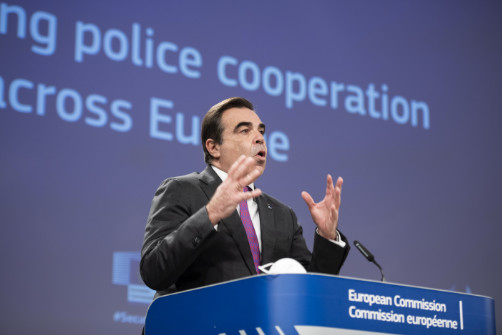
Together with the anti-money-laundering package, the Commission presented a proposal to give law-enforcement authorities access to the future interconnected bank account registries. This will allow law enforcement to swiftly identify whether a suspect holds bank accounts in other Member States, thereby helping financial investigations and asset recovery in cross-border cases.
Crisis management
Civil protection
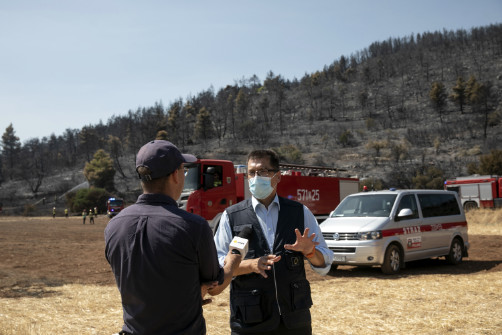
The COVID-19 pandemic has demonstrated the need for a stronger EU Civil Protection Mechanism that enables a faster and more effective response to big emergencies. In May 2021, new legislation entered into force giving the EU better tools to deal with disasters affecting several countries at the same time. The EU also increased the funds dedicated to civil-protection support for EU Member States’ own response efforts.
Together with its Member States, the EU has continued to develop the rescEU medical reserve of protective and medical equipment. It has also continued to strengthen the rescEU firefighting fleet of airplanes and helicopters to complement national capacities. Additional rescEU capacities will be available in the future to respond to chemical, biological, radiological and nuclear incidents. At the same time, the EU will offer significant financial support to strengthen prevention and preparedness measures that reduce the risk of disasters and help communities become more resilient to various crises.
In 2021, the EU Civil Protection Mechanism received a record number of requests for assistance. Of the 114 requests, 61 % were related to the COVID-19 pandemic.
With climate change already affecting every part of the world, the summer of 2021 offered a glimpse of what future summers in Europe might be like. The 2021 forest-fire season saw one of the largest EU Civil Protection Mechanism deployments in Europe in the last 10 years, along with one of the largest-ever numbers of simultaneous activations of the mechanism to fight wildfires.
In response to forest fires raging across the Mediterranean and the Western Balkans, the EU deployed a fleet of 16 planes and four helicopters, over 290 vehicles and more than 1 300 first responders to Albania, Algeria, Cyprus, Greece, Italy, North Macedonia and Turkey through the EU Civil Protection Mechanism. Emergency operations were bolstered from space by the EU’s Copernicus Emergency Management Service, which produced updated maps of the affected areas.
In 2021 alone, the Rapid Mapping service of the Copernicus satellite produced more than 580 maps of areas around the world.
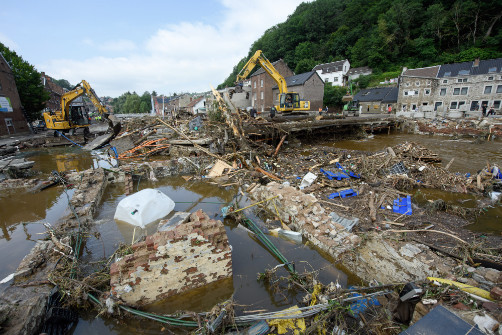
When devastating floods hit several areas of Europe in July, the EU coordinated the deployment of rescue boats, helicopters and more than 150 rescuers from France, Italy and Austria to Belgium. Copernicus’s European Flood Awareness System alerted the authorities to the flood risks ahead of the emergency, and the Rapid Mapping service was activated by Belgium, Germany, the Netherlands and Switzerland to support first responders.
Throughout 2021, the EU also provided life-saving support to those affected by disasters across the globe, including to people in the Democratic Republic of the Congo after a volcanic eruption, in Guinea following an outbreak of Ebola and in Haiti after the earthquake. In response to developments in Afghanistan, the EU, through its Civil Protection Mechanism, coordinated the repatriation of EU nationals and other vulnerable people.
Combating child sexual abuse and child sexual exploitation
In July, the EU adopted a Regulation on a temporary derogation from the provisions on the confidentiality of communication and traffic data in the rules governing the privacy of electronic communications. This forms part of the eight measures in the EU Strategy for a More Effective Fight against Child Sexual Abuse to set out a comprehensive response to these crimes. The strategy focuses on supporting prevention initiatives as a means to prevent children from becoming victims in the first place, assisting victims and supporting law enforcement to ensure that victims are rescued swiftly from ongoing abuse and that the offenders are arrested.
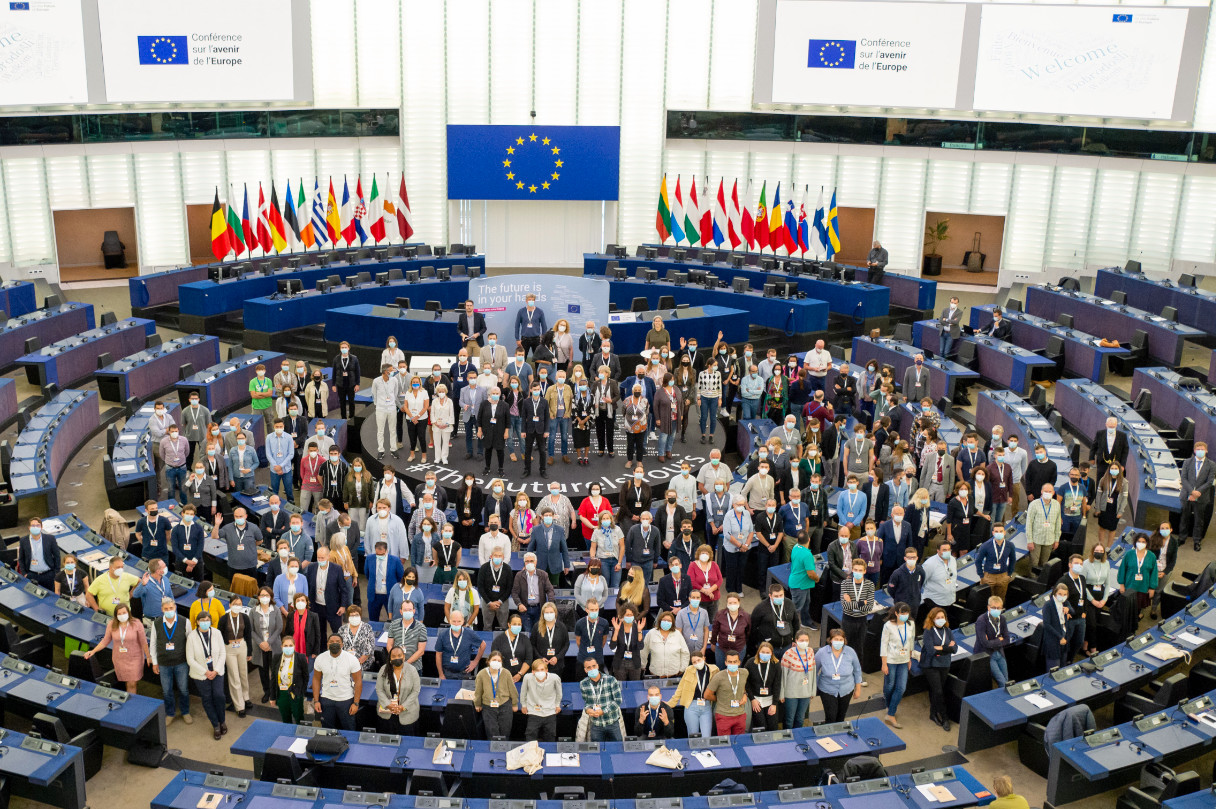
Conference on the Future of Europe
In 2021, the Conference on the Future of Europe put people at the heart of the discussion, to share their ideas and help shape our common future.
In March, the European Parliament, the Portuguese Presidency of the Council of the European Union and the European Commission agreed a joint declaration on the Conference on the Future of Europe. An Executive Board made up of representatives of the three institutions and observers, including from national parliaments, oversees the conference, assisted by the Common Secretariat. The Parliament hosted the inaugural event in Strasbourg on 9 May (Europe Day).
Thanks to its online platform and live events, attended both remotely and in person, citizens, policymakers, local, regional and national authorities, civil-society representatives and social partners from across the EU meet and exchange ideas on a wide range of topics. Discussions are organised around nine themes, including climate change and the environment, health, migration and education, among others, although submissions are also possible on any other subject that matters to citizens. People interact through the platform, which is available in the 24 official languages of the EU. Here they share information on conference events, make proposals, and endorse and comment on others’ ideas.
In June, along with the inaugural plenary (the body responsible for debating recommendations without a predetermined outcome and without limiting the scope to predefined policy areas) a European Citizens’ Event took place in Lisbon, Portugal, and online, kicking off citizens’ involvement. It brought together the 27 representatives from national citizens’ panels or national events (one per Member State), the President of the European Youth Forum, more than 50 citizens selected to participate in the conference’s European Citizens’ Panels and a group of Erasmus students. They discussed their expectations for the conference with the three co-chairs of the Executive Board: Member of the European Parliament Guy Verhofstadt, Portuguese Secretary of State for European Affairs Ana Paula Zacarias and Commission Vice-President Dubravka Šuica.
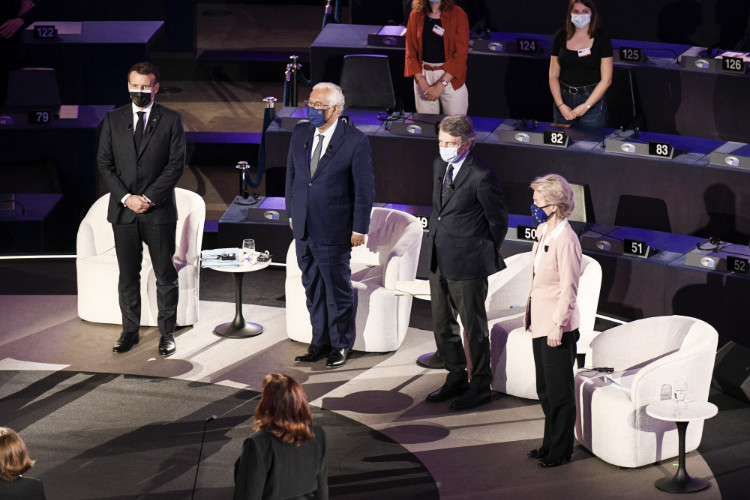
The Conference on the Future of Europe has four European Citizens’ Panels covering the topics of the online platform, each of which involves around 200 EU citizens from all Member States, of different ages and from different backgrounds. Young people play a central role in shaping the future of the European project, and they are closely involved in the conference: one third of each European Citizens’ Panel is composed of people between 16 and 25 years of age. The panels have an important role to play: they discuss ideas garnered from events across the EU and proposals submitted through the conference platform, and make recommendations to be discussed in the conference plenary.
The European Citizens’ Panels kicked off their deliberations in Strasbourg on 17–19 September, with the first meeting of the panel focusing on a stronger economy, social justice, jobs, the digital transformation, education, youth, culture and sport. Discussions were based on citizens’ contributions from across the EU on the online platform. The panel on European democracy/ values, rights, the rule of law and security finished its work and formulated draft recommendations for the conference plenary in a hybrid setting (in person and remotely) in Florence, Italy, on 10–12 December. Another seven panel sessions on all conference themes were held in 2021, in Strasbourg and online.
A conference plenary on the work of the European Citizens’ Panels, contributions to the multilingual digital platform, national citizens’ panels and other events took place on 23 October.
In 2021, a total of 4 639 events were organised in all Member States, with over 340 000 people participating. More than 41 000 people registered on the multilingual digital platform. They shared over 12 500 ideas, made over 18 000 comments and endorsed other people’s views more than 52 000 times. More than 4.1 million people visited the platform in 2021. Three European Citizens’ Panels are planned to finish their work during January and February 2022. Conference plenaries were scheduled to take place in January, March and April. The Executive Board of the conference is due to draw up the final report in spring 2022.
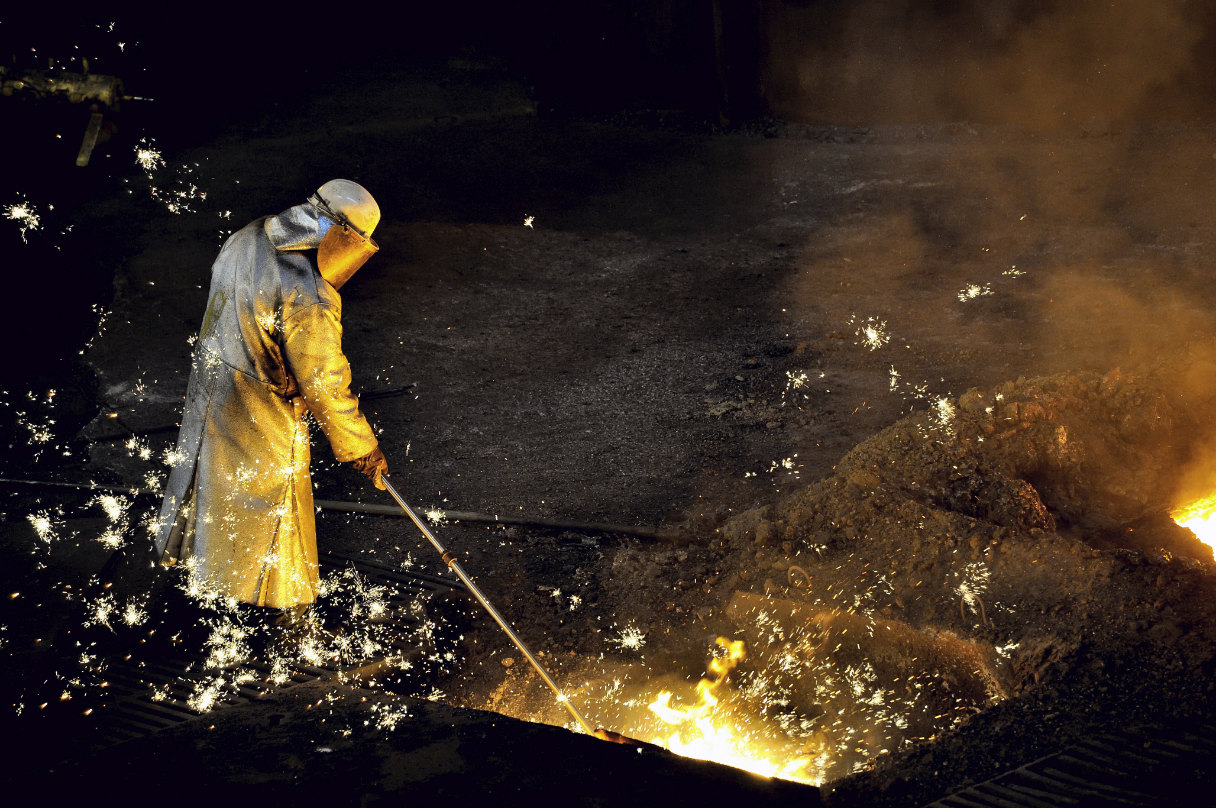
Strengthening the economy
Europe’s economic recovery
Amid a great deal of uncertainty, 2021 saw the EU economy bounce back strongly following the severe recession caused by the pandemic in 2020. The EU’s achievements in rolling out the COVID-19 vaccination campaign and mitigating the socioeconomic impact of the pandemic have laid the groundwork for a sustained recovery. As vaccination campaigns progressed and restrictions started to be lifted, growth resumed in the spring and continued through the summer, underpinned by the reopening of the economy. By the autumn, the EU economy had regained its pre-pandemic output level.
Overall, the 'European economic forecast – Autumn 2021' projected that gross domestic product would grow by 5.0 % in 2021 and 4.3 % in 2022, in both the EU and the euro area. While the speed of the recovery may vary across the EU, all Member States were forecast to at least reach their pre-crisis economic level by the beginning of 2023. As the economy expands in 2022, the labour market is forecast to complete its recovery. An estimated 3.4 million jobs were projected to be created in 2022 and 2023, bringing the unemployment rate in the EU down to 6.5 % in 2023.
The unprecedented economic stimulus measures put in place in the early days of the crisis at the EU and national levels – including Support to mitigate Unemployment Risks in an Emergency (SURE), the first EU initiative to finance short-time work (see Chapter 1) – have contributed to the turnaround. Meanwhile, work on the long-term recovery accelerated with the launch in the summer of the EU’s €800 billion recovery plan, NextGenerationEU (see Chapter 1). The implementation of the Recovery and Resilience Facility will play an important role in boosting private and public investment over the coming months and years. Supporting reforms and investments by Member States, the aim is to cushion the economic and social impact of the coronavirus pandemic and make economies and societies in the EU more sustainable, more resilient and better prepared for the challenges and opportunities of the green and digital transitions. In addition, the InvestEU Programme will provide the EU with crucial long-term funding, bringing in private investment in support of the recovery.
The European Semester, the framework for monitoring and coordinating economic and employment policies across the EU, was temporarily adapted in 2021 to coordinate it with the Recovery and Resilience Facility. The publication of the Annual Sustainable Growth Strategy launched the 2021 cycle of the semester, and continued 2020’s growth strategy based on the European Green Deal and the concept of competitive sustainability. All national recovery and resilience plans contain investment and reforms to address country-specific recommendations identified in the European Semester, for instance on labour markets, education, culture, healthcare, justice and the long-term sustainability of public finances.
Although the impact of the pandemic on economic activity has weakened considerably, COVID-19 has not yet been defeated. The recovery is heavily dependent on the pandemic’s evolution, both within and outside the EU. It will also depend on the pace at which supply adjusts to the rapid turnaround in demand following the reopening of the economy. Surging energy prices, most notably from gas and electricity, are another issue the EU economy faces in the short term.
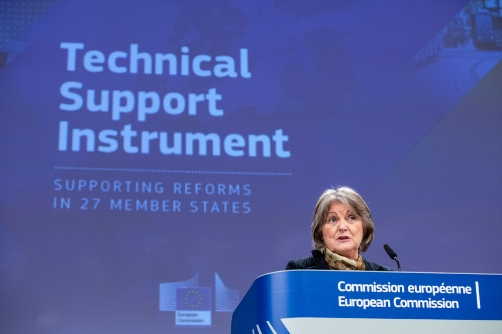
Industrial Strategy for Europe
In May, the Commission updated the European Industrial Strategy to ensure that the EU’s industrial ambitions take into account lessons learned from the COVID-19 crisis while reaffirming its political priorities. The update focuses on preparing the Single Market to cope with future crises; addressing the EU’s strategic dependencies and vulnerabilities in sensitive supply chains and industrial ecosystems; and accelerating EU industry’s green and digital transitions.
The updated strategy focuses on action in three key areas. First, to strengthen the resilience of the Single Market, the strategy presented an analysis of the EU’s 14 industrial ecosystems and suggested the creation of a Single Market Emergency Instrument to address the possible impact of future crises on the free movement of persons, goods and services.

Second, the strategy presented an in-depth analysis of the EU’s strategic dependencies. This included the identification of 137 products in sensitive ecosystems where the EU is highly dependent on foreign supplies, along with six in-depth reviews on raw materials, batteries, active pharmaceutical ingredients, hydrogen, semiconductors, and cloud and edge technologies. To address the EU’s strategic dependencies, the update proposes building diversified international partnerships, along with measures to build EU capacity. This includes setting up new industrial alliances in key areas to help attract private investment in full compliance with EU competition rules. In July, two new industrial alliances were launched in the fields of data and cloud technology, and processors and semiconductors.
Third, the strategy announced action to support the EU’s green and digital transitions. The strategy contains new measures to co-create transition pathways in partnership with industry, public authorities, social partners and stakeholders. This began with tourism and energy-intensive industry ecosystems, followed by construction and the social economy. The strategy also supports a coherent regulatory framework to achieve the goals of the package to deliver the Green Deal and Europe’s Digital Decade, including by rolling out renewable energy sources and ensuring access to abundant, affordable and decarbonised electricity. It also focuses on small and medium-sized enterprises by establishing sustainability advisors under the renewed and strengthened Enterprise Europe Network (see below) and data-driven business models. Finally, it calls for investment to upskill and reskill the labour force in order to support the green and digital transitions.
Boosting the Single Market
In April, the Commission adopted the Single Market Programme, a €4.2 billion package to support and strengthen the governance of the Single Market until 2027, with a focus on economic recovery.
The programme consolidates measures in areas such as food safety, consumer protection, statistics, standardisation and competitiveness. It will ensure greater efficiency in the Single Market, while providing better value for money for consumers and companies. As part of this, the Commission launched calls for a renewed and strengthened Enterprise Europe Network (which began work on 1 January 2022) and Euroclusters projects, with a focus on helping small and medium-sized enterprises make the transition to sustainability, digitalisation and resilience, and strengthening their ability to grow both within the Single Market and internationally.
The focus areas of the new Single Market Programme.
An effective Single Market
- Implement, enforce and further develop rules on business law, competition, anti-money laundering and the free movement of capital, goods and services.
- Ensure financial services meet the needs of consumers, civil society and end users.
- Improve the enforcement of competition rules in the digital economy and stronger cooperation with Member States.
- Help public buyers get better value for citizens’ money.
European statistics
- Provide funding for the production and dissemination of high-quality statistics to support evidence-based decision-making and measure impact.
Effective standards
- Provide financial support to develop EU-wide standards of quality and safety for products and services.
Food safety
- Prevent, control and eradicate animal diseases and plant pests while supporting sustainable food production and animal welfare.
Protect consumers
- Make sure that products on the market are safe and that consumers know the rules.
- Help national authorities to work together efficiently.
Competitiveness
Support for businesses:
- provide financial support, such as grants and SME loan guarantees under the InvestEU Fund;
- facilitate access to markets and reduce administrative burdens;
- support the uptake of innovation and address lobal and societal challenges;
- foster a favourable business environment and an entrepreneurial culture.
Space policy
The EU Space Programme, adopted in April 2021 with a budget of €14.9 billion, the largest ever for an EU space initiative, modernises and unifies in a single programme three EU flagship programmes: Galileo, EGNOS (the European Geostationary Navigation Overlay Service) and Copernicus. It provides the foundation to support the space industry and fosters Europe’s space technological leadership and resilience.

Europe’s space industry is worth between 46 and 54 billion euro and supports more than 250,000 jobs. It will benefit from 14.9 billion euro in EU investment over the next 7 years. More than 30 EU-owned satellites are in orbit. They are used to increase efficiency in agriculture and fisheries, protect the environment and help tackle climate change, monitor and respond to natural disasters, increase border security and combat piracy at sea, improve citizens’ health and optimise transport. One third of the world’s satellites are produced in the EU.
With the increasing importance of space in advancing EU goals such as development, competitiveness, sustainability and security, the European GNSS Agency, established in 2010, was replaced in June 2021 by the European Union Agency for the Space Programme, which has a broader mission. The Commission also signed a financial partnership agreement with this new agency and the European Space Agency.
Some areas of application
Agriculture
EU Space enables precision agriculture and integrated farming solutions. It helps farmers increase yields by more than 10 % and save more than 20 % on fertiliser, fuel and pesticides, and enables the functioning of autonomous machines.
Response to natural disasters
EU Space supports rescue operations during floods, fires, earthquakes and hurricanes, along with human-made disasters.
Smart cities
EU Space is crucial for urban mapping, planning and infrastructure monitoring, notably enabling better urban transport and smart waste management.
Renewable energy
EU Space supports the siting of renewable-energy facilities, assessing potential energy generation and environmental impacts.
Health
EU Space helps to forecast air quality and ultraviolet radiation, which have an impact on our health.
The EU Space Programme provides critical infrastructure for the digital transformation. Space data is a key enabler of digital innovations such as autonomous vehicles, smart solutions and 5G wireless telecommunication networks.
To further develop its own space industry, Europe needs to remedy the current dearth of risk capital and lack of competition in certain space markets. This, in the coming years, will improve the supply of technology to the programme and enhance the EU’s autonomy in space. It could also create many highly skilled jobs in other sectors, such as products and services enabled by space data. The new €1 billion Cassini fund will help innovative businesses to expand into new, space-related markets by attracting more private investment. It will also strengthen the growth of the broader EU space industry by helping start-ups to make better use of the space data generated by EU infrastructure.
The EU Space programme for a competitive space ecosystem
Galileo
EU Space will accelerate the deployment of the Galileo second generation to improve its performance and robustness.
Copernicus
EU Space will accelerate the modernisation of Copernicus infrastructure and services to support the EU’s world-class role in Earth observation.
Cassini
The EU will put in place a €1 billion Space Investment Fund to accelerate the expansion of innovative SMEs and start-ups working in the field of space and on the development of breakthrough technologies and processes.
Defence industry
In February 2021, with its Action Plan on Synergies between Civil, Defence and Space Industries, the EU took action to enhance its technological and industrial edge. It set up ambitious initiatives to strengthen innovation by exploring and exploiting the disruptive potential of technologies at the interface of defence, space and civil applications, such as microprocessors, cyber technologies, quantum technologies and artificial intelligence.
The main goals of the plan are to improve complementarity between relevant EU programmes and instruments; ensure that EU funding for defence research and innovation has economic and technological dividends for society as a whole; and facilitate the uptake by defence industries of civil industry research achievements and of civil-driven innovation. Eleven initiatives are set to respond to geopolitical competition and strengthen the EU’s technological sovereignty. The action plan sets up an Observatory for Critical Technologies. It also paves the way for the launch of three flagship projects (to be presented by the Commission in 2022) with the potential to become game changers:
- drone technologies for the competitiveness of EU industry in this critical area;
- space-based secure connectivity to provide high-speed and resilient connectivity for everyone in the EU based on quantum encryption; and
- space-traffic management to avoid collision events that may result from the proliferation of satellites and space debris.
The European Defence Fund, adopted in April 2021, will support collaborative defence research and development and foster an innovative and competitive defence technological and industrial base. The adoption of the first annual work programme in June paved the way for calls for proposals for €1.2 billion of EU funding.
The lack of cooperation between Member States in the field of security and defence is estimated to cost between €25 billion and €100 billion every year.
Currently, defence-capability planning and around 80 % of defence procurement are run on a purely national basis, leading to the costly duplication of defence capabilities.
Only 9 % of research and technology in the field of defence is conducted on the basis of cooperation between Member States.
The fund increases the EU’s technological edge and develops the capabilities that are necessary for its open strategic autonomy and resilience, acting as a key enabler for a more secure and competitive European Union. The work programme aims at pooling resources and defragmenting the EU defence market, thus ensuring better value for money while developing state-of-the-art technologies and equipment that would be out of reach working independently.
The new fund was preceded by two precursor programmes: the Preparatory Action on Defence Research and the European Defence Industrial Development Programme. In June, the latter awarded €158 million in funding to 26 new defence-capabilities projects in areas as diverse and complementary as maritime security, cyber situational awareness, and ground and air combat.
Financial systems, Banking Union and Capital Markets Union
Open and resilient economic and financial systems
The EU is committed to a more resilient and open global economy, properly functioning international financial markets and the rules-based multilateral system.
In January 2021, the Commission presented a new strategy to support the openness, strength and resilience of the EU’s economic and financial system for the years to come. It is based on three mutually reinforcing pillars: strengthening the international role of the euro; enhancing the resilience of the EU’s financial-market infrastructure; and improving the effectiveness of the EU sanctions regime. The strategy aims to better enable the EU to play a leading role in global economic governance, while protecting it from unfair and abusive practices such as non-EU-country measures with extraterritorial impact or undue political influence over EU operators.
On top of completing the Banking Union and further advancing the Capital Markets Union, the Commission plans to strengthen the international role of the euro by reaching out to non-EU partners to promote its use, and by supporting the development of euro-denominated instruments and benchmarks. The issuance of high-quality euro-denominated bonds under NextGenerationEU – proposed in July – will add significant depth and liquidity to the EU’s capital markets over the coming years, and will make them, and the euro, more attractive to investors. A greater international role for the euro will not only benefit the EU, it will also help enhance the stability of the overall financial system by offering more opportunities to diversify foreign currency reserves, thereby reducing the amount of vulnerability to external monetary shocks.
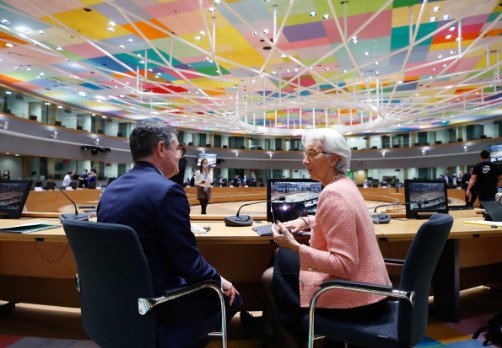
In January, the Commission and the European Central Bank agreed to work together to analyse various design options and related regulatory implications of the digital euro, a digital form of central bank money that would offer greater choice to consumers and businesses. The digital euro would be a complement to cash, which should remain widely available and useable. It could support the EU’s digital finance and retail payments strategies, given its potential as an additional, innovative and safe means of payment. The digital euro could also increase the international role of the euro and support the EU’s open strategic autonomy. In July, the Commission welcomed the Bank’s decision to launch the investigation phase of the digital euro. This phase, which will last 2 years, will examine the possible design options and user requirements, and how financial services can be provided using the digital euro. The Commission is cooperating with the Bank on the various options and how they interact with the EU’s policy objectives.
Deepening the Capital Markets Union
The Capital Markets Union package, adopted in November, is an important tool for promoting sustained growth and making sure that companies in the EU have sufficient access to financing. The proposals aim to ensure that investors have better access to company and trading data. The measures will also encourage long-term investment and make it easier and safer for investment funds to be sold across borders. Overall, the proposals aim to connect EU companies more effectively with investors, improve companies’ access to funding, broaden investment opportunities for retail investors and further integrate EU capital markets.
The package is composed of four pillars: the European Single Access Point proposal; the European Long-Term Investment Fund review; the Alternative Investment Fund Management Directive review; and a review of the Markets in Financial Instruments Regulation, introducing the EU consolidated tape.
The European Single Access Point proposal would increase the visibility and accessibility of information about EU companies and EU investment products. It would tackle the fragmentation of data along national lines by ensuring access to this information at EU level, and would thus enhance institutional and retail investors’ investment opportunities. It would make funding more readily available for EU companies, especially smaller ones in smaller markets. The Single Access Point would also hold sustainability-related information published by companies. This will support the move to sustainable investment – one of the objectives of the European Green Deal. As a common data space, it will be a cornerstone of the EU’s Digital Finance Strategy.
The European Long-Term Investment Fund review will make it easier to channel investment by professional and retail investors into digital or sustainable projects or towards the long-term equity of small and medium-sized enterprises, while ensuring a high level of protection for retail investors.
The review of the Alternative Investment Fund Management Directive aims to enhance the efficiency and integration of the alternative investment funds market. The proposal harmonises the rules relating to funds that give loans to companies. This will facilitate lending to the real economy, while providing better protection to investors and ensuring financial stability. The review also clarifies the rules on delegation that allow fund managers to outsource expertise from non-EU countries, without disrupting a business practice that has contributed to the global success of EU funds. The review will ensure that there is adequate information and coordination among EU supervisors.
Adjustments to EU trading rules will ensure more transparency on capital markets, and will enhance the level playing field between stock exchanges and investment banks. The review will also introduce an EU consolidated tape, which will give investors access to near-real-time trading data for stocks, bonds and derivatives across all trading venues in the EU. So far, this access has been limited to a handful of professional investors. The tape will make public markets easier to navigate for investors, and allow for more transparent and more efficient equities, bonds and derivatives. Stock exchanges, particularly smaller ones, will receive a fair share of the revenue generated for the data they provide for the tape.
Insurance
Insurers are critical to many aspects of the EU economy: they provide businesses with long-term financing; help channel savings into financial markets and the real economy; and offer vital protection for businesses and households, including solutions for retirement income.
In September, the Commission adopted a comprehensive review of EU insurance rules (known as Solvency II). The overall aims are to ensure that insurers and reinsurers in the EU keep investing and to support the political priorities of the EU, in particular financing the post-COVID recovery, completing the Capital Markets Union and channelling funds to implement the European Green Deal. The review also fills in the gaps in the current rules and makes the insurance and reinsurance sector more resilient so that it can weather future crises and provide better protection to policyholders.
Banking package
In October, the Commission adopted a review of EU banking rules, finalising the implementation of the Basel III agreement in the EU. The review consisted of a legislative proposal to amend the Capital Requirements Directive, a legislative proposal to amend the Capital Requirements Regulation and a separate legislative proposal to amend the Capital Requirements Regulation in the area of resolution.
These new rules will ensure that banks in the European Union become more resilient to potential future economic shocks, while contributing to the EU’s recovery from the COVID-19 pandemic and to the transition to climate neutrality.
Basel III: new rules on internal models
A new limit will be introduced to ensure risks are not underestimated when banks use their own calculation models.
Better supervision
Supervisors will have stronger tools to oversee EU banks, including complex banking groups. Minimum standards will be introduced to supervise branches of non-EU-country banks in the EU.
Sustainability
Banks will be required to take environmental, social and governance risks into account when managing their business.
Fair, simple and modern taxation and customs
In May, the Commission presented a communication on business taxation in the 21st century. It announced a series of measures to improve tax fairness and transparency and to deliver a long-term vision for an EU business-tax system. The aim is to create a business-tax environment that supports the recovery, sustainable growth and investment. At the same time, the Commission engaged heavily in the international discussions on corporate tax reform, which should ultimately ensure that all companies are taxed fairly, wherever they do business. These talks culminated in the historic agreement on international tax reform by 136 jurisdictions that the G20 finance ministers endorsed in July.
A legislative proposal adopted by the Commission in December 2021 aims in particular at the swift transposition in the EU of the international agreement on the effective minimum taxation of multinationals, known as Pillar Two of the international agreement. The proposal sets out how the principles of the 15 % effective tax rate will be properly and consistently applied in practice within the EU.
The Commission also adopted a new initiative in December to fight against the misuse of shell entities for improper tax purposes. The proposal should ensure that entities in the European Union that have no or minimal economic activity are unable to benefit from tax advantages and do not place any financial burden on taxpayers.
In 2020, total e-commerce in the EU grew to €757 billion, up 10 % from €690 billion the year before. 2020 was an exceptional year, marked by the COVID-19 pandemic and the consequent important role of e-commerce for both society and the economy. In July 2021, new VAT-rules for online shopping entered into force. The rules seek to simplify procedures for cross-border e-commerce and ensure a level playing field between EU and non-EU companies and platforms. They also bring greater transparency for online shoppers in the EU when it comes to pricing and consumer choice.
2021 saw a major reinforcement of the Customs Union against security and safety threats, with the new Import Control System 2. This system allows customs services to tackle the illicit traffic in goods across the EU’s externals borders in a more effective way, and to manage the growing risk of unsafe goods entering the EU via e-commerce.
Fair competition
Vibrant competition makes the EU economy more resilient, as it gives market players the incentive to innovate, invest and increase their competitiveness. With its antitrust, merger and State-aid decisions, the Commission protects consumers from unfair business practices and ensures their access to the widest choice of quality and innovative products, at fair prices. As an example, conservative estimates from the European Commission put yearly customer savings from cartel prohibitions and merger interventions in the EU at between €14 billion and €23.3 billion.
Robust and even-handed enforcement of EU competition rules promotes cohesion in the European Union and equal treatment among market players, generating growth and employment. In 2021, the Commission continued to enforce competition rules across all markets. To stay ahead of change, it also intensified its ongoing review of competition policy tools. In particular, the new State-aid guidelines for climate, energy and the environment were a notable result of this process in 2021, contributing even further to the greening of the economy, in line with the Commission’s policy objectives.
The ongoing work, as framed by the communication on competition policy fit for new challenges, aims at continuing to support the economy in the context of the pandemic (see also Chapter 1); accelerating the recovery; and paving the way for the green and digital transitions and for a more resilient Single Market.

Building a fair and social Europe
An inclusive economy
European Pillar of Social Rights Action Plan
In March, the European Commission proposed an action plan setting out concrete initiatives to turn the 20 principles of the European Pillar of Social Rights into reality. Drawing on a large-scale public consultation with over 1 000 written contributions, it proposed three headline targets for the EU to reach by 2030. These are employment for at least 78 % of the population aged 20 to 64; yearly training for at least 60 % of all adults; and at least 15 million fewer people at risk of poverty or social exclusion, including 5 million children. EU leaders endorsed the new set of targets at the Porto Social Summit on 7 and 8 May. Here, EU leaders, social partners and civil-society representatives came together and committed to further implementing the European Pillar of Social Rights, stating that it is time to deliver.

By 2030, the EU aims to have at least 78% of the population aged 20 to 64 in employment, 60% of all adults participating in training every year and 15 million fewer people at risk of poverty or social exclusion.
Safer and healthier workplaces
To better protect millions of workers from work-related accidents and diseases, in June the EU adopted the Strategic Framework on Health and Safety at Work 2021–2027. It identifies key challenges, sets objectives and presents measures to improve workers’ health and safety in the coming years. It also responds to the changing needs in worker protection brought about by the digital and green transitions, new forms of work and the COVID-19 pandemic. At the same time, the framework will continue to counter traditional occupational health and safety risks, such as accidents at work or exposure to hazardous chemicals. It promotes a 'vision zero' approach to eliminating work-related deaths in the EU.
Protecting people who work through platforms
Digital labour platforms provide jobs and income for around 28 million people in the EU. In the last 5 years, the platform economy has grown five-fold. In December, the Commission proposed measures to improve working conditions for people working through platforms. As a result of the proposed directive, it is estimated that between 1.7 million and 4.1 million people could be reclassified as workers and obtain the rights and social protection they are entitled to. Others would continue to be classified as self-employed, and would be granted the full autonomy and protections provided at the national level that self-employment entails. The directive would also ensure that algorithms used in platform work are better understood by everyone who works through platforms and their representatives, and are always subject to controls by people.
What would these people gain from being classified as workers?
Guaranteed rest time and paid holidays.
At least the national or sectoral minimum wage (where applicable).
Safety and health protection.
Unemployment, sickness and healthcare benefits.
Maternity, paternity and parental leave.
Pension rights.
Benefits relating to accidents at work and occupational diseases.
European Labour Authority
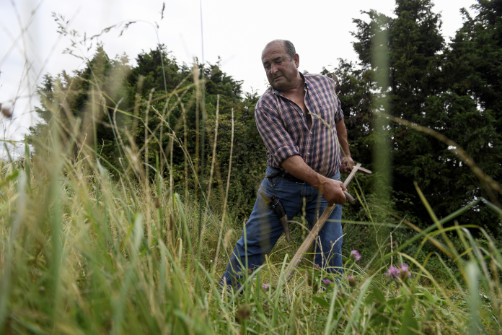
In May 2021, the European Labour Authority started operating independently from the Commission. The authority’s mandate is to help ensure that EU rules on labour mobility and social-security coordination are enforced in a fair, simple and effective way, and to make it easier for individuals and businesses to reap the benefits of the Single Market.
Fighting homelessness
The EU, the Member States and civil-society organisations have for the first time committed to working together to combat homelessness in the EU. In June, they jointly launched the European Platform on Combatting Homelessness to trigger dialogue, facilitate mutual learning, improve evidence and monitoring and strengthen cooperation between organisations fighting homelessness. The June Lisbon Declaration on the new platform sets ambitious objectives: accessible, safe and appropriate emergency accommodation for everyone in need; an offer of appropriate housing for people who are discharged from institutions such as prison or hospital; emergency or transitional housing used only as strictly necessary; and fighting discrimination based on homelessness. From 2022, the platform’s activities will include the launch of a project to count people experiencing homelessness in various cities across the EU, and mutual-learning events to identify and promote evidence-based good practices and the use of EU funding.
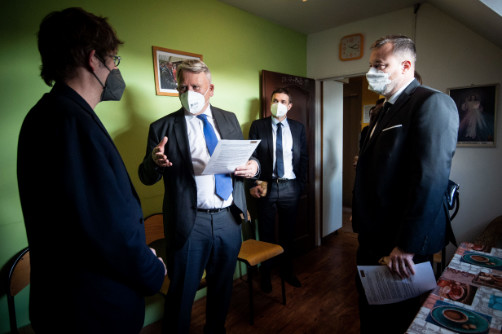
Creating more opportunities for young people
In December 2021, the youth unemployment rate was 14.9 % in the EU, representing 2.75 million people under the age of 25. In September, Ursula von der Leyen, President of the European Commission, announced a new initiative called ALMA (Aim, Learn, Master, Achieve) to increase EU support for young people who are not in any kind of employment, education or training and are disadvantaged, for example due to a lack of qualifications or a disability, or because they come from a migrant background. ALMA will help them find their way in the job market by combining personalised coaching and training in their home Member State with a work placement in another. The objectives are to improve young people’s skills, knowledge and experience; to give them the opportunity to create new connections across Europe that would not have been possible otherwise; and, ultimately, to help them enter the labour market. ALMA will be implemented under the European Social Fund Plus, with an estimated annual budget of €15 million.
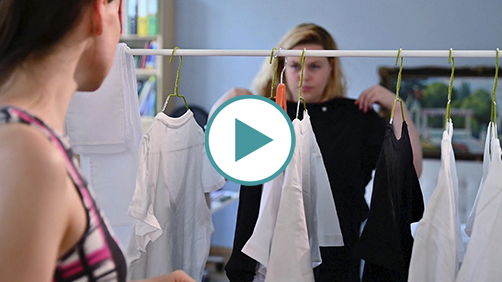
In April, the Commission launched the new European Solidarity Corps programme for 2021–2027. With a budget of over €1 billion, it will offer opportunities to around 275 000 young people to help address societal and humanitarian challenges through volunteering or by setting up their own solidarity projects. Thanks to the thematic focus of corps projects, the programme supports overarching EU political priorities such as the green and digital transitions, inclusion, and the participation of young people in democratic processes and their civic engagement.
In September, the Commission launched the new Erasmus+ online application, a one-stop shop for mobile Erasmus+ students with all the information necessary for studying and living abroad. It provides a Digital European Student Card to mobile students. The card will be valid across the EU for safe and easy identification in higher-education institutions and for access to services. The card marks an important step towards creating the European Education Area. The Erasmus for Young Entrepreneurs programme expanded to Canada, South Korea and Taiwan in 2021, providing more opportunities to gain experience with an entrepreneur abroad.
President von der Leyen also announced, in September, a Commission proposal to make 2022 the European Year of Youth. The objective is to encourage the EU, the Member States and regional and local authorities to honour, support and engage with young people in the post-pandemic environment. In particular, the European Year of Youth will encourage young people’s participation and engagement in all EU policies; promote their personal, social and professional development; and highlight how the green and digital transitions can offer new perspectives to them.
In October, the Commission started the process to distribute 60 000 free rail passes under DiscoverEU. This initiative gives 18-year-olds from all backgrounds the opportunity to travel around the EU, learn from other cultures, build new friendships and explore their European identity. Since passes were not distributed in 2020 because of the COVID-19 pandemic, 19-year-olds were also allowed to participate in 2021.
Social Economy Action Plan
In December, the Commission presented an action plan to help the European social economy prosper, tapping into its economic and job-creation potential. It will also help contribute to both a fair and inclusive recovery and the green and digital transitions. Social-economy organisations are entities that put social and environmental purposes first, reinvesting most of their profits back into the organisation. There are 2.8 million social-economy entities in the EU, employing 13.6 million people and offering solutions to challenges in society. These organisations can face difficulties in developing and scaling up their activities because they are not sufficiently understood and recognised. They need more and better support to grow and thrive, and to have an even bigger impact on society. The action plan aims to smooth the path for social-economy organisations to start up and scale up.
Developing people’s knowledge and skills
A growing number of people in the EU need to update their knowledge, skills and competences to fill the gaps between their formal education and the needs of a fast-changing society and labour market. In December, the Commission proposed Council recommendations on individual learning accounts and micro-credentials, as announced in the European Skills Agenda and the European Education Area communication of 2020.
Individual learning accounts consist of individual training entitlements. The proposal aims to tackle the low level of participation of adults in training, to reduce skills gaps and to contribute to a competitive economy and social fairness. To that end, the proposed recommendation addresses the main obstacles faced by people who wish to embark on training – motivation, time and funding – by asking Member States together with social partners to:
- set up individual learning accounts and provide training entitlements for all adults of working age;
- create a list of training courses that are eligible for funding from the individual learning accounts and make it accessible through a digital registry;
- offer career guidance and validation of previously acquired skills, along with paid training leave.
Micro-credentials certify the learning outcomes of a short-term learning experience such as a short course or training session. They offer a flexible, targeted way to help people develop knowledge, skills and competences for their personal and professional development. The Commission proposal seeks to make micro-credentials work across institutions, businesses, sectors and borders. The aim is to ensure that micro-credentials are of high quality and that they are issued in a transparent way to build trust in what they certify.
A number of EU funds are available to support the implementation of measures to develop people’s skills, including the Recovery and Resilience Facility (see Chapter 1). The European Social Fund Plus is the EU’s main instrument for investing in people. With a total budget of roughly €99 billion for 2021–2027, it promotes a high level of quality and sustainable employment, education and training.
The fund also aims to guarantee adequate and decent social protection, combat social exclusion and poverty and improve working conditions. For 2021–2027, the Employment and Social Innovation Programme and the Fund for European Aid to the Most Deprived will be integrated into the European Social Fund Plus.
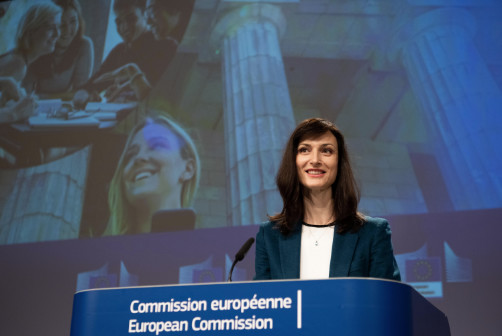
The new Erasmus+ programme for 2021–2027 was launched in March. With a budget of €26.2 billion, complemented by around €2.2 billion from the EU’s external instruments, the revamped programme will fund learning mobility and cross-border cooperation projects for 10 million Europeans of all ages and backgrounds. It will seek to be even more inclusive and to support the green and digital transitions, as set out in the priorities for the European Education Area.
Research, innovation and the European Research Area
In November, all Member States agreed on a Pact for Research and Innovation in Europe and on the governance of the European Research Area, setting out priorities and a streamlined governance framework for the area, including a policy agenda for 2022–2024. This will help to promote better alignment of regional, national and EU research and innovation strategies and investment. Member States, in consultation with stakeholders, will define and monitor progress according to a common European Research Area policy agenda. The fields covered range from research-and-innovation values and principles to strategic priorities for investment, such as in research infrastructure. The Commission will support common action to ensure long-term research-and-innovation investment and policy reforms.
A Union of equality

Equal pay for equal work
New measures on pay transparency aim to ensure that women and men in the EU get equal pay for equal work or for work of equal value. The Commission’s proposal, adopted in March, sets out measures, such as pay information for jobseekers, a right to know the pay levels for workers doing the same work or work of equal value and gender-pay-gap reporting and assessment obligations for big companies. In addition, employers will not be allowed to ask jobseekers for their pay history, preventing the continuation of the pay gap when changing jobs. The proposal is also aimed at strengthening the tools for workers to claim their rights and facilitating access to justice, for instance reinforcing the right to compensation for pay discrimination.
Since
1957
men and women in the EU have had the right to equal
pay
The gender pay gap in the EU stands at
14 %
The gender pension gap stands at
30 %
Rights of the child
To make the EU fit for the next generation of Europeans, in 2021 the Commission proposed a comprehensive new EU Strategy on the Rights of the Child and a European Child Guarantee. These major policy initiatives will help protect all children and help them exercise their rights. Both initiatives have been informed by extensive consultations with citizens, stakeholders and, most importantly, more than 10 000 children, in a determined effort to place them at the centre of EU policymaking. The strategy also appeared in easy-to-read versions for children of different ages and reading abilities.
The EU Strategy on the Rights of the Child is built on the key principle that every child in the European Union, and indeed across the world, should enjoy the same rights and live free from discrimination. The strategy aims to mainstream children’s rights across relevant EU and national policies. It entails follow-up action across six thematic areas:
- empowering children to be active citizens and members of democratic societies;
- fighting child poverty and promoting socioeconomic inclusion, health and education;
- combating all forms of violence against children and ensuring child protection;
- strengthening child-friendly justice;
- supporting and protecting children through the digital transition; and
- stepping up the EU’s work on children’s rights in its external action.
Indeed, this strategy also helps to position the EU as a key promoter and protector of children’s rights globally.
The strategy brings together, in one comprehensive and coherent framework, all new and existing EU legislative, policy and funding instruments that contribute to protecting and promoting children’s rights. The Commission has committed to taking action, adopting a European Child Guarantee in 2021 and an updated European Strategy for a Better Internet for Children in 2022.
The European Child Guarantee, which was proposed in March, aims to ensure that every child in the EU at risk of poverty or social exclusion has access to key services essential to promoting equal opportunities. These include early-childhood education and care, education and extracurricular activities, at least one healthy meal every school day, healthcare, and access to healthy food and adequate housing. The Council adopted this recommendation in just 3 months, and Member States have nominated national Child Guarantee coordinators who will oversee the implementation of the guarantee. Member States must submit their national plans by March 2022.
Fighting racism
In May, the European Commission appointed its first Anti-Racism Coordinator, delivering on an important commitment in the 2020 EU Anti-Racism Action Plan. The coordinator interacts with the European Parliament, Member States, civil-society organisations and academia to strengthen policy responses in the field of anti-racism. They also liaise closely with people with a minority racial and ethnic background and relay their concerns to the Commission. The coordinator will join forces with departments in the Commission to combat racism through employment, education, health and housing policies, or thanks to funding programmes like the Citizens, Equality, Rights and Values programme and the European Social Fund Plus.
In order to fight racism in a comprehensive way, in 2021 the Commission worked with Member States, civil-society organisations and equality bodies to support the development of national action plans against racism and racial discrimination, and to strengthen the impact of the coordinator’s actions in implementing the EU Anti-Racism Action Plan.
In this context, a subgroup to work with the Member States has been set up to focus on the national implementation of the action plan. The Commission organised the European Anti-Racism Summit on 19 March. It was co-hosted by the Portuguese Presidency of the Council of the European Union and the Anti-Racism and Diversity Intergroup of the European Parliament.
Roma equality, inclusion and participation
The Council recommendation on Roma equality, inclusion and participation, adopted in March, contains a comprehensive list of measures to combat discrimination and antigypsyism; advance social inclusion; promote participation and active citizenship; and ensure equal access to quality education, employment, health and housing. These measures range from fighting multiple forms of structural discrimination against Roma to ensuring access to employment for Roma in local and regional public institutions.
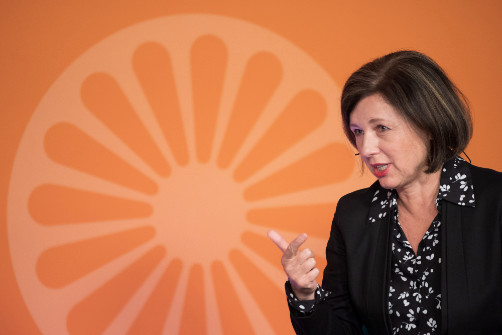
The recommendation is part of the 10-year strategic framework to advance Roma equality across the EU, and includes a stronger focus on partnerships and institutional capacity, support for civil society and community development, better use of funds and reinforced monitoring. The fight against antigypsyism, as a specific form of racism, was discussed at the EU Anti-Racism Summit and during the 14th European Platform for Roma Inclusion in September.
LGBTIQ equality
In November 2020, the Commission adopted the LGBTIQ Equality Strategy 2020–2025, which sets out the key objectives and initiatives to advance lesbian, gay, bisexual, trans, intersex and queer equality. Since then, the Commission has set up an LGBTIQ equality subgroup under the High-Level Group on Non-discrimination, Equality and Diversity to support and monitor progress in the Member States, including the development of national action plans on LGBTIQ equality.
In July, the Commission launched infringement proceedings against Hungary and Poland relating to equality and the protection of fundamental rights. The cases in Hungary concern the recently adopted law that, in particular, prohibits or limits access to content that promotes or portrays 'divergence from self-identity corresponding to sex at birth, sex change or homosexuality' for individuals under the age of 18, and a disclaimer imposed on a children’s book with LGBTIQ content. As the Commission’s concerns were not addressed, it decided on 2 December to send a reasoned opinion to Hungary, which was given 2 months to reply and remedy the situation. Otherwise, the Commission may decide to refer the Member State to the Court of Justice of the European Union.
In relation to Poland, the Commission considers that Polish authorities failed to fully and appropriately respond to its inquiry regarding the nature and impact of the 'LGBT-ideology-free zone' resolutions adopted by several Polish regions and municipalities. The Commission received a response from Poland to its letter of formal notice, and at the end of 2021 was analysing the reply before deciding on its next steps.
Fighting antisemitism
In October, the Commission adopted the first-ever EU Strategy on Combating Antisemitism and Fostering Jewish Life (2021–2030).
With antisemitism worryingly on the rise, the strategy sets out a series of measures around three pillars: preventing and combating all forms of antisemitism; protecting and fostering Jewish life in the EU; and fostering education, research and Holocaust remembrance. Member States have already committed to preventing and fighting all forms of antisemitism through national strategies and action plans on preventing racism, xenophobia, radicalisation and violent extremism.
Contemporary antisemitism occurs in many forms, old and new, from online hate speech, hate crimes and attacks on Jewish people, their properties and institutions to the desecration of cemeteries and memorials.
- Half of all people in the EU consider antisemitism a problem.
- Nine out of 10 (89 %) Jews in the EU consider that antisemitism has increased in their Member State.
- 79 % of Jewish people have not reported, to any organisation, the most serious antisemitic incident they have been subjected to.
- Jewish people are one of the major targets of toxic language online. Depending on the platform researched, toxic language is about them in 6.3 % to 27 % of cases.
Fighting hate crime and hate speech
In December, the Commission formally asked the Council to extend the list of 'EU crimes' laid down in the Treaty on the Functioning of the European Union to include hate speech and hate crime. The Framework Decision on Combating Racism and Xenophobia by means of Criminal Law only requires the criminalisation of racist and xenophobic hate speech and hate crime on certain grounds, such as race, colour, religion, descent or national or ethnic origin. The criminalisation of other forms of hate speech and hate crime – for example on grounds of sex, sexual orientation, age and disability – varies across the Member States. A Council decision to extend the list of 'EU crimes' will enable the Commission to propose, in the future, minimum rules to criminalise hate speech and hate crime on grounds other than racism and xenophobia.
The Commission is continuing its work to ensure the proper transposition and implementation of the framework decision through dialogue with national authorities and, where necessary, infringement procedures. In 2020 and 2021, the Commission launched proceedings against 13 Member States.
The Commission has continued its policy work on combating racist and xenophobic hate crime and hate speech by providing guidance to and exchanging good practices with national authorities and civil-society organisations in the context of the High-Level Group on Combating Racism, Xenophobia and Other Forms of Intolerance. In relation to implementing the Code of Conduct on Countering Illegal Hate Speech Online, in June the Commission announced the participation of the networking site LinkedIn. In October, the institution published the results of the yearly evaluation on the implementation of the code of conduct, which show that, while the results remain positive, progress has slowed.
Strategy on the Rights of Persons with Disabilities
87 million people in the EU have some form of disability. Everyone has an inherent right to a life without barriers, and persons with disabilities have the right to equal opportunities, to participate in society on an equal basis with others and to be free from discrimination and violence.
50.8 % of people with disabilities are in employment, compared to 75 % of those without disabilities.
28.4 % of people with disabilities are at risk of poverty or social exclusion, compared to 17.8 % of those without disabilities.
Only 29.4 % of people with disabilities attain a tertiary degree, compared to 43.8 % of those without disabilities.
52 % of people with disabilities feel discriminated against.
The EU’s Strategy for the Rights of Persons with Disabilities 2021–2030 – adopted in March and also published in an easy-to-read version – aims to ensure their full participation in society. The 10-year strategy tackles the diverse challenges that persons with disabilities face. It sets out measures to enhance equality in all aspects of everyday life, such as a decent quality of life, living independently and fully enjoying human and EU rights like free movement and the right to vote. The strategy also promotes equal access to work, justice, education, healthcare, culture, sport and tourism, along with protection against any form of discrimination.
Protecting and promoting fundamental rights under the charter
In December, the Commission adopted its '2021 annual report on the application of the EU Charter of Fundamental Rights', which focused on protecting fundamental rights in the digital age. The Commission also launched an awareness-raising campaign on people’s rights under the charter and on where to turn in case their rights have been breached. The Commission opened a call for proposals to promote and protect EU values under the Citizens, Equality, Rights and Values programme. This €51 million call will support civil-society organisations in the EU in their work to protect and promote fundamental rights and values. The report and call for proposals are deliverables of the Commission’s 2020 Strategy to Strengthen the Application of the Charter of Fundamental Rights in the EU.
Ageing and demography
Europe has undergone, and continues to face, profound demographic change. In the EU, life expectancy at birth has increased by 10 years for both women and men over the past five decades. Policies need to anticipate and address this trend, which is transforming societies and lifestyles. In January, the Commission published the Green Paper on Ageing, launching a public debate on the opportunities and challenges of ageing. The paper’s life-cycle approach reflects the universal impact of ageing on all generations and aims to strike the right balance between sustainable solutions for our welfare systems and intergenerational fairness and solidarity.
In April, the Commission launched the Atlas of Demography, an interactive tool to monitor and assess demographic trends at the EU, national and local levels. It contains official statistics and projections from Eurostat and new data produced by the Commission’s Joint Research Centre, along with data stories on specific issues that provide a wide range of demographic evidence, helping to place demographic analysis at the core of EU policymaking. In June, the Council and the Commission published reports on long-term care and pension adequacy, outlining the well-being of older people in the EU in the next few decades. The number of people potentially in need of long-term care in the EU-27 is projected to rise from 30.8 million in 2019 to 38.1 million in 2050, while expenditure on long-term care in the EU is projected to increase from 1.7 % of GDP in 2019 to 2.5 % of GDP in 2050.
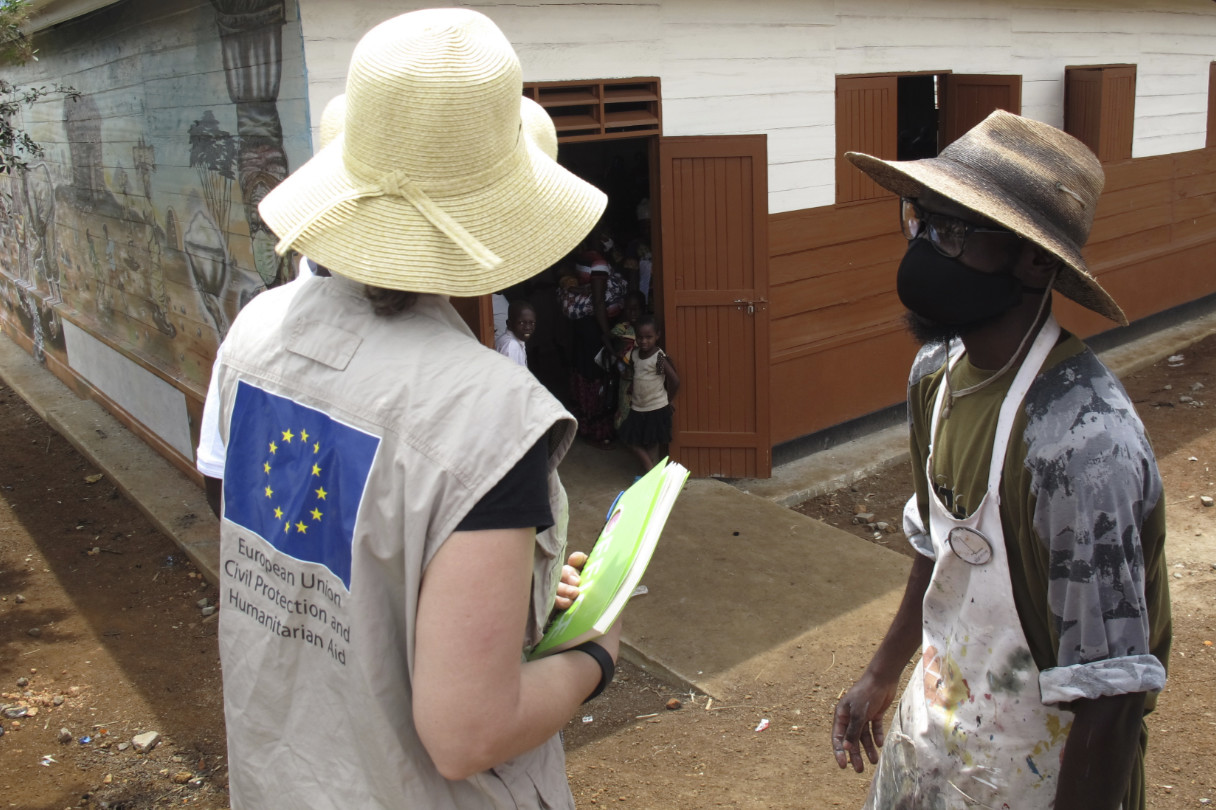
Promoting European interests and values in the world
The EU as a multilateral partner
The COVID-19 pandemic has demonstrated again that the 'my country first' approach does not work. This is why the European Union believes in a multilateral approach to meeting the common challenges and problems faced by humanity. The EU works with global partners in multilateral organisations, international financial institutions and coalitions to make life better, healthier and more secure for people in Europe and around the world. Supporting a rules-based international order is not just an article of faith for the EU: multilateralism has enabled the longest period of global peace, stability and progress towards sustainable development.
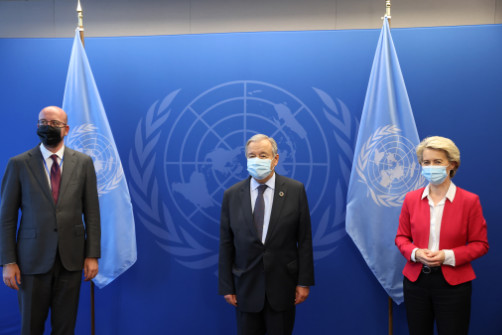
The main multilateral organisations see an increasing tendency towards vetoing and scoring national points instead of searching for common ground. As a result, the UN Security Council is gridlocked, and the World Health Organization and World Trade Organization (WTO) both see their policies being contested.
The EU wants and needs these organisations to succeed. Against the backdrop of growing public scepticism about the benefits of multilateral cooperation, it is crucial to demonstrate why it is still relevant and necessary to work together with international partners such as the UN. In 2021, therefore, the EU continued to support the UN Secretary-General’s efforts to reform the multilateral system and make it fit for purpose, in particular by implementing the 2030 Agenda on Sustainable Development.
In 2021, the EU and the UN worked together in more than 170 countries:
Preventing and overcoming crises
Protecting those at risk from war, disease and natural disasters
Supporting non-proliferation and disarmament
Tackling hunger and malnutrition
Building democratic and inclusive societies
Delivering essential services
Helping sustainable economic growth and decent jobs
Combating climate change
Fighting the COVID-19 pandemic
In February, the EU set out its expectations and ambitions for the multilateral system in a joint communication that promotes the modernisation of key institutions and supports the development of new global norms and the establishment of cooperation platforms in areas such as taxation, the digital sphere and artificial intelligence.

Taking a lead in multilateral forums
The EU is a major driver of international cooperation. In 2021, it continued to spearhead ambitious targets on sustainability ahead of the COP26 UN Climate Change Conference in Glasgow, United Kingdom (see Chapter 2) and the UN Biodiversity Conference in Kunming, China, and to lead globally in the implementation of the UN Sustainable Development Goals.
In May, the EU, together with the Italian G20 Presidency, co-hosted a Global Health Summit that culminated in a declaration of principles that will guide global action on health matters in the coming years. At the June G7 Leaders’ Summit in Cornwall, United Kingdom, the global pandemic recovery was high on the agenda, and the EU took a leadership position. G7 leaders pledged 1 billion vaccine doses for low- and medium-income countries, and that they would accelerate the production and worldwide delivery of vaccines.
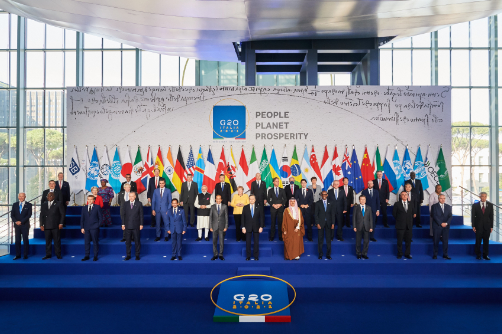
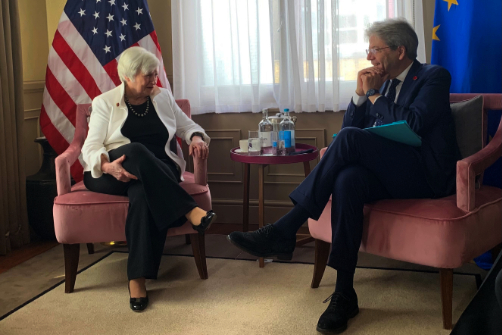
At the October G20 Summit in Rome, G20 leaders endorsed a proposal from their finance ministers to establish a global minimum tax rate of at least 15 % for multinational corporations. This was a significant breakthrough agreement by 136 jurisdictions after many years of negotiations. The agreement will also ensure that the world’s most profitable multinationals pay taxes in the countries where they generate their revenues, and not only where they have their headquarters.
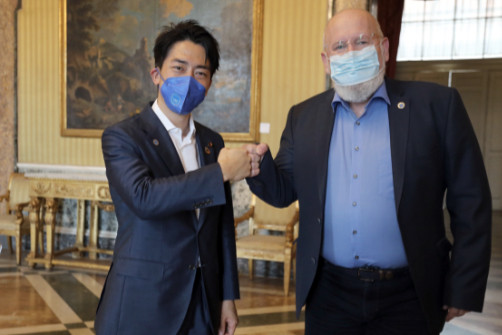
On 28 and 29 June, Josep Borrell, the High Representative, participated in the first in-person ministerial meetings under the Italian G20 Presidency in Matera, Italy. The was followed by a joint meeting of foreign and development ministers, attended by Jutta Urpilainen, Commissioner for International Partnerships. The foreign ministers discussed multilateralism and global governance, and how to fight the pandemic together and build back better. They also discussed how to renew the momentum of the Sustainable Development Goals, especially in Africa.
Peace and security
In a challenging global environment, the EU needs to enhance its ability to prevent conflicts and to strengthen international peace and security. With the new European Peace Facility, the EU is taking on more responsibility as a global security provider. The facility will fund the common costs of military missions and operations under the Common Security and Defence Policy, along with assistance measures to support partners in military and defence matters. The assistance granted can benefit partners around the world that face major security challenges and that EU Member States decide to support.
The European Peace Facility will maximise the impact, effectiveness and sustainability of overall EU external action in peace and security:
ensuring the availability of EU funding on a reliable and predictable basis;
allowing for rapid crisis response and the provision of urgent assistance;
providing Long-term capacity building support to EU partners.

The European Peace Facility is a new fund worth €5 billion, financed outside the EU budget for a 7-year period (2021–2027), which:
create a single instrument to finance all Common Foreign and Security Policy actions in military and defence areas;
replace the Athena mechanism ans the African Peace Facility, taking over the military and defence related aspects previously covered under thos instruments.
Josep Borrell, the High Representative, together with Member States, has taken work forward on developing the Strategic Compass. It sets out a vision for security and defence for the next 5–10 years and puts forward concrete proposals for EU action across various security and defence dimensions, from crisis management and resilience to capabilities and partnerships. The first draft of the Strategic Compass was presented by the High Representative to the Member States in November 2021, and it is expected to be adopted in March 2022.
Development and humanitarian aid
The EU and its 27 Member States significantly increased their assistance to partner countries in 2020, to €66.8 billion. The EU is the world’s leading aid donor, providing 46 % of global assistance.
The EU allocated over €2.1 billion in humanitarian aid in 2021, including to respond to the urgent needs stemming from COVID-19. EU-organised Humanitarian Air Bridge flights delivered over 20 tonnes of humanitarian aid to Mozambique, and more than 177 tonnes to Haiti following the devastating earthquake in that country.
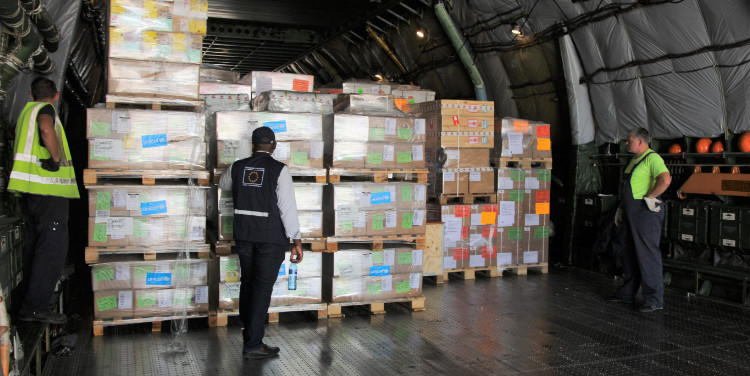
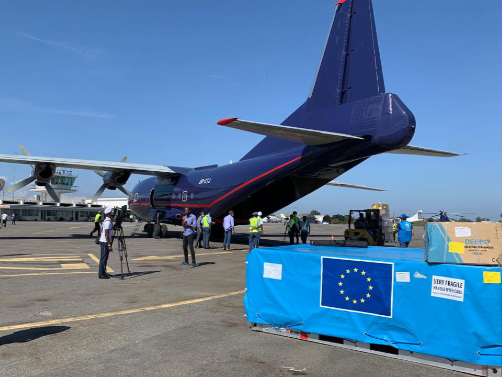
The EU supported vulnerable people by providing life-saving assistance in countries overcome by conflict, such as Afghanistan, Ethiopia and Yemen. The EU continued to support vulnerable people inside Syria, along with Syrian refugees in Turkey and other countries in the region.
To address an unprecedented set of challenges facing humanitarian efforts, in March the Commission adopted a renewed strategic outlook to strengthen the EU’s global humanitarian impact and continue to provide leadership. The communication on the EU’s humanitarian action proposed key initiatives for the more efficient use of resources; faster delivery of humanitarian aid by supporting humanitarian partners – including by setting up a European Humanitarian Response Capacity using a Team Europe approach; expanding the donor base inside and outside Europe; and addressing the root causes of crises by delivering humanitarian aid in close collaboration with development and peacebuilding organisations. It proposed concrete steps to put compliance with international humanitarian law consistently at the heart of the EU’s external action, and set out plans to tackle the dramatic humanitarian impact of climate change.
Between 2021 and 2027, the Neighbourhood, Development and International Cooperation Instrument – Global Europe, with €79.5 billion in funding – including €60.39 billion for geographic programmes – will finance EU cooperation with non-EU countries (except for pre-accession beneficiaries and overseas countries and rogrammes – will finance EU cooperation with non-EU countries (except for pre-accession beneficiaries and overseas countries and territories).
The Neighbourhood, Development and International Cooperation Instrument – Global Europe will be the EU’s main financing tool to contribute to eradicating poverty and promoting sustainable development, prosperity and stability.
More funding for EU external actions
Simplified: fewer instruments, and the European Development Fund becoming part of the budget
Flexibility on a multiannual basis to respond to changing circumstances
Increased transparency and democratic scrutiny

The geographic pillar of the Neighbourhood, Development and International Cooperation Instrument – Global Europe (N D I C I Global Europe), with a budget of 60.39 billion euro, will foster dialogue and cooperation with non-EU countries. Each regional envelope will be adapted to the needs and priorities of the respective countries and regions, and will reflect the EU’s strategic priorities. Through the N D I C I Global Europe, the EU will allocate at least 19.32 billion euro for the neighbourhood, i.e. countries in eastern Europe and North Africa, at least 29.18 billion euro for sub-Saharan Africa, 8.49 billion euro for Asia and the Pacific and 3.39 billion euro for the Americas and the Caribbean. The map also shows countries that fall under the instrument for pre-accession assistance and the instrument for cooperation with overseas countries and territories.
Promoting human rights and democracy worldwide
The Gender Action Plan adopted in November 2020 focuses on making gender equality and women’s and girls’ empowerment a priority of EU external action. By 2025, 85 % of new EU initiatives should contribute to achieving this objective.
At the Global Education Summit in London, United Kingdom, in July, the EU and its Member States, as Team Europe, pledged €1.7 billion to the Global Partnership for Education to help transform education systems for more than 1 billion girls and boys in up to 90 countries and territories. This represents the biggest contribution to the partnership.
In December, President von der Leyen represented the European Commission at the Summit for Democracy hosted by the President of the United States, Joe Biden. The summit brought together leaders from governments, civil-society organisations and the private sector in an effort to put forward an affirmative agenda for democratic renewal and to tackle the greatest threats faced by democracies today through collective action. Also in December, President von der Leyen announced the new Global Europe Human Rights and Democracy programme, worth €1.5 billion.
In 2021, for the first time, the EU used the Global Human Rights Sanctions Regime it had adopted in December 2020. Sanctions were issued against individuals and entities from China, Eritrea, Libya, North Korea, Russia and South Sudan. They are responsible for serious human-rights violations and abuses, ranging from torture, extrajudicial executions and killings to the enforced disappearance of people, arbitrary arrests or detentions and the systematic use of forced labour.
Election observation continues to be a highly visible demonstration of the EU’s commitment to supporting democratic processes. In 2021, despite the constraints caused by COVID-19, the EU deployed six election-observation missions, to Honduras, Iraq, Kosovo (this designation is without prejudice to positions on status, and is in line with UNSCR 1244/1999 and the ICJ Opinion on the Kosovo declaration of independence), The Gambia, Venezuela and Zambia. Smaller missions of electoral experts, along with follow-up missions, were deployed to more than 10 countries to analyse elections, assess progress on the implementation of previous EU recommendations and help to improve the conditions for future electoral processes. Taking account of the new challenges to democracy that stem from digital technologies, innovative elements have been introduced into EU election observation to analyse the online dimension of all electoral processes. Furthermore, the Commission has endorsed, and is promoting internationally, common guidelines on the observation of online campaigns and on best practices for electoral technologies.
Arctic dimension
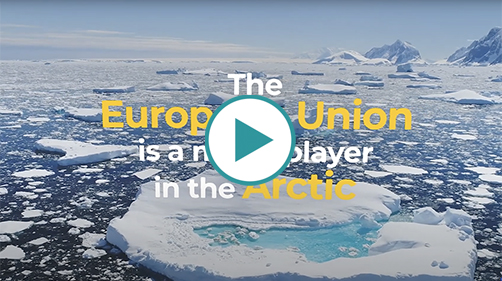
In October, the EU updated its Arctic Policy to focus on climate action and environmental protection, along with green jobs and increasing international cooperation across the Arctic region, including European-led scientific initiatives. In November, the Commission and the European External Action Service organised an Arctic Forum and an Indigenous Peoples’ Dialogue to listen to the needs and perspectives of the region’s inhabitants. It increases the EU’s engagement in the Arctic and brings it into line with the goals of the European Green Deal and the EU’s geopolitical role in the world. The EU will continue to work with its partners to ensure that the Arctic remains a peaceful region in which there is effective international cooperation.
Oceans
During the 2021 International Ocean Governance Forum, the EU presented its recommendations on ocean sustainability. International ocean governance plays a crucial role in halting the loss of biodiversity and in fighting climate change. The European Commission has announced that it will update the EU’s International Ocean Governance Agenda in 2022 to make sure that it remains fit for purpose.
In April and September, Virginijus Sinkevičius, Commissioner for Environment, Oceans and Fisheries, hosted ministerial meetings to build support for designating new marine protected areas in the Southern Ocean. The meetings took place ahead of the 40th Annual Meeting of the Commission for the Conservation of Antarctic Marine Living Resources in October, and served to coordinate the actions of the co-sponsors.
Global Gateway
In December, the EU launched the Global Gateway, a new initiative to develop smart, clean and secure connections in the digital, energy and transport sectors and to strengthen health, education and research systems across the world. The COVID-19 pandemic has exposed gaps in global infrastructure, contributing to disruptions to supply chains and an ensuing scarcity of medical and other goods, with significant human and economic consequences. The green and digital transitions are also creating additional infrastructure needs. The Global Gateway will develop sustainable and high-quality infrastructure while ensuring financial sustainability, with funding from the EU, its Member States and European financial institutions (Team Europe) and the participation of the private sector. It aims to mobilise investment totalling up to €300 billion between 2021 and 2027.
Improvements to physical infrastructure (such as more fibre-optic cables) will be complemented by business-friendly trading conditions and regulatory convergence to reduce bumps in the global delivery system. Democratic values, equal partnerships, good governance, climate neutrality and security will guide all spending under the Global Gateway, in line with the EU’s external-action principles on human rights, the Sustainable Development Goals and the goals of the Paris Agreement.

Through the global gateway, the EU will support an open and secure internet, investment and rules paving the way for the clean-energy transition, and all modes of green, smart and safe transport. The EU will also help strengthen supply chains and local vaccine production, and will invest in high-quality education, with a special focus on girls and women and on vulnerable groups.
Trade
The Commission’s 2021 report on trade and employment found that over 38 million jobs in the EU are supported by EU exports, which is 11 million more than a decade ago. These jobs are on average 12 % better paid than those in the economy as a whole.
The Commission presented a strategy on an open, sustainable and assertive trade policy in February. It prioritises a major reform of the WTO to include global commitments on trade and the climate; new rules for digital trade; reinforced rules to tackle competitive distortions; and the restoration of its system for binding dispute settlement.
The new strategy also focuses on strengthening the capacity of trade to support the digital and climate transitions. It will contribute to achieving the European Green Deal objectives by promoting the green transition through trade agreements, the Generalised Scheme of Preferences and engagements in the WTO. Furthermore, it will remove unjustified trade barriers in the digital economy to reap the benefits of digital technologies in trade. By reinforcing its alliances, such as the transatlantic partnership, and having a stronger focus on neighbouring countries and Africa, the EU will be better able to shape global change.
In tandem, the EU has adopted a more assertive approach to implementing and enforcing its trade agreements, fighting unfair trade practices, defending the EU’s values and standards abroad, helping small and medium-sized enterprises make use of the EU’s trade agreements and addressing sustainability concerns.
In 2021, the EU took part in a number of priority WTO negotiations. The fisheries subsidies negotiations are the only ongoing negotiations that include all WTO members, and are therefore extremely significant. In parallel, the EU proposed an initiative to keep supply chains for COVID-19-related goods and vaccines open, by limiting unnecessary export restrictions and boosting the production and distribution of vaccines. Finally, the EU has proposed to prioritise a commitment to identifying how WTO rules can further boost environmental sustainability and mitigate climate change.
While the WTO’s 12th Ministerial Conference was regrettably postponed, this did not completely scupper progress. In 2021, the EU, together with 67 other WTO members, concluded an agreement to simplify trade in services, the Joint Initiative on Services Domestic Regulation. This is the first WTO deliverable in the area of trade in services – in a very long time, and early estimates show that this agreement will reduce the costs of global services trade by more than $150 billion every year. The EU also signed up to three new initiatives in the fields of trade and the environment and trade and climate.
Generalised Scheme of Preferences
In September, the Commission adopted a legislative proposal to reform the EU’s Generalised Scheme of Preferences for 2024–2034. The scheme supports the economies of developing countries by reducing or removing tariffs on their exports to the EU, and allowing their increased participation and involvement in global value chains. The proposal for a new regulation makes the scheme more focused on reducing poverty and on increasing export opportunities for those countries most in need. It also expands the list of conventions on human and labour rights, the environment and good governance with which beneficiary countries must comply, and facilitates the possibility of withdrawing EU preferences in response to serious and systematic violations of those conventions.
Ongoing/new trade negotiations
Strengthening trade relationships with Asia and Africa remained a priority in 2021. The EU is deepening its existing agreements with eastern and southern Africa and negotiating an investment facilitation agreement with Angola. In the Asia–Pacific region, negotiations continued with Australia, Chile, Indonesia and New Zealand.
In May, the EU and India agreed to resume negotiations on a balanced, ambitious, comprehensive and mutually beneficial trade agreement, and to launch negotiations on both a stand-alone investment protection agreement and an agreement on geographical indications.
Instrument to deter and counteract coercive actions by non-EU countries
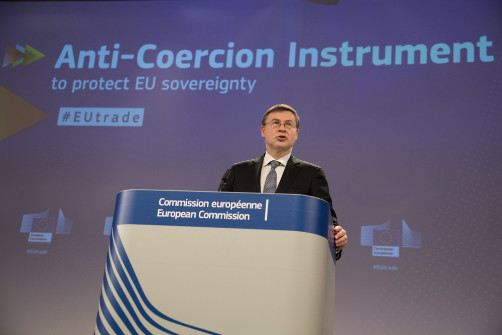
Economic coercion refers to specific situations in which a non-EU country seeks to pressure the EU or its Member States into making a particular policy choice through formal or informal measures such as imposing tariffs or stopping shipments. In December, the Commission proposed a new instrument to deter or, if necessary, counter economic coercion. The Anti-Coercion Instrument is designed to de-escalate and induce the discontinuation of specific coercive measures through dialogue as a first step. However, when there is no other way to address economic intimidation, the EU’s response may consist of soft measures (negotiations, determination of the non-EU country’s act as coercive) or, as a last resort, countermeasures in the form of trade, investment or other restrictions.
Dual-use export control
In 2021, the EU strengthened its ability to respond to new security risks posed by emerging technologies. The new Export Control Regulation entered into force in September and tightened controls on trade in dual-use items – civilian goods and technologies with possible military or security uses – while enhancing the EU’s capacity to protect human rights and support secure supply chains for strategic items.
The new framework allows the EU to put in place a number of important measures to pool expertise and tackle particular challenges, relating in particular to cyber surveillance – where due diligence guidelines are in preparation – but also to emerging dual-use technologies such as advanced computing.
Foreign direct investment screening
Today, more than ever, the EU’s openness to foreign direct investment needs to be balanced by appropriate screening tools to safeguard security and public order. The Member States and the Commission are working closely together to ensure that any such investment that could pose a security risk to EU Member States or EU critical assets is effectively screened. The first annual foreign direct investment screening report was published in November 2021.
Research and innovation
In May, the Commission adopted a communication on its Global Approach to Research and Innovation. The new strategy builds on two main objectives. First, it aims for a research and innovation environment that is based on common values and agreed rules and is open to helping researchers and innovators around the world work together in multilateral partnerships and find solutions to global challenges. Second, it aims to ensure reciprocity and a level playing field on international cooperation in research and innovation. Action includes support for researchers and their organisations to help accelerate sustainable and inclusive development in low- and middle-income countries, including through an ambitious Africa Initiative under Horizon Europe to strengthen cooperation with African countries. The Horizon Europe work programme for 2021 and 2022 includes around 40 topics with a budget of around €350 million under calls for proposals that are particularly relevant for cooperation with Africa.
Africa
Throughout 2021, the EU continued to work closely with its partners in Africa on the basis of the 2020 joint communication on a comprehensive strategy with Africa. African and EU foreign affairs ministers met in Kigali, Rwanda, in October to take stock of the Africa–EU partnership and define joint priorities ahead of the next European Union–African Union Summit in February 2022. They agreed to pursue cooperation on the COVID-19 response, including access to vaccines, economic recovery, investing in the green and digital transitions, peace, security and governance, and migration and mobility.
The EU–Africa Business Forum in April brought together more than 3 000 participants – including government representatives, business leaders and investors – from Africa and Europe. They discussed how to accelerate the transition to green energy in Africa, widen energy access and, in doing so, create jobs and a sustainable economic recovery from COVID-19. Through the online Debating Africa–EU series, decision-makers, civil-society representatives and youth representatives from both continents had the chance to air their views on the priorities ahead.
Team Europe is supporting local manufacturing and access to vaccines, medicines and health technologies in Africa. This support is backed by €1 billion from the EU budget and European development finance institutions, and by cooperation between the European Centre for Disease Prevention and Control and the Africa Centres for Disease Control and Prevention.
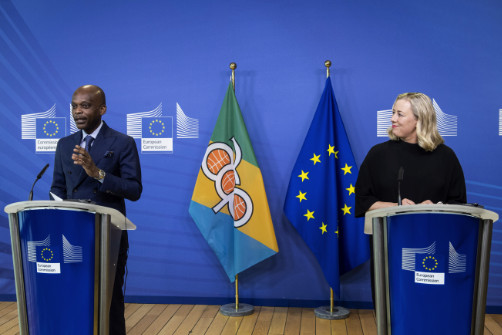
A new partnership agreement between the EU and members of the Organisation of African, Caribbean and Pacific States was initialled on 15 April 2021. It establishes a 20-year framework for political and economic relations and cooperation priorities. It also contains a substantive and extensive Africa Protocol – one of three regional protocols – with a focus on the continent’s specific needs.
The geographic pillar of the Neighbourhood, Development and International Cooperation Instrument – Global Europe fosters dialogue and cooperation with countries outside the EU. The €60.39 billion budget for this pillar of the instrument includes at least €29.18 billion for sub-Saharan Africa (for 2021–2027).
Ethiopia
Throughout 2021, the EU continued to monitor the situation in Ethiopia closely. The conflict in the Tigray region has led to a devastating humanitarian crisis, undermining the territorial integrity and stability of the country and impacting the whole region. Violence has forced nearly 3 million people to flee their homes and has left more than 5 million people in need of urgent humanitarian assistance. In December, the EU called for an unconditional ceasefire and urged all parties to engage in an inclusive and transparent national dialogue. Ensuring the protection of civilians and providing unhindered humanitarian access remain key priorities. The EU supports regional and African Union mediation efforts, led by Olusegun Obasanjo, High Representative for the Horn of Africa. The EU remains ready to use all of its foreign-policy tools, including restrictive measures, to promote peace and adherence to international humanitarian and human-rights law, and to help end the conflict. In 2021, the EU allocated over €85.2 million to humanitarian projects in Ethiopia, including €48 million specifically for the people affected by the conflict in northern Ethiopia.
Sahel
The European Union is one of the largest providers of humanitarian aid to Africa’s Sahel countries. In December, it allocated €15 million in additional humanitarian funding to the region, in response to the unprecedented food crisis affecting more than 8.7 million people in Burkina Faso, Mali, Mauritania and Niger. During the year, the EU allocated a total of €237.4 million to the Sahel. Part of this funding has been used to help tackle the food crisis in the region, which is now in its fourth consecutive year and mainly affects people in conflict-hit areas. In June, the EU reaffirmed its support for the efforts of the G5 Sahel countries (Burkina Faso, Chad, Mali, Mauritania and Niger) to strengthen governance, the rule of law and the provision of public services in their territories.
EU leaders strongly condemned the coup d’état that took place in Mali on 24 May 2021, and stated that the EU was ready to consider targeted restrictive measures. In December, the Council set up an autonomous framework for sanctions against those responsible for threatening the peace, security or stability of Mali, or who obstruct the implementation of its political transition.
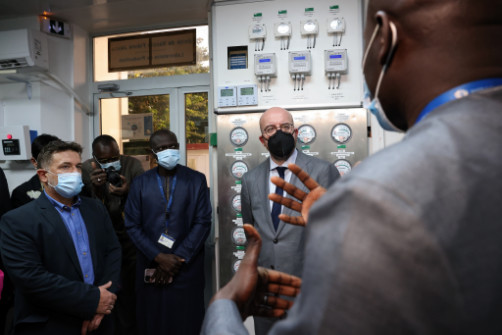
Western Balkans and enlargement
The EU’s commitment to the European perspective of the region and to the enlargement process was reconfirmed at the EU–Western Balkans Summit at Brdo pri Kranju, Slovenia, in October 2021. The Commission started to implement the revised enlargement methodology, which is also reflected in the Commission’s 2021 enlargement package, adopted on 19 October, the Economic and Investment Plan for the region and the Instrument for Pre-accession Assistance legal framework.
The Economic and Investment Plan for the Western Balkans represents a substantial investment package, mobilising up to €30 billion in investment over the next 7 years, amounting to one third of the region’s gross domestic product. The Instrument for Pre-accession Assistance will be the main funding source for this plan, contributing to long-term post-pandemic recovery, boosting economic growth and convergence and supporting reforms needed to move forward on the EU path.
At the EU–Western Balkans Summit, leaders launched the Western Balkans Agenda on Innovation, Research, Education, Culture, Youth and Sport. It will promote scientific excellence and reform of the region’s education systems, create further opportunities for youth and help prevent brain drain. The leaders also endorsed the preparation of the roadmap on roaming between the EU and the Western Balkans, building on 'Roam Like at Home' – roaming without charge within the region – which came into force on 1 July.
Albania and North Macedonia continued to fulfil the conditions for the official launch of accession negotiations. The EU welcomed the opening of cluster 4 on the 'Green agenda and sustainable connectivity' with Serbia in December, and held two political intergovernmental conferences with Montenegro.
Neighbourhood policy
Southern Neighbourhood
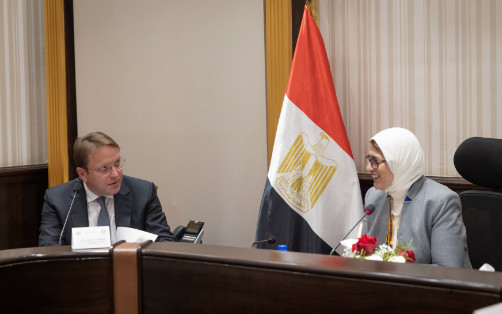
In February, the European Commission and the High Representative adopted the new Agenda for the Mediterranean to renew the partnership with its Southern Neighbourhood. The agenda reiterates the importance of an upgraded and intensified political dialogue across the Mediterranean to strengthen cooperation on issues such as peace and security, the rule of law, public-administration reforms, health, migration, climate change and the digital transition. It also includes a dedicated Economic and Investment Plan, with initiatives in strategic sectors to spur sustainable and inclusive long-term socioeconomic recovery – including in the context of the COVID-19 pandemic – build prosperity, increase trade and support competitiveness.
Key themes
- Human development, good governance and the rule of law.
- Resilience, prosperity and the digital transition.
- Peace and security.
- Migration and mobility.
- The green transition: climate resilience, energy and the environment.
Funding
The new agenda will guide the EU’s bilateral, regional and cross-regional cooperation under the Neighbourhood, Development and International Cooperation Instrument – Global Europe.
For 2021–2027, the European Commission proposes to mobilise up to €7 billion under the instrument, with specific tools provided by the European Fund for Sustainable Development Plus and the Neighbourhood Investment Platform. This would help mobilise private and public investment of up to €30 billion in the Southern Neighbourhood.
Syria
The Fifth Brussels Conference on 'Supporting the Future of Syria and the Region' marked a tragic anniversary: in the 10 years since the start of the conflict more than 400 000 people have died, the economy is in freefall and 90 % of Syrians live in poverty. The COVID-19 pandemic has worsened an already dire situation. The conference generated €5.3 billion in new global pledges, including €3.7 billion from the EU and its Member States, in support of humanitarian, resilience, stabilisation and development activities in Syria and the region. The EU will continue to support the efforts led by the United Nations and the UN Special Envoy, Geir Pedersen, and to engage diplomatically to build a consensus that can put an end to the war.
Libya
The EU seeks to help Libya and the Libyan people to restore peace and resume the transition to democracy. In June, the EU confirmed its commitment to Libya’s stabilisation process under the auspices of the United Nations. Following the postponement of elections that were due to take place in December 2021, the EU called on Libya to devise a plan and a clear calendar for holding inclusive, free, fair and credible presidential and legislative elections as soon as possible, and in full compliance with the agreed political road map. The EU has offered to support the Libyan authorities in preparing the electoral process.
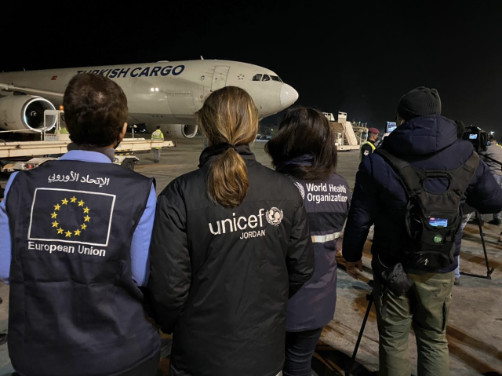
Eastern Partnership
In December, at the sixth Eastern Partnership Summit, leaders of the EU, the Member States and Armenia, Azerbaijan, Georgia, Moldova and Ukraine set out their shared vision for the future of the Eastern Partnership. The first in-person leaders’ summit in 4 years, which took place in a challenging geopolitical environment in the region and amid the continued severe socioeconomic impact of the COVID-19 pandemic, served as an opportunity to send a message of solidarity between the EU and its partners. Belarus had an empty chair at the gathering as a sign of the EU’s support for the Belarusian people in the face of the repression by the regime.
The summit endorsed the renewed cooperation agenda for the Eastern Partnership outlined in the proposal presented by the Commission and the High Representative in July. The aim is to increase trade, growth and jobs, improve connectivity, strengthen democratic institutions and the rule of law, support the green and digital transitions and promote fair, gender-equal and inclusive societies. It is underpinned by an Economic and Investment Plan for the region with the potential to mobilise up to €17 billion in public and private investment to accelerate sustainable post-pandemic recovery and strengthen the resilience of eastern partners.
In May, the Commission presented a Comprehensive Plan of Economic Support to a Future Democratic Belarus. The plan, worth up to €3 billion, reflects the EU’s commitment to supporting the Belarusian people’s wishes for a peaceful democratic transition. In December, the Commission also announced further immediate support of €30 million for the Belarusian people, particularly for young people and independent media.
In June, the Commission announced an Economic Recovery Plan for the Republic of Moldova that will mobilise up to €600 million to promote investment that will underpin a sustainable and inclusive recovery from the COVID-19 crisis in the country. In November, the EU announced €60 million in extraordinary support for Moldova to help cope with rising gas prices and strengthen the country’s green transition and energy security.
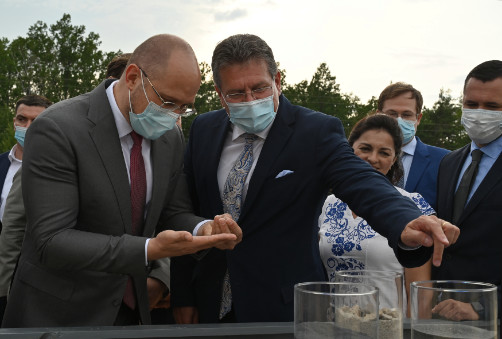
In October, the 23rd summit between the European Union and Ukraine took place in Kyiv. Leaders discussed progress in a number of areas of cooperation, along with ways to step them up. They reaffirmed the continued commitment to strengthening the political association and economic integration of Ukraine with the European Union, on the basis of the association agreement and its deep and comprehensive free trade area. Areas in which the leaders agreed to further enhance economic integration and cooperation include integrating Ukraine’s energy markets and energy systems with the EU energy market, establishing a level playing field, continuing gas transit via Ukraine beyond 2024, modernising Ukraine’s gas transmission system and strengthening energy security in the EU.
The EU and Ukraine are implementing the association agreement and exploring possibilities for further sectoral cooperation. Cooperation has been enhanced in a number of areas, for example in the digital sphere, where Ukraine is very well advanced, and the high-level Green Deal dialogue to assist Ukraine in its green transition. The EU provides substantial support for reforms in Ukraine, including land, decentralisation and justice reform.
In the context of the challenges to European security imposed by Russia, the EU scaled up support to ensure Ukraine’s resilience. This included adopting an assistance measure – worth €31 million – under the European Peace Facility to support the capacities of the Ukrainian armed forces, including military medical units, logistics and cyberdefence. In 2021, the EU also launched a dialogue on cybersecurity with Ukraine.
In October, Ukraine signed an agreement with the EU on its participation in Horizon Europe (the EU’s Framework Programme for Research and Innovation) and the Euratom Research and Training Programmes.
The EU continued its strong cooperation with Georgia in 2021. The EU also stepped up its efforts to strengthen resilience, reconciliation and peacebuilding in the South Caucasus, in particular by providing over €17 million in humanitarian and early recovery assistance to those people most affected by the recent hostilities in relation to Nagorno-Karabakh.
The EU–Armenia Comprehensive and Enhanced Partnership Agreement entered into force in March 2021, aiming at deepening and strengthening relations.
Turkey
In 2021, EU–Turkey relations remained a focus of political attention. Both sides engaged in efforts to relaunch cooperation, in order to decrease tensions by increasing dialogue and exchanges on issues of mutual interest. In March, the European Commission and the High Representative adopted a joint communication on the state of play of EU–Turkey political, economic and trade relations, which was welcomed by the European Council on 25 March 2021. The EU agreed to engage with Turkey in a phased, proportionate and reversible manner to enhance cooperation in a number of areas of common interest, provided that the de-escalation is sustained and that Turkey engages constructively and subject to the established conditions. While differences and tensions continued to persist as regards the situation in the eastern Mediterranean, and were marked most notably by worrying developments in Varosha, the general situation de-escalated compared to the year before.
After being tasked by the European Council (statement of 25 March 2021 and conclusions of 24 and 25 June 2021) with launching work in areas of mutual interest, the EU held high-level dialogues with Turkey on climate, migration and security, and health. Dialogue at senior-official level resumed on counterterrorism issues. In the area of migration, the March 2016 EU–Turkey Statement continued to yield results, and remained the key framework for cooperation on migration. Turkey sustained its very commendable efforts to host around 4 million refugees from Syria and other countries, and the EU continued to provide significant financial support to this end. Both the EU and Turkey continued to benefit from their trade relations, although trade irritants continued to hamper smooth cooperation and progress despite the EU’s repeated attempts to raise the subject with Turkey.
As regards the internal situation, and notably the state of play in the area of fundamental rights and freedoms, Turkey did not reverse the negative trend of moving further away from the European Union. Issues of the rule of law and fundamental rights in Turkey, such as the targeting of political parties and the media, remain a key concern for the EU, and run counter to its obligation to respect democracy, the rule of law and women’s rights. Turkey’s withdrawal from the Istanbul Convention and its refusal to implement the rulings of the European Court of Human Rights caused serious concern. The EU continued to raise these issues with Turkish authorities at all levels, as they are an integral part of Turkey’s obligations as a candidate country, and absence of progress in this regard seriously hampers the prospects for enhancing EU–Turkey cooperation. Turkey’s accession negotiations remained at a standstill.
United States
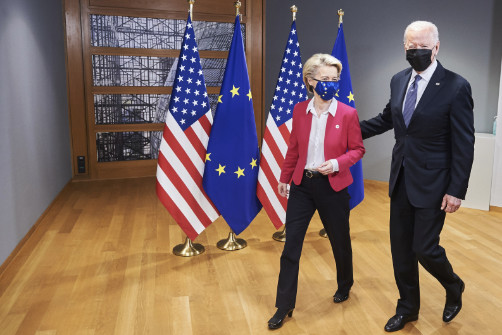
The inauguration of President Joe Biden and his new administration opened a new chapter in EU–US relations. The EU–US Summit on 15 June in Brussels marked the beginning of a renewed transatlantic partnership and set a joint agenda for EU–US cooperation in the post-pandemic era. The summit focused on cooperation in four key areas: the COVID-19 response and global health; climate and biodiversity; trade and technology; and global action and security. Key summit deliverables include three major new trade initiatives. The leaders agreed to create a Cooperative Framework for Large Civil Aircraft to address the WTO Airbus– Boeing dispute, among other things; resolve differences on measures regarding steel and aluminium by the end of the year; and establish an EU–US Trade and Technology Council. This was the first EU–US Summit since 2014, and the first visit by a US president to the EU institutions since 2017.

The EU–US Trade and Technology Council launched by European Commission President Ursula von der Leyen and US President Joe Biden is intended to serve as a forum to coordinate approaches to key global trade, economic and technology issues and to deepen transatlantic trade and economic relations based on shared democratic values. The council’s first meeting took place on 29 September in Pittsburgh, United States, during which the two sides adopted a joint statement further outlining its scope and work programme.
In October, the EU and the United States reached an agreement on measures regarding steel and aluminium that led to the restoration of duty-free imports of steel and aluminium into the United States from the EU at a historical-based volume, while the EU suspended related tariffs on US products. As part of this agreement, the two sides intend to negotiate, for the first time, a global arrangement on decarbonising steel production.
On 23 October 2021, Croatia joined the US Visa Waiver Program. Achieving full visa waiver reciprocity with the United States remains an EU priority, with work continuing to include the three outstanding Member States (Bulgaria, Cyprus and Romania) in the programme.
Canada
At the EU–Canada summit in Brussels in June, leaders discussed how to work together to end the COVID-19 pandemic and pursue a sustainable, people-centred and inclusive recovery. They reaffirmed their ambitious commitments to fighting climate change and protecting the environment, and their determination to promote democratic values, peace and security. They also launched a new Canada–EU dialogue on health, an Ocean Partnership Forum and a Strategic Partnership on Raw Materials.
Latin America
The EU–Latin America and Caribbean Leaders’ Meeting on 2 December 2021 marked the resumption of bi-regional dialogue at the highest level, 6 years after the last summit. Leaders from both regions identified avenues for cooperation on the recovery from the COVID-19 pandemic, the green and digital transitions, social inclusion and addressing inequalities. Future joint work will be supported by the geographic pillar of the new Global Europe Instrument, which has reserved at least €3.395 billion for the Americas and the Caribbean for 2021–2027.
As part of the EU’s renewed high-level engagement with the region, the High Representative, Josep Borrell, made his first trip to Latin America in November, which included visits to Brazil and Peru. In the case of Peru, the country in the world most affected by COVID-19, the visit showed the EU’s full support during this difficult time. In Brazil, the visit by the High Representative demonstrated the EU’s commitment to a re-engagement with this key strategic partner, including a critical engagement on environmental issues. The visit followed the participation by Charles Michel, President of the European Council, in the Summit of the Community of Latin American and Caribbean States in Mexico in September.
Work towards concluding and signing the EU association agreements with Mercosur, Chile and Mexico continued throughout 2021, to revitalise the EU’s relationship with Latin America and to promote common values and the economic recovery on both sides of the Atlantic.
In line with the EU’s efforts to support a peaceful and democratic solution to the crisis in Venezuela, an EU electoral observation mission was deployed to the regional and local elections that took place on 21 November. The EU also sent an EU election expert mission to the parliamentary and presidential elections in Peru. In Colombia, support for the peace process, which marked its fifth anniversary in 2021, remained key in the EU’s strengthened partnership with Colombia.
Russia
On 16 June, the High Representative and the European Commission presented a joint communication on EU–Russia relations, which outlined key points in the EU’s policy towards Russia. The communication proposed to continue with a balanced approach, whereby the EU will push back, constrain and engage with Russia. At the same time, it underlined that constructive engagement from the Russian leadership is indispensable to improving EU–Russia relations. The European Council conclusions of 24 and 25 June emphasised, among other issues, that the full implementation of the Minsk agreements, which are supposed to bring about a peaceful solution to the conflict in eastern Ukraine, is still the key condition for any substantial change in the EU’s relations with Russia.
The EU has continued to pay attention to human-rights violations in Russia, including crackdowns on independent media. The EU has criticised these developments and spoken up for democratic values in its public communication and démarches, and through the imposition of sanctions. The EU will continue to raise issues related to human rights and fundamental freedoms with the Russian authorities and in international forums.
Following Russia’s military build-up in and around Ukraine and its aggressive rhetoric, the European Council conclusions of 16 December stressed the urgent need for Russia to de-escalate tensions, reiterated the EU’s full support for Ukraine’s sovereignty and territorial integrity and highlighted that any further military aggression against Ukraine will have massive consequences and severe costs in response, including restrictive measures coordinated with partners. The European Union is closely coordinating and cooperating with its transatlantic partners, both bilaterally and in multilateral forums such as the G7 and the Organization for Security and Co-operation in Europe.
Indo-Pacific
The growing economic, demographic and political weight of the Indo-Pacific region – which stretches from the east coast of Africa to the Pacific Island states – makes it a key player in shaping the rules-based international order and in addressing global challenges. The region includes seven G20 members (Australia, China, India, Indonesia, Japan, South Africa and South Korea), along with the Association of Southeast Asian Nations (ASEAN). In September 2021, the Commission and the High Representative adopted a joint communication setting out the EU Strategy for Cooperation in the Indo-Pacific. In the wake of the COVID-19 crisis, the EU will focus on creating the conditions for a sustainable and inclusive socioeconomic recovery and will work actively with its partners in the following seven areas:
- sustainable and inclusive prosperity;
- the green transition;
- ocean governance;
- digital governance and partnerships;
- connectivity;
- security and defence;
- human security.
In June, the High Representative, Josep Borrell, visited Indonesia and the headquarters of ASEAN, reaffirming the EU’s wish to deepen relations with Indonesia – one of the world’s largest democracies and economies, which will hold the G20 presidency in 2022 and the ASEAN chairmanship in 2023 – and to further develop the EU’s strategic partnership with ASEAN. In December 2020, the EU and ASEAN opened a new chapter in their long-standing relationship by becoming strategic partners, with a commitment to holding regular summits.
China
The EU’s relationship with China is one of its most important and one of its most challenging. In 2021, the EU continued to implement its multifaceted approach to China, which is based on the 'Strategic outlook' joint communication of March 2019. Under this approach, the EU deals with China simultaneously as a partner for cooperation, an economic competitor and a systemic rival.
The human-rights situation in China continued to be a source of concern for the EU in 2021. On 22 March, the EU imposed sanctions under the Global Human Rights Sanctions Regime on four individuals and one entity from China, reflecting the gravity of its concerns about serious human-rights abuses in Xinjiang. The EU regretted the disproportionate countermeasures taken by China following the EU’s sanctions. On 19 July, High Representative Josep Borrell, on behalf of the EU, urged Chinese authorities to take action against malicious cyber activities undertaken from its territory. As for a dedicated EU–China human-rights dialogue, the EU pressed continuously for this to be held.
The EU continued to cooperate with China with a view to promoting its values and interests, and to work with China on global challenges, such as climate change. The EU–China High-Level Environment and Climate Dialogue met twice in 2021, on 1 February and 27 September. The latter meeting resulted in the adoption of a joint communiqué. Possible cooperation on security and foreign policy was discussed at the EU–China Strategic Dialogue on 28 September. Several other high- and working-level meetings took place, reflecting the wide-ranging dialogue structure that remains in place between the EU and China.
On 1 March 2021, the EU–China bilateral agreement protecting geographical indications in China and the EU entered into force. The agreement protects around 200 EU and Chinese agri-food names against imitation, bringing mutual trade benefits and introducing consumers to authentic products from the two regions. Over the 4 years following its entry into force, the agreement will expand to cover an additional 350 names from both sides. The Chinese market has high growth potential for European food and drinks. In 2020, China was the third-biggest market for EU agri-food products, reaching €17.7 billion.
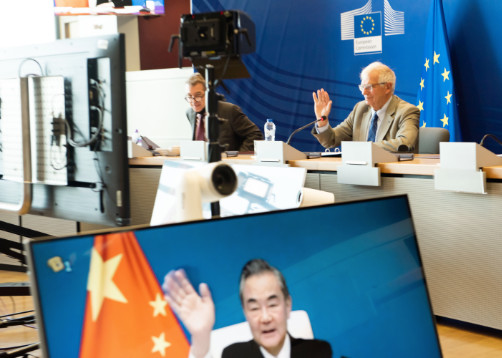
Japan
2021 marked the 20th anniversary of the EU–Japan Strategic Partnership. At the 27th EU–Japan Summit, held via videoconference on 27 May, leaders agreed to establish a Green Alliance, the first such bilateral initiative between the EU and a partner country (see also Chapter 2). Leaders also adopted a wide-ranging joint statement, which covered the three broad pillars of the summit’s discussions: global issues, bilateral relations and foreign and security policy.
India
The EU and India held a Leaders’ Meeting in Porto, Portugal, on 8 May, in hybrid format (in person and remotely) with the participation of all of the EU Member States. The meeting marked a further strengthening of the EU–India strategic partnership, building on the momentum provided by the last summit in June 2020. During the meeting, the two sides agreed a comprehensive Connectivity Partnership that covers cooperation in the digital, energy, transport and people-to-people sectors. It is rooted in support for the twin digital and green transitions. The EU and India today represent a combined market of 1.8 billion people, with a combined gross domestic product of €16.5 trillion per year. The new partnership therefore aims at pooling resources, norms and expertise to serve the needs of the next generation of sustainable and quality infrastructure. It includes joint work on standards and the regulatory environment and on concrete infrastructure projects. The EU– India Connectivity Partnership is the second such partnership, after the one signed with Japan in September 2019. (See the 'Trade' section above for information on the EU-India trade relationship.)
In preparation for the Leaders’ Meeting, the first meeting of the EU–India High-Level Dialogue on Climate Change was held on 28 April 2021.
Myanmar/Burma
The democratisation process in Myanmar/Burma ended in a violent military coup d’état on 1 February 2021, the day on which the new parliament under Aung San Suu Kyi was due to be sworn in. The EU called for the immediate release of all prisoners and for the restoration of the democratically elected authorities. While doubling its direct humanitarian assistance to the most vulnerable population, in line with international humanitarian principles, the EU immediately put on hold all development-assistance programmes and payments to the government and adopted sanctions against key individuals responsible for the coup, including the commander-in-chief and his deputy. The measures are a signal to the junta that their actions bear consequences. In parallel, the EU, along with its Member States, has been pursuing a robust diplomatic initiative, reaching out to all key stakeholders (the Association of South-East Asian Nations, China, India and Japan), in close coordination with its UK and US partners. The EU also stepped up its humanitarian assistance in response to the regional repercussions of the Myanmar/Burma crisis, supporting in particular the Rohingya refugees in Bangladesh and elsewhere in the broader region.
Afghanistan
Following the developments in Afghanistan over the summer, during the G20 meeting on Afghanistan in October the Commission announced a humanitarian support package worth €1 billion for the Afghan people and neighbouring countries, to address urgent needs while development assistance was suspended. The EU did not recognise the Taliban regime, and linked the level of its engagement to the fulfilment of key benchmarks.
When the Taliban took power in Afghanistan, most attention focused on the evacuation not only of EU citizens, but also of the 800 EU-affiliated Afghans who felt threatened and wished to leave the country. So far, through the consolidated efforts of the EU and its Member States, around 29 000 people have been brought to safety, including local staff, human-rights defenders and people that the EU has trained, such as female judges.
To respond to the protection needs of Afghan citizens, the Commission announced a support scheme for Afghans at risk. The scheme combines short-term measures (evacuations and safe passage) with medium-to-long-term measures, in particular resettlement, humanitarian admission and other complementary pathways, along with integration. EU Member States have made specific pledges for resettlement and humanitarian admission, which they will implement by the end of 2022 with EU financial support and the operational support of the European Union Agency for Asylum.
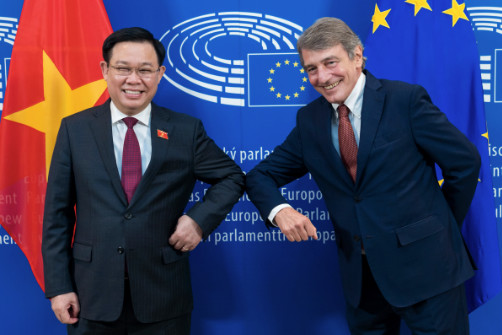
EU–UK Trade and Cooperation Agreement
2021 marked the beginning of a new relationship with the United Kingdom following its departure from the EU on 31 January 2020 and the end of the transition period on 31 December 2020. The EU’s objective is to establish a positive and stable relationship with the United Kingdom. The EU and the United Kingdom remain partners with shared values, and will have to tackle a number of global challenges side by side.
Four treaties now govern EU–UK relations. In 2021, the European Commission focused on ensuring their full and effective implementation and the operation of their governance structures.
The implementation of the Withdrawal Agreement advanced through numerous meetings of its bodies, in particular the Joint Committee and the thematic specialised committees. Significant efforts were dedicated to protecting citizens’ rights and particular attention was devoted to working with the United Kingdom on the implementation of the Protocol on Ireland / Northern Ireland. In response to stakeholders’ concerns, the Commission put forward practical solutions in the areas of food, plant and animal health, customs, the supply of medicines and engagement with Northern Irish authorities and stakeholders.
The implementation of the Trade and Cooperation Agreement started on 1 May 2021 and progressed primarily through inaugural meetings of the joint bodies established by the agreement, including the Partnership Council, the Trade Partnership Committee, specialised committees and trade specialised committees. Issues relating to fisheries and ensuring a level playing field required particular attention.
In October 2021, the Commission also began negotiations for a future EU–UK agreement on Gibraltar to abolish all physical checks and controls on people and goods circulating between Spain and Gibraltar, while preserving the Schengen area and the EU Single Market.
In parallel, the regulation on the Brexit Adjustment Reserve entered into force on 11 October 2021 to mitigate the effects of Brexit in the EU. It will see more than €5 billion disbursed to Member States to support those regions, sectors and communities in the EU hardest hit by the United Kingdom’s withdrawal.
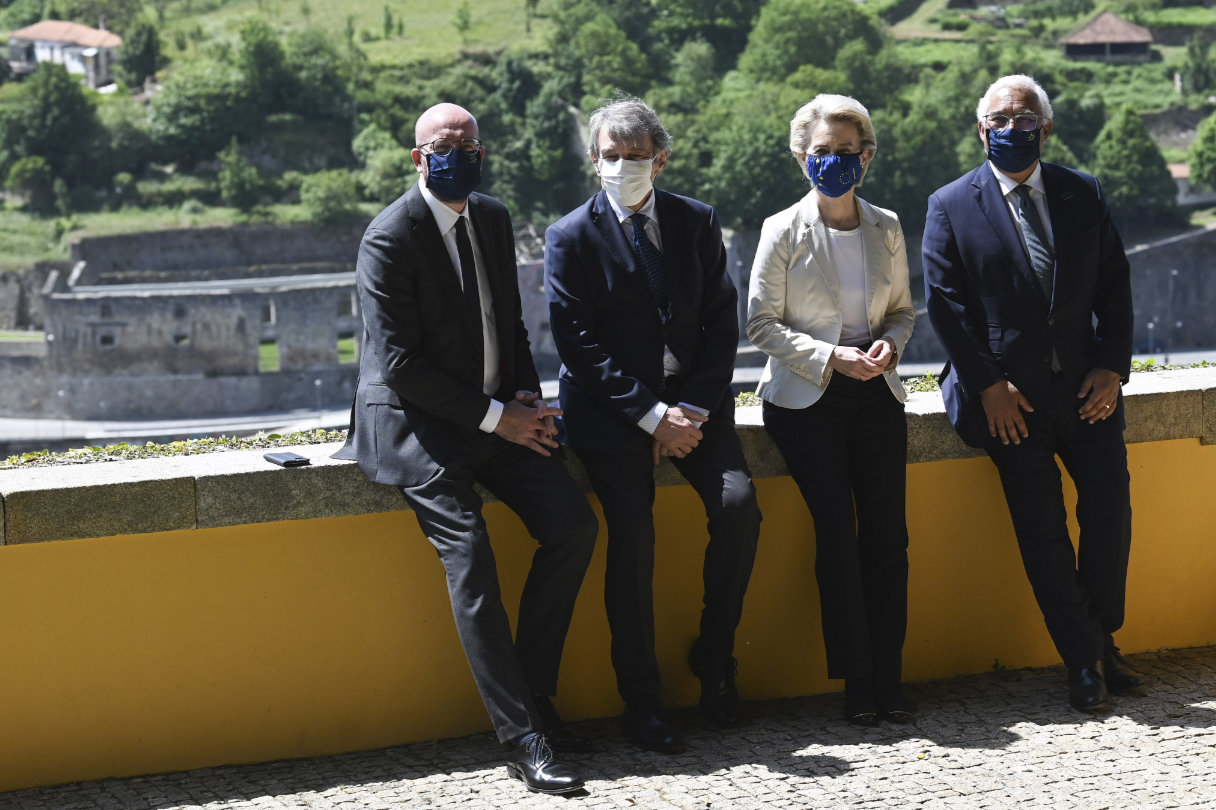
Institutional developments
Better Regulation
Continuing the efforts to improve EU lawmaking, in April the Commission adopted the 2021 Better Regulation communication. The communication presented a number of measures, including:
- simplifying feedback opportunities by consolidating public consultations into a single call for evidence via the Have Your Say portal;
- boosting transparency by improving access to the evidence behind every legislative proposal, including by improving the links between the various evidence registers and by setting up a common evidence register with the European Parliament and the Council of the European Union;
- implementing the 'one in one out' approach to ensure that any new burdens are offset by removing equivalent burdens in the same policy area;
- incorporating the UN Sustainable Development Goals into the Better Regulation framework and improving impact assessments through better analysis and reporting of key impacts, in particular those relating to the green and digital transitions and their socially just and fair dimension;
- integrating strategic foresight into the Better Regulation agenda.
The 2020 Annual Burden Survey, published in June, showed how EU legislation has been simplified in policy areas such as financial services, transport, taxation, customs and the environment. In November 2021, the Commission followed up on the Better Regulation communication with the publication of new Better Regulation guidelines and a new toolbox, which offer comprehensive guidance, key questions and concrete examples, with a set of 69 tools.
Strategic foresight
The 2021 Strategic Foresight Report, presented in September, identifies key global megatrends that will continue to affect the EU towards 2050: climate change and other environmental challenges; hyperconnectivity and technological transformations; pressure on democracy and values; and shifts in the global order and demography. It also identifies 10 areas in which the EU can strengthen its capacity and freedom to act. In addition, the Commission prepared a number of more highly focused foresight reports, including on defence and space industries, on European territories and on the future of jobs being 'green' jobs.
To develop foresight cooperation with Member States, the EU-wide Foresight Network was launched in April, and the first ministerial meeting was held in May. Finally, the updated Better Regulation toolbox includes a dedicated foresight tool for impact assessments and evaluations. The 2021 conference of the European Strategy and Policy Analysis System took place in November, co-hosted by the Parliament and the Commission. Over 2 days, the discussion focused on long-term global trends that will likely affect Europe, and the role of foresight in this endeavour to be better prepared to undergo transitions and face future shocks.
Institutional affairs
The agreement between the Parliament, the Council and the Commission on a mandatory transparency register entered into force on 1 July. The agreement expands the scope of the transparency register to the Council for the first time. In addition, it makes registration mandatory, and signatory institutions must now make the registration of interest representatives a precondition to lobbying.
The response to the COVID-19 pandemic and the related EU coordination work remained a top priority for both the Portuguese and Slovenian Council Presidencies. The Portuguese Presidency ensured the adoption of the revised recommendations for travel within and to the European Union. It also negotiated the legislation on the EU Digital COVID Certificate and ensured that it was adopted in time for the summer. The Slovenian Presidency followed up with a review of the lessons learnt from COVID-19, focusing on the cross-border impact of measures implemented in key areas, such as the Single Market.
The Parliament adopted many measures under its emergency procedure in response to the COVID-19 pandemic. In particular, at the request of the Commission, it addressed possible amendments on the EU Digital COVID Certificate directly in plenary, allowing the Parliament to conduct and conclude the interinstitutional negotiation in time for the summer, without compromising its democratic scrutiny and legislative role.
The Parliament continued to meet in a hybrid way (in person and remotely), both in committees and in plenary, for most of the year. In June it resumed its plenary sessions in Strasbourg. In November it introduced the mandatory use of the COVID certificate to access its premises, resuming activities with full physical presence, before reverting to hybrid meetings for the last sessions of the year. The Commission was physically present at all plenaries.
In September, the Parliament hosted the annual State of the Union address by Ursula von der Leyen, President of the Commission.
The Portuguese Presidency put recovery at the top of its agenda. In parallel, it ensured the finalisation and the formal approval of proposals on various sectoral acts under the current long-term budget. It facilitated the approval of the Own Resources Decision, which was essential to enable the European Commission to start borrowing for the recovery under NextGenerationEU. The first NextGenerationEU bond was also issued during the Portuguese Presidency, in June 2021.
The agreement on the European Climate Law was another highlight of its term. The Portuguese Presidency was furthermore instrumental in advancing the work on key proposals of the digital agenda, such as the Digital Services Act, the Digital Markets Act and the Data Governance Act. In addition, Portugal played a key role in the launch of the Conference on the Future of Europe, and organised a successful Social Summit in Porto.
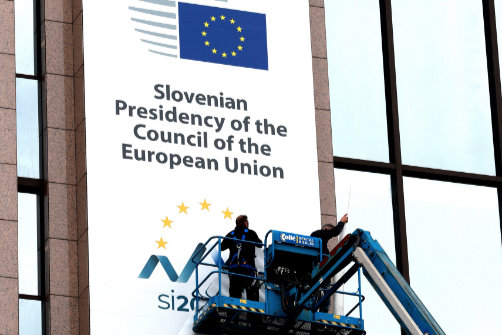
The Council Presidency passed from Portugal to Slovenia in July. Slovenia prioritised the adoption of the national recovery and resilience plans – essential in order to unlock financing under the Recovery and Resilience Facility – and ensured the adoption of dedicated conclusions on resilience against future crises. Slovenia also focused on the package of proposals to deliver the European Green Deal, while preparing the COP26 UN Climate Conference in Glasgow and the COP15 Biodiversity Conference. It was instrumental in advancing work on energy prices in a crisis context.
Slovenia continued work on the digital finance package, the Digital Markets Act and the Digital Services Act, and reached a political agreement on the Data Governance Act. Health was another key aspect of this presidency, with the agreement on the reinforced role for the European Medicines Agency and the renewal of the mandate of the European Centre for Disease Prevention and Control. During the Slovenian Presidency, the Conference on the Future of Europe entered a key phase of discussions with citizens.
Finally, Slovenia steered the discussions on Afghanistan, Belarus and the external aspects of migration, including financing. Great importance was also given to the EU’s engagement with partners through the preparation of several summits, including the EU–Western Balkans Summit.

European Economic and Social Committee and European Committee of the Regions
Both committees provided important and relevant contributions to the Commission by preparing opinions, among other means.
In particular, the European Economic and Social Committee adopted a resolution on the involvement of civil society in the national recovery and resilience plans, and the European Committee of the Regions presented the EU Annual Regional and Local Barometer. Both committees contributed actively to preparing the 2022 Commission Work Programme and the Conference on the Future of Europe.
Getting in touch with the EU
In person
All over the European Union there are hundreds of Europe Direct information centres. You can find the address of the centre nearest you at: https://europa.eu/european-union/contact_en
On the phone or by email
Europe Direct is a service that answers your questions about the European Union. You can contact this service:
— by freephone: 00 800 6 7 8 9 10 11 (certain operators may charge for these calls),
— at the following standard number: +32 22999696, or
— by email via: https://europa.eu/european-union/contact_en
Finding information about the EU
Online
Information about the European Union in all the official languages of the EU is available on the Europa website at: https://europa.eu/european-union/index_en
EU publications
You can download or order free and priced EU publications from: https://op.europa.eu/en/publications Multiple copies of free publications may be obtained by contacting Europe Direct or your local information centre (see https://europa.eu/european-union/contact_en).
EU law and related documents
For access to legal information from the EU, including all EU law since 1952 in all the official language versions, go to EUR-Lex at: https://eur-lex.europa.eu
Open data from the EU
The EU Open Data Portal (https://data.europa.eu/euodp/en) provides access to datasets from the EU. Data can be downloaded and reused for free, for both commercial and non-commercial purposes.
About
Identifiers
The EU in 2021 - General Report on the Activities of the European Union
PrintISBN 978-92-76-38940-8ISSN 1608-7321doi:10.2775/977534NA-AD-22-001-EN-C
PDFISBN 978-92-76-38912-5ISSN 1977-3374doi:10.2775/379018NA-AD-22-001-EN-N
HTMLISBN 978-92-76-38813-5ISSN 1977-3374doi:10.2775/094316NA-AD-22-001-EN-Q
An interactive version of this publication, containing links to online content, is available in PDF and HTML format: http://europa.eu/general-report/en
The EU in 2021 – General Report on the Activities of the European Union
European Commission
Directorate-General for Communication
Editorial Service & Targeted Outreach
1049 Brussels
BELGIUM
The EU in 2021 – General Report on the Activities of the European Union was adopted by the European Commission on 21 February 2022 under reference number C(2022) 959.

The Commission is not liable for any consequence stemming from the reuse of this publication.
Luxembourg: Publications Office of the European Union, 2022
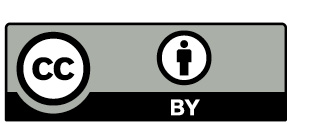
© European Union, 2022
The reuse policy of European Commission documents is implemented by Commission Decision 2011/833/EU of 12 December 2011 on the reuse of Commission documents (OJ L 330, 14.12.2011, p. 39).
Except otherwise noted, the reuse of this document is authorised under a Creative Commons Attribution 4.0 International (CC-BY 4.0) licence (https://creativecommons.org/licenses/by/4.0/). This means that reuse is allowed provided appropriate credit is given and any changes are indicated.
For any use or reproduction of elements that are not owned by the European Union, permission may need to be sought directly from the respective rightholders.
Credits
All photos © European Union unless otherwise stated.

